- Home
- Collections
- IDE J
- First 99 Years, The - An Historical Survey of the Napier Bowling Club
First 99 Years, The – An Historical Survey of the Napier Bowling Club
Page 1
THE FIRST NINETY-NINE YEARS
An Historical Survey of the Napier Bowling Club (Inc.)
(Founded 1887)
1. Introduction.
2. Origins of the Game in New Zealand.
3. The Founding of the Napier Bowling Club.
4. The Move to Dalton Street.
5. The New Century.
6. The Move to Nelson Crescent.
7. The First World War.
8. The Post World War 1 Years.
9. Liquor Problems.
10. The Sale of a Green.
11. Recovery.
12. The Second World War 2.
13 After World War 2.
14 The Search for New Premises.
15. The Founding of the Napier Women’s Bowling Club.
16. Further Extensions to the Greens.
17. The Struggle to get Good Greens.
18. Further Attempts to Secure Alternative Greens.
19. The Restorations of Liquor Sales.
20. Growth and Development.
21. Recent History.
22. Centennial Celebrations.
23. Appendices.
24. Index.

Page 2
THE FIRST NINETY-NINE YEARS
An Historical Survey of the Napier Bowling Club.
INTRODUCTION
With the approach of the Centenary of the Napier Bowling Club in 1987 it was decided at a committee meeting as far back as 1978 that to mark the occasion a history of the club should be written in time for publication before the celebrations. I undertook the task of researching the history when given assurance of support from members.
The Napier Bowling Club’s story is unique. It was the first bowling club in Hawke’s Bay. It has never been a big club. Membership seldom rose above one hundred but it has always had and an important influence on the game in this district. Many of its members were prominent citizens of the town so the club’s activities were closely associated with the early life of the town.
I wish to acknowledge help given to me in this work by Mr.Angus Hardie for nearly fifty years (he joined in 1937) a loyal member of the club who in his meticulous way read through the script and made valuable suggestions. I am also grateful to him for supplying much of the information in the appendices. Others who assisted were Mr. John Flett of the New Zealand Bowling Association for supplying early history of the game in New Zealand; the management of the Daily Telegraph for giving me a access to the library of former newspapers which included the Hawke’s Bay Herald; the director of the Hawke’s Bay Art Gallery and Museum for giving me access to old photographs and documents; Mr George Faulknor who so wisely kept old photographs which could so easily have been lost; and all club members who supplied information and advice when asked.
May this survey be read and serve as reminder to present members that they belong to a club which has always been noted for its good fellowship and friendly rivalry on and off the green.
Denis G. Revell.
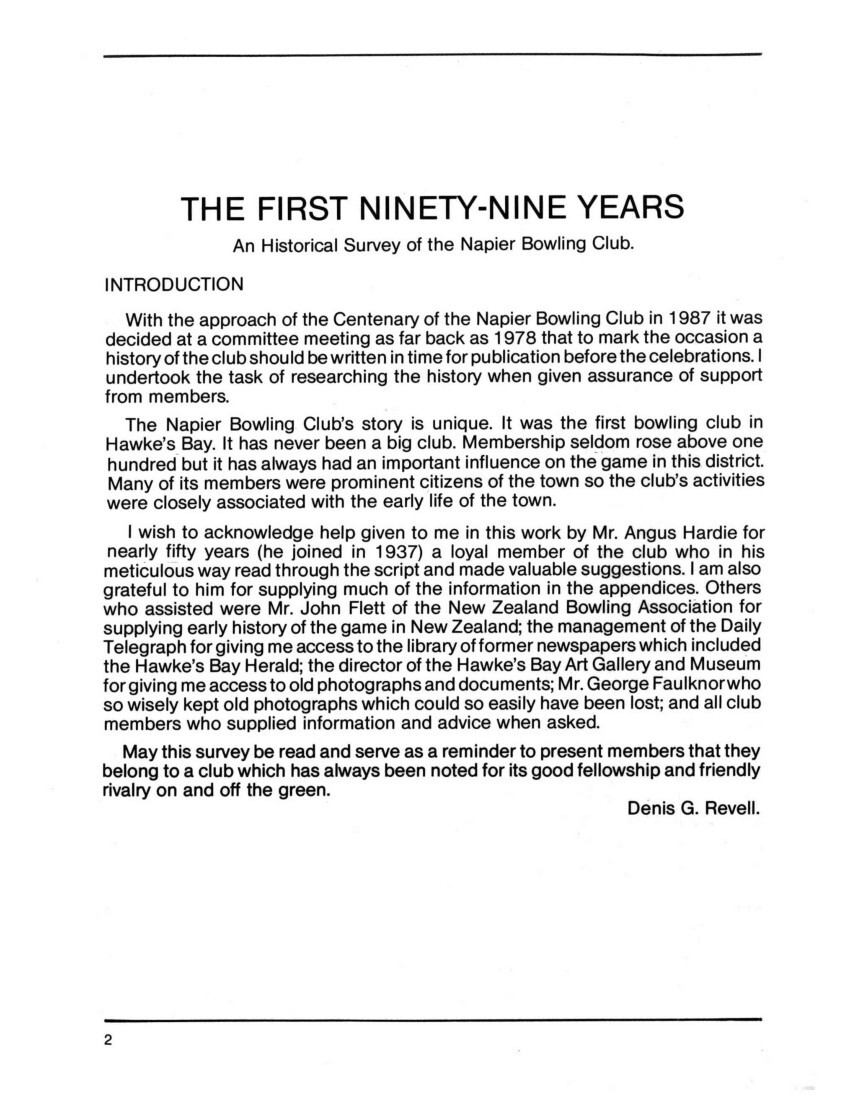
Page 3
THE FIRST NINETY-NINE YEARS
An Historical Survey of the Napier Bowling Club.
ORIGINS OF THE GAME IN NEW ZEALAND
Bowls was brought to New Zealand by the pioneers many of whom had played the game on the village greens of England and Scotland. Although the honour of being the first bowling club in New Zealand and indeed the Southern Hemisphere, belongs to Auckland (founded 1861) the game first came into prominence in Otago. The next eleven clubs, Dunedin 1871, Christchurch 1875, Milton 1878, Canterbury and Tuapeka 1883, Caledonian and Balclutha 1879, Roslyn 1883, Oamaru and Southland 1881 and Green Island 1885 were all in the South Island.
The New Zealand Bowling Association was formed in Dunedin in 1886. Thomas Callender of the Dunedin Club was the first president and George Capstick of the Caledonian Club its first secretary. Nine clubs competed at the first tournament held in Dunedin in 1887. It was to this association that Napier Bowling Club first affiliated.
Distances from Dunedin and the difficulty of travel by many clubs which were being formed in the North Island led to the formation of the Northern Bowling Association in April 1891. The Napier Club played a very significant role in the formation of the new body. In September 1889 the Napier secretary, John T.C. Cook was asked by his committee to write to all then known clubs in North Island seeking their support in the formation of a North Island Bowling Association.
At a meeting held in the Exchange Building in Wellington after an Easter Tournament in 1891 the clubs approved the formation of The Northern Bowling Association. All the North Island and Nelson and Marlborough affiliated. At first there were nine clubs representing between five and six hundred bowlers. The first tournament was held by the association on the Napier green at Easter 1892. Mr. T. Morrison was elected as vice-president.
The two associations continued to operate separately until 13 September 1913 when it was decided to amalgamate and thereby secure uniformity of control throughout the country. There was a long discussion on the association the Dominion of New Zealand Bowling Association. At the time there were 109 Clubs in the North Island, and 89 in the South Island. There was to be a further change in the name of the parent body body when in June 1931 there were 339 clubs with nearly 1600 members affiliated. By 1980 the number of clubs had increased to 636 with a membership of over 55,000.
With the formation of the Dominion of New Zealand Bowling Association in 1913 the country was divided into Centres. The Napier Club was included in East Coast Centre area. This Centre extended from north of Gisborne to as far south as Dannevirke. This organisation continued until 1933 when Gisborne-East Coast became a separate centre and the Hawke’s Bay Bowling Centre replaced the former East Coast Bowling Centre. Hawke’s Bay Centre now has control of all clubs from the south of Wairoa in the north to Norsewood in the south.
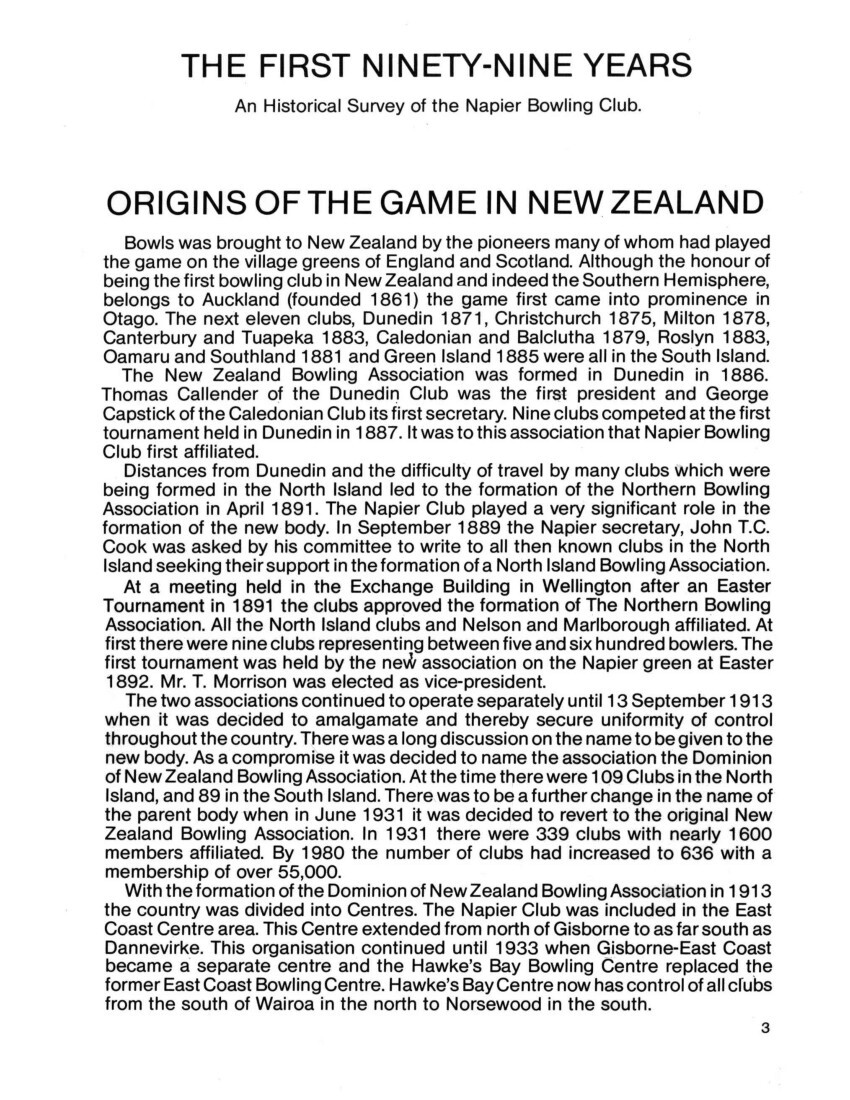
Page 4
THE FOUNDING OF THE NAPIER BOWLING CLUB
In September 1885 the newly formed Napier Recreation Ground Company laid down a sports ground for the use of the citizens of Napier. The property was situated at the western end of Carlyle Street near the present junction of Georges Drive and Thackeray Street. Provision was made for a bowling green of three rinks and was first used in October 1886.
On Wednesday 26 October 1887 the Hawke’s Bay Herald reported a meeting held at the Masonic Hotel the previous evening of gentleman interested in the formation of a bowling club. Mr. J.C. McVay, a prominent businesss [business] man, took the chair. Dr. T.H. Hitchings, the first doctor in the Napier district spoke of the physical and social advantages that would accrue from the formation of a bowling club. He moved a motion seconded by Mr. P. Dinwiddie ‘that a bowling club, to be known as the Napier Bowling Club, be formed’. He moved a motion seconded by Mr. P. Dinwiddie ‘that a bowling club, to be known as the Napier Bowling Club, be formed’. The motion was carried and the seventeen gentleman present gave in their names as members. In addition to Dr. Hitchings and Messrs McVay and Dinwiddie others to be original members were Messrs S. Palmer, G.H. Swann, T.W. Balfour, W.C. Yates, G. Prian, A. Stubbs, D. Guy, R. Williams, S. Luxford, J.G. Gilberd, S. Revans, H. C. Cornford, J. Holt, and J.T. Cook who became the first secretary. A sub-committee was formed to draft a set of rules, canvass for new members and arrange an interview with the Recreation Ground Company for terms of occupancy of the bowling green in Carlyle Street.
Thus the Napier Bowling Club became the first to be established in Hawke’s Bay. Other clubs to be formed in the district before the end of the century were Hastings with four rinks in 1890, Bluff Hill four rinks in 1894, and Dannevirke in 1895.
The sub-committee reported back to a meeting in November 1887. Arrangements were made with the Recreation Ground Company to rent three rinks for £20 per annum. The rules drafted were approved and the annual subscription was fixed at one guinea. The following were elected as the first officers of the club:-
President: Dr. T.H. Hitchings.
Vice-President: Mr T.W. Balfour
Secretary-Treasurer: Mr J.T.C. Cook
Committee: Messrs J. Holt, A. Cornford, D. Guy and P. Dinwiddie.
It was decided that the Club’s colours would be cerise and white.
The first matches, ‘a single-handed tournament’, were held on the Carlyle Street green on the 9th November 1887. For this tournament the rinks were chalked off at the right length, ‘beyond the chalk lines be reckoned the ditch’. At a meeting in February 1888 the secretary was instructed to write to the Company to get permission to cut a ditch and make a bank at each end of the green
Photo caption – Dr. Thos. Hitchings. 1st President 1887-89.
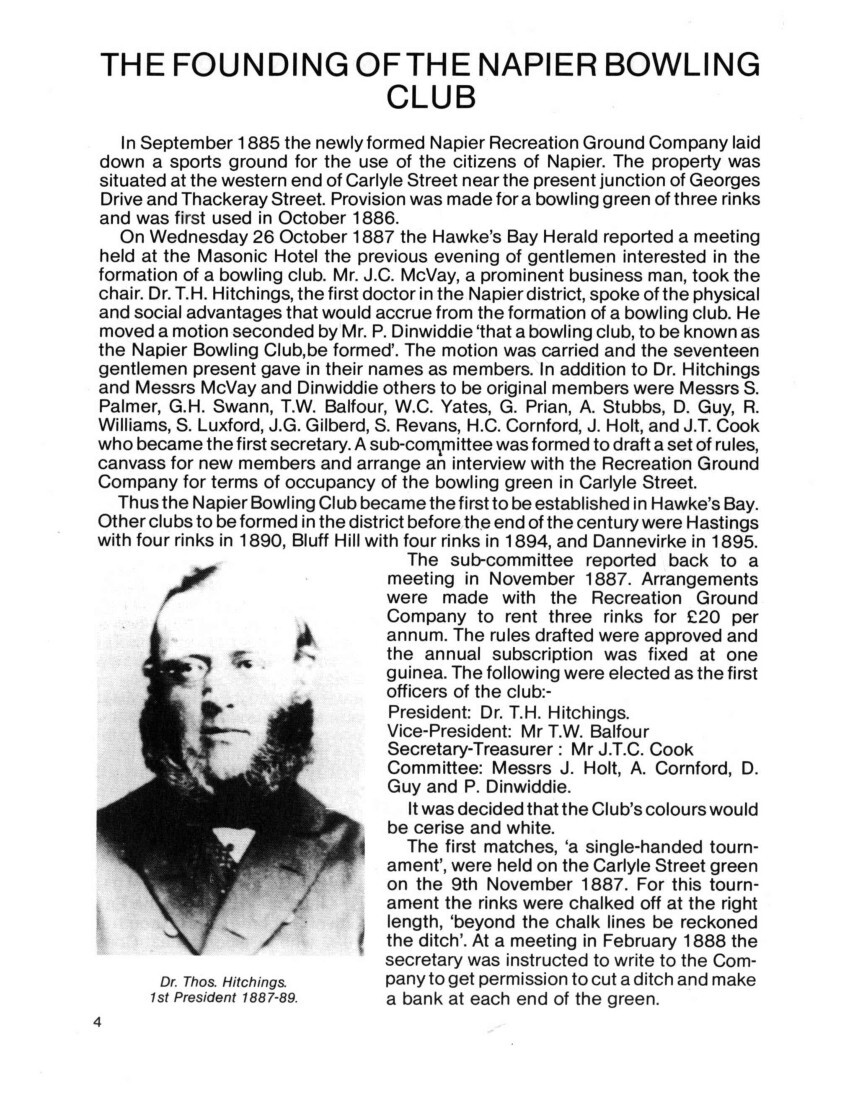
Page 5
During this early period in the Club’s history matches were reported regularly in the local newspapers in a detailed and chatty style not a feature of press reporting today.
Typical of reports in the Herald in the early nineties was the following when a match was held at the green. ‘A bowling match was played yesterday on bowling green at the Recreation Ground, and excited a large amount of interest between players and spectators. Two rinks were formed, one of eight and the other of six players. The game commenced at 11.30am and continued until 1 pm when an adjournment was made for luncheon, which was spread ‘al fresco’ under the willows, the providore being Mr. R. Smith of the Masonic Hotel. At 2.30pm the games were resumed and finally finished at 4.20pm. The play was most exciting to those engaged in it’.
There were two daily newspapers published in Napier at the end of last century. The Hawke’s Bay Herald-Tribune with headquarters in Hastings and the Daily Telegraph founded in 1871. Both gave plenty of space for reports on bowls in the district.
By the first annual meeting, 30 August 1888, the club has forty financial members and showed a credit balance of £6-5-6. No away matches were played but ‘enjoyable matches’ such as seniors against juniors, Scotsmen against the club, and the President’s team against the Vice-President’s team were a feature of club activities in the early days. At this meeting which was again held in the Masonic Hotel, country members who lived more than ten miles from the green were given a reduced subscription. A sub-committee was set up to report on the erection of a pavilion to cost not more than £30. To meet the cost it was decided to issue debentures of £1 each. This became a successful method of financing club capital projects throughout its history. The building was designed by Mr H.C.A. Wundrum, a tender of £27 by Mr. Thos. Exeter for the immediate erection of the pavilion was accepted and the club took it over on the 1st December, 1888. Parts of this first pavilion are still in the present one. The state of the playing surface was an early concern of the committee. At the second annual meeting a new rule ‘that in future all players must play in slippers’ was introduced.
Photo caption – H.C.A. Wundrum. Architect of Club Pavilion. Napier Bowling Club, 1888.

Page 6
THE MOVE TO DALTON STREET
In 1888 relationships with the Recreation Ground Company became rather strained. The club having made improvements to the ground applied to the company for a reduction of rent to £15 per annum but it was declined. When a further attempt to get rent reduced in September 1889 was unsuccessful, members realised the importance of owning their property. Investigations were made and on the Borough Council for a portion of section 360 – a little over half an acre in Dalton Street. The Council accepted the club’s offer and the transfer to the new premises began at once. The 1890 annual meeting gave approval to borrow money to purchase the land, remove the pavilion and meet all ‘needed expenses’. £50 was borrowed from the Bank of New Zealand for seven years.
The green of seven rinks with a smaller one next to it be used by the ladies for croquet, was opened on the 4 October 1890 and the club affiliated with New Zealand Bowling Association in Dunedin.
In July 1891 Mr. J. Dinwiddie arranged for the new green to be completed with turf donated by Mr. H.S. Tiffen from his property in Greenmeadows. A contract was let, the turf was carefully cut and transported by horse and cart to Dalton Street. This surface must have been satisfactory as visitors to the Northern Bowling Association Tournament held on the green at Easter 1892 praised the standard of the green and the amenities. It was decided to hold the 1894 tournament at Napier again.
Photo caption – Napier Bowling Club, 1891.
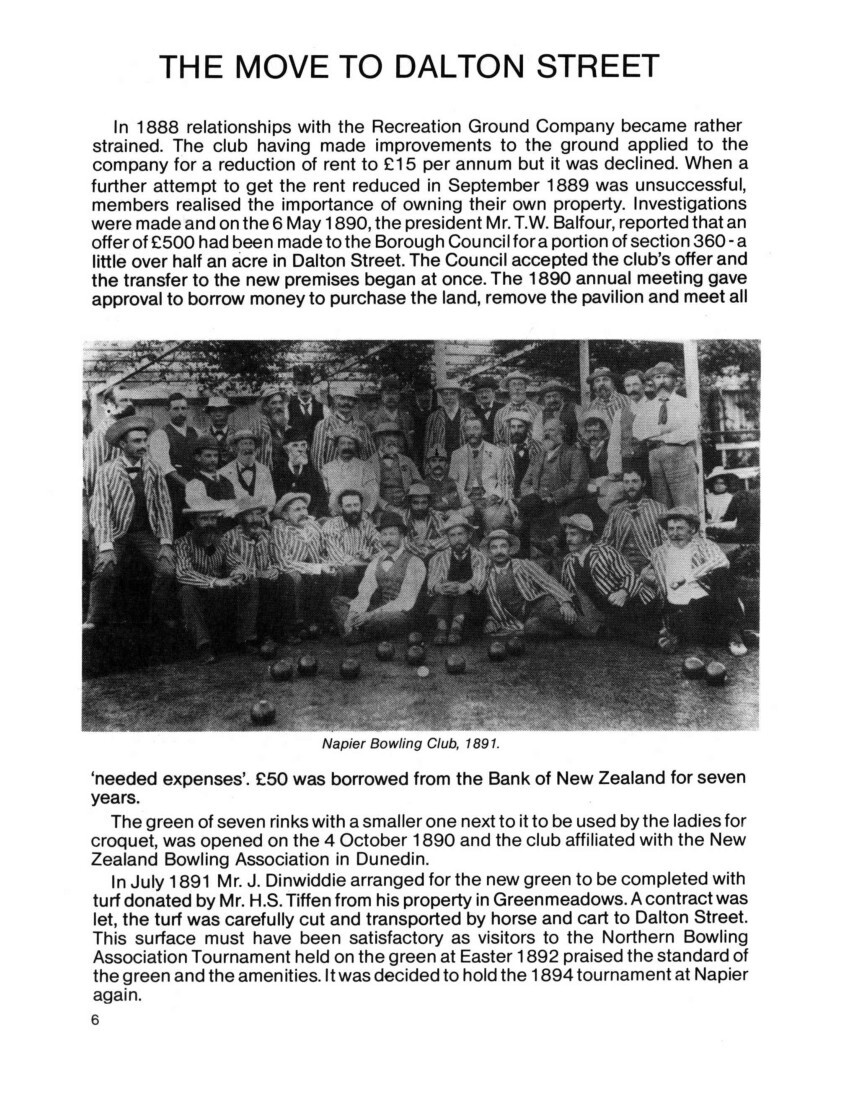
Page 7
In January 1893 Auckland was to host the annual Northern Association Tournament but regrettably there was no play possible because of bad weather. The Napier team had travelled north by sea accompanied by the Wellington and Gisborne teams. Because of the cancellation the teams returned early and matches were arranged at Gisborne on the way home. The teams sailed on the ‘TeAnau’, a coastal vessel which plied the east coast ports between Auckland and Wellington. A report in the Herald on the 16 January 1893 showed the good fellowship among bowlers of the time. ‘As the ‘TeAnau’ pulled out from the Auckland wharf three hearty cheers were called by the Napier team for the Auckland bowlers which were lustily returned by those on shore.’ After the friendly matches in Gisborne teams adjourned to the Albion Hotel where the visitors were entertained at dinner by the Gisborne club, The ‘TeAnau’ left Gisborne at midnight reaching Napier next morning.
Throughout the 1890’s the Napier Bowling Club was an important place for social gatherings as well as closely contested bowling matches. The Herald reported on the 12th of November 1892 that ‘the bowling green presented a most animated appearance on Saturday afternoon, when a crowd of spectators were present, including probably sixty or seventy ladies, who watched the play with great interest. An additional attraction was provided by the club on this occasion in the shape of a delightful open-air concert by the Truda Brothers, who played a selection of operatic and other airs, to the intense enjoyment of all present.’
At the end of January 1893, four rinks were invited by the new Hastings club to attend the opening of their new green. The surface could not have been of very high standard as it was reported that the rink play resolved itself into a ‘steeplechase meeting’. The ground had been low and hurdles erected had to be removed. Napier won all matches, hospitality was appreciated, and events finished in time for the team to catch the 5pm train back to Napier. The team was thoroughly pleased with the days proceedings.
During the vice-regal visit to the town in March 1893 to open the new Glasgow Wharf, the then Governor of the Colony, Lord Glasgow, visited the green for about twenty minutes and was greatly interested in the proceedings.
In his annual report 1893-4 the president referred to the death of Dr. T.H. Hitchings, the first president and one of the founders of the club. A photograph of the doctor and his walking stick presented to the club in 1905 have an honoured place on the wall of the upstairs room of the present pavilion. The Doctor came to Napier in 1856 and set up his surgery in Faraday Street which became known for many years as ‘Hitchings Gully’. He was a public spirited man and when Hawke’s Bay became a separate province in 1859 he became one of the three Napier town representatives on the Provincial Council. He served until 1867. Dr. Hitchings was a character, iracscible [irascible] but kindly. He was a very good athlete and a fine musician.
By the end of 1893 the club’s strength had reached 118 members and it was becoming difficult to cater for so many players on the green in Dalton Street. It was at this stage that a group of members living on the hill secured a section in Thompson Road for the establishment of a new club with four rinks. Thus the Bluff Hill Bowling Club came into operation in 1894. The club was to move to its present site in Lighthouse Road in 1938.
The Northern Association Tournament in 1894 held on the Napier green was an outstanding success. Teams from Auckland, Gisborne, Ponsonby, Palmerston
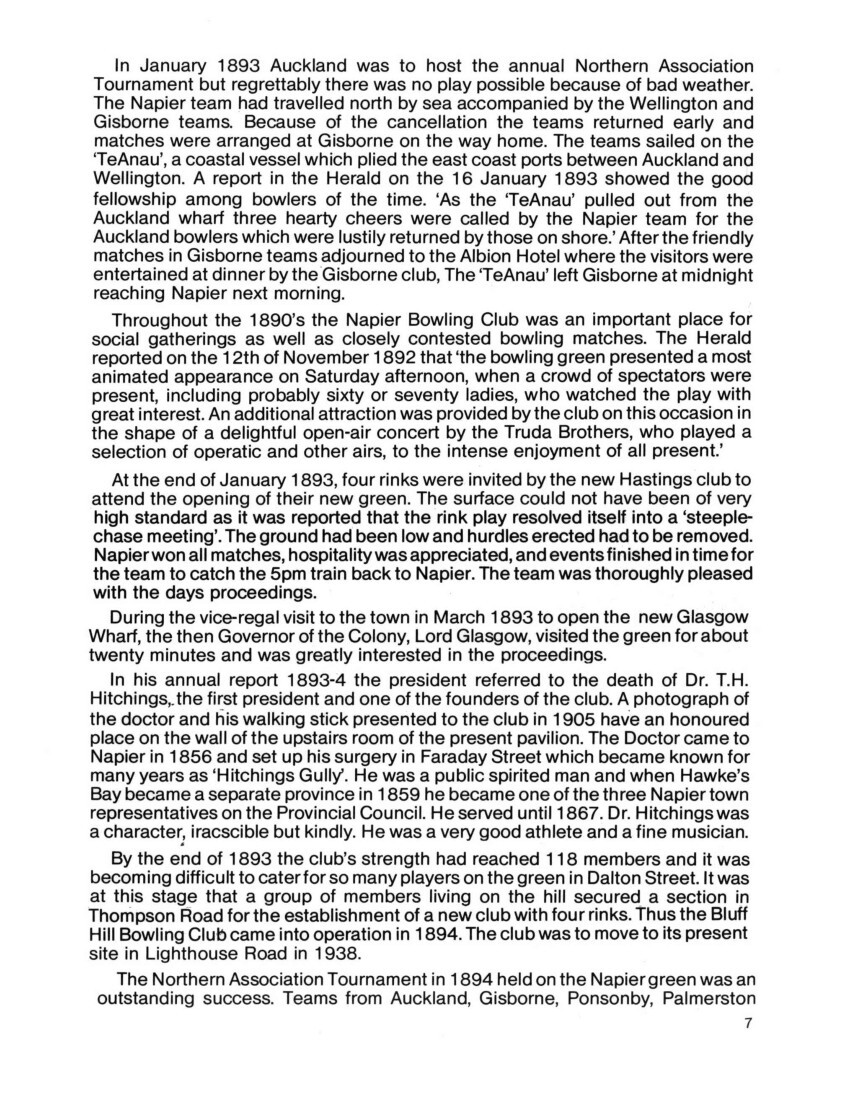
Page 8
North, Wanganui and Wellington were present. The Napier club won the championship pairs. The hospitality was of a very high standard. A special dinner was held at the Masonic Hotel and a smoke concert in the Theatre Royal was a great success. The pavilion had been enlarged for the occasion so that refreshments could be served on the green.
Until 1896 prizes usually in the form of cups and medals were presented by individual members for specified competitions but it became an embarrasment [embarrassment] to the committee with members vying with each other for the honour of making presentations. At a special meeting Mr. J.B. Fielder moved ‘that all trophies in future be supplied by the club and that any member wishing to contribute may do so on application to the committee’. The motion was carried.
Mr. J.P. Smith, who was later to become an authority on the establishment and maintenance of greens was appointed full time greenkeeper in September 1896 with a salary of £52 per annum. He was to serve the club well as a bowler of ability and a first class greenkeeper until he left to become a member of the Port Ahuriri club. It was he who left money in his will for the founding of the J.P. Smith Citizens’ Bowling Club which later became the Marewa Bowling Club.
Photo caption – “Smile please”. The Opening of the 1898-99 Season.
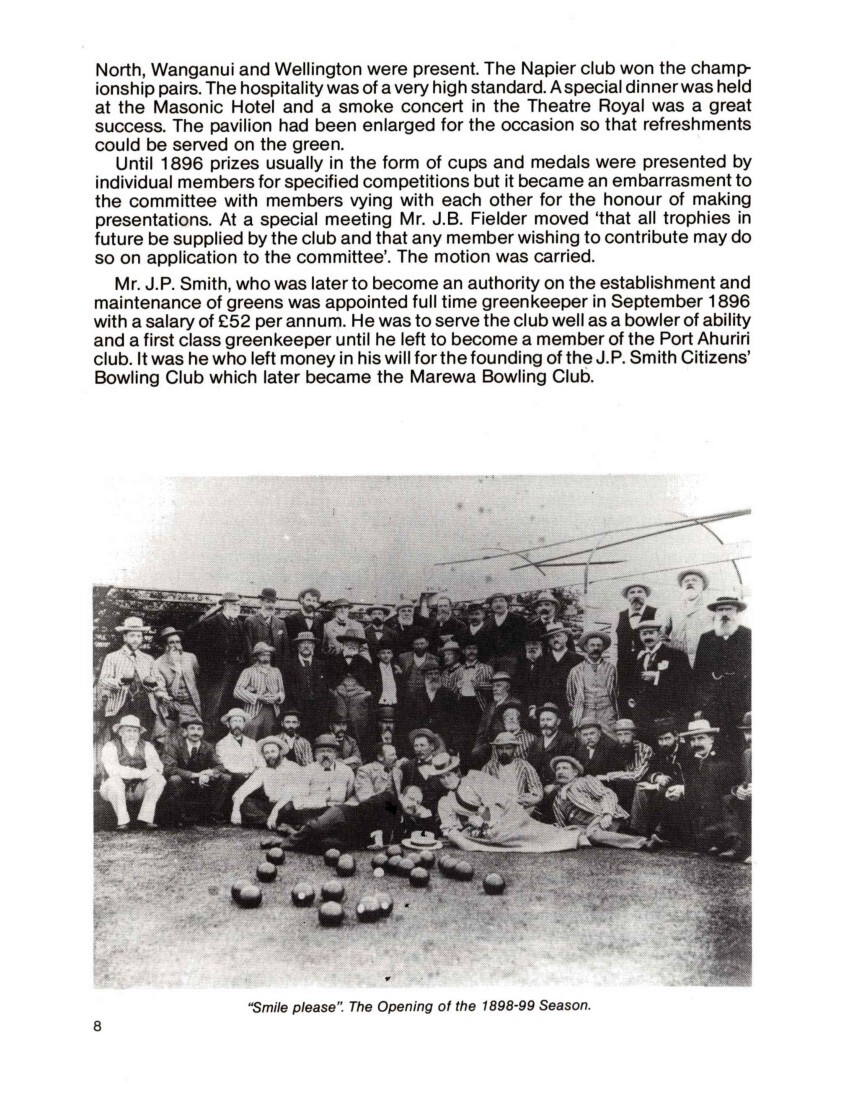
Page 9
THE NEW CENTURY
There is no record of any special tournaments to celebrate the entry into the 20th century. In 1900 the club for the first time was free of debt. It was in this year that the club was registered under the Unclassified Societies Act 1895 and since has been the Napier Bowling Club (Incorporated). A new set of rules was drawn up and adopted.
In those days bowls were made of wood. The modern plastic bowl did not come into general use until the 1930’s. With the wooden bowls a player could ‘doctor’ them to alter the bias. With the increase of competitions the Northern Association introduced testing of bowls. The first bowls from Napier were sent by train in 1904 for testing at Wellington.
After the formation of the Bluff Hill and Hastings clubs annual pennant matches were arranged to be played for a handsome silk banner but eventually it was found necesary [necessary] to obtain a trophy not so likely to wear out. Mr. J.B. Fielder took the matter in hand and procured from Mr. George Tutill of London a very handsome shield of oxidised silver, mounted on English oak with small silver shields on which to record the name of the winning club each year. The shield was designated the Challenge Shield and arrived in Napier 31 January, 1902.
By 1905 the existing pavilion was too small for the increasing membership. At the annual meeting the matter of building a new one was discussed but action was postponed ‘for a year. In June 1906 plans drawn by Mr. H.C.A. Wundrum who had planned the first building, were approved and tenders were called. Mr. W. Ward’s tender of £312 was accepted. The building was financed by the sale of £1 debentures. In addition an entrance fee of £1 was implemented for new members. Construction of the pavilion which contained parts of the old one began soon after the tender was accepted and was completed in time for the opening of the 1906-7 season.
During the early years of the century the club had many skilful bowlers who not only dominated club competitons [competitions] but were highly regarded at national level. At the
Photo caption – Looking West from the pavilion in Dalton Street. The church to the right is St. Patricks church, destroyed by fire, 1981. At right centre the home of F.J. Tiffen later the Arcadia Boarding House demolished in the 1970’s.
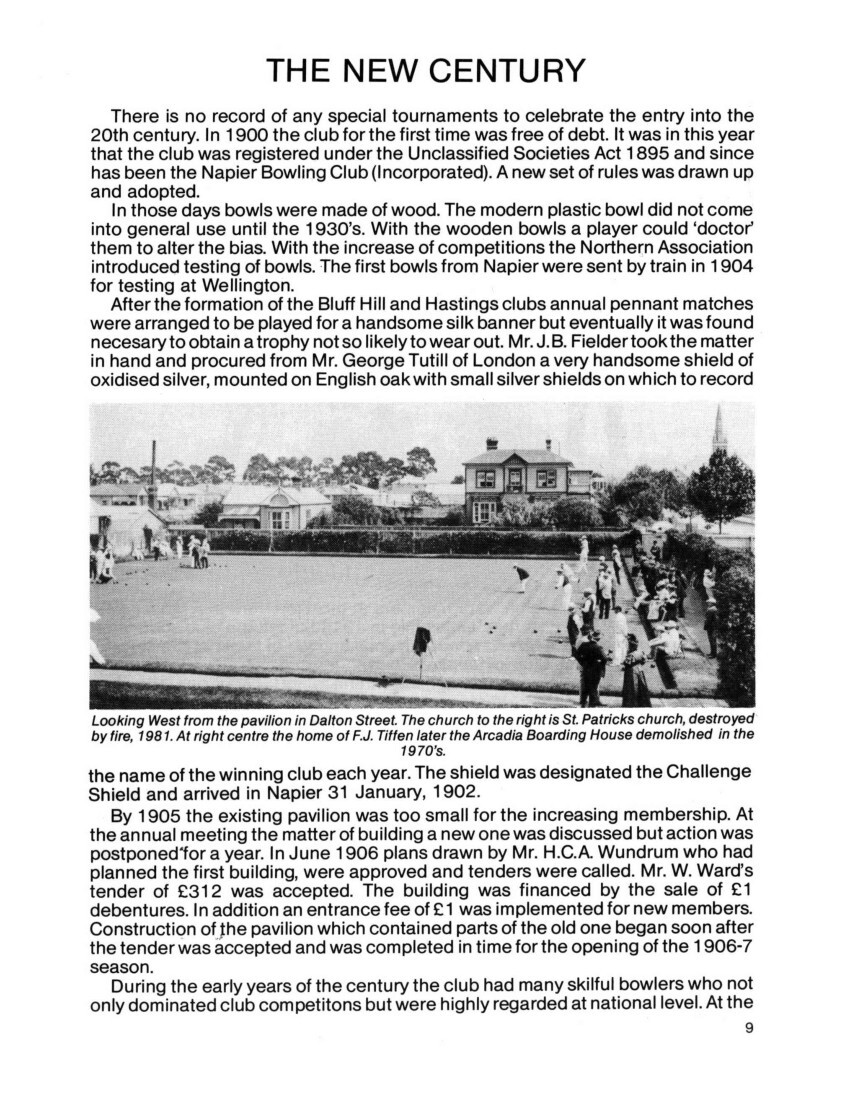
Page 10
Northern Tournament in Napier 1909 H. Bull skipped his team of R. Holt, A. E. Wrightson, and J. P. Smith to win the Open Fours. Indeed Bull was to be one of the top players in the district for over twenty years. He was Singles Champion of the club on eight occasions. Harry Bull was an accountant in the town. He was a keen yachtsman on the Inner Harbour before the 1931 Earthquake. Bull was a small man but he must have been a mighty bowler.
Several ministers of religion were members at this time. Rev. J. A. Asher was president in 1905-6. He won the Singles title in 1914 but left the club soon after with others who were concerned about the consumption of liquor at the club, to form the Wairere Bowling Club in Kennedy Road. When that club moved to Nuffield Avenue the old green became part of the Intermediate School grounds. The Reverends C. L. Luke and R. Hayward were also members about the same time. Their presence probably accounts for a resolution passed at the 1906 annual meeting allowing the playing of cards but that ‘gambling be strictly prohibited’.
THE MOVE TO NELSON CRESCENT
Mr. J. P. Williamson, the president in 1908, reported at the annual meeting that his committee was considering a move to newly reclaimed land beyond the railway line. The first sections offered to the club were situated on the corner of Kennedy Road and Owen Street but were passed over because there was room for only one green but a second site fronting Faulknor Street could have been leased from the Napier Harbour Board. These sections were near where the Napier Intermediate School grounds are today. Another group of sections were available on the corner of Jull Street and Carnell Street. These were just over an acre and were available at £600 per acre. All sections would have had easy access but
Photo caption – Winners of Northern Bowling Association Champion Fours. January 1909, at Napier. H. Bull (Skip), J.P. Smith, A.W. Wrightson, R. Holt.
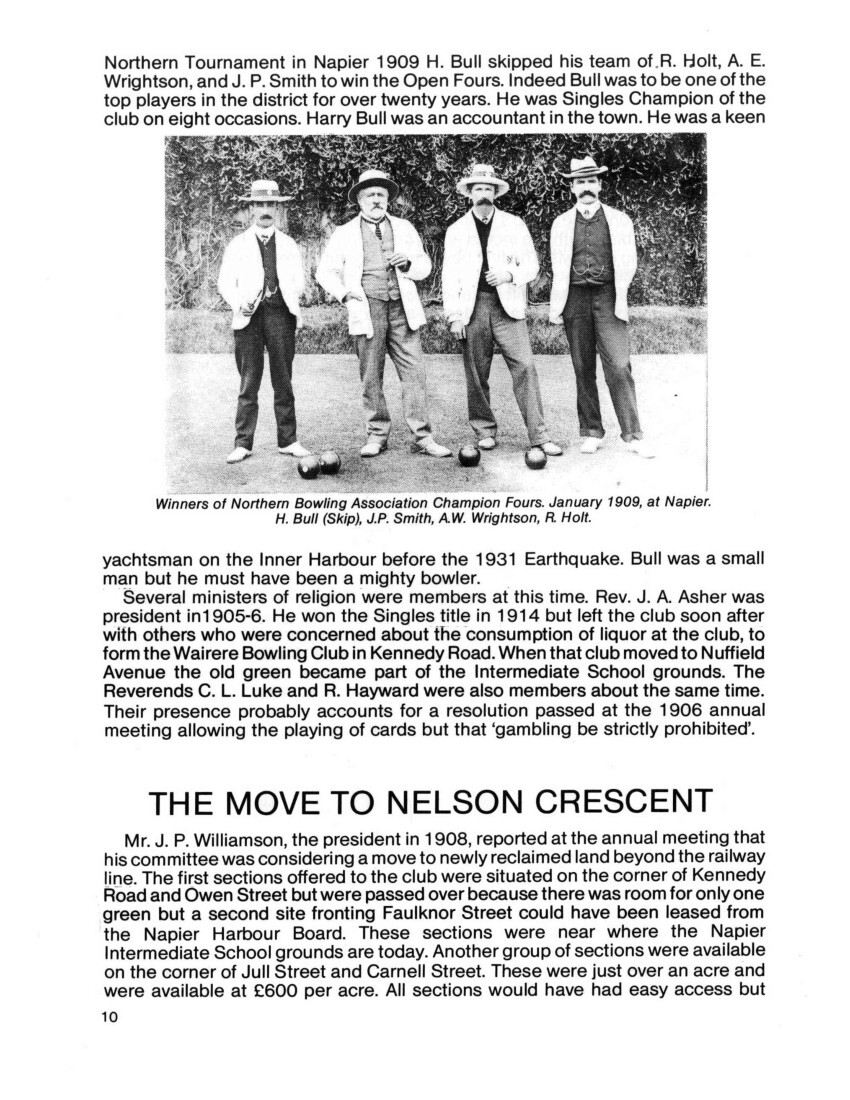
Page 11
experts said that finding artesian water for the greens could not be guaranteed.
The proposals were debated at length but because of recent expenditure on the pavilion and the club already carrying a mortgage of £600 and £250 in debentures the meeting decided it would be wise to defer moving. It was to be 1911 before the matter was brought up again. In the meantime there was much activity at the club. In January 1909, the minutes of the committee first made reference to the ‘library’. No books were ever issued. The ‘library’ was the club’s cover for the sale of liquor. At the meeting it was decided to sell tickets in books of 5 or 10 at half a crown and 5 shillings each for refreshments. It was also at this meeting that the first telephone was installed.
In 1910 Mr. William Hodgson, who had been secretary since 1891 left Napier to live in Melbourne. From 1884 to 1905 he was the Borough Council’s Receiver of Rates and the Registrar of Electors. At a special meeting on the 25th September at which he was farewelled grateful members presented him with a full gold sovereign case in recognition of his long and faithful service to the club. Mr. A. J. Woodhouse was appointed secretary.
The club colours were changed in 1911. Royal blue and gold were chosen and registered with the Northern Association. In the same year classes of membership were changed. In future there were to be ordinary or full members with a top limit of 100, life members voted at a general meeting and visiting members limited to 10.
The new ground issue came up again in 1911. Facilities at Dalton Street were stretched to their maximum. A sub-committee of Messrs R. Holt, M. Treston, P. Smart, and G.C. Fletcher was appointed to negotiate with Messrs McGill and
Photo captions –
J.B. Fielder and friends at the green in Dalton Street, 1910.
William Hodgson, Secretary 1891-1910.
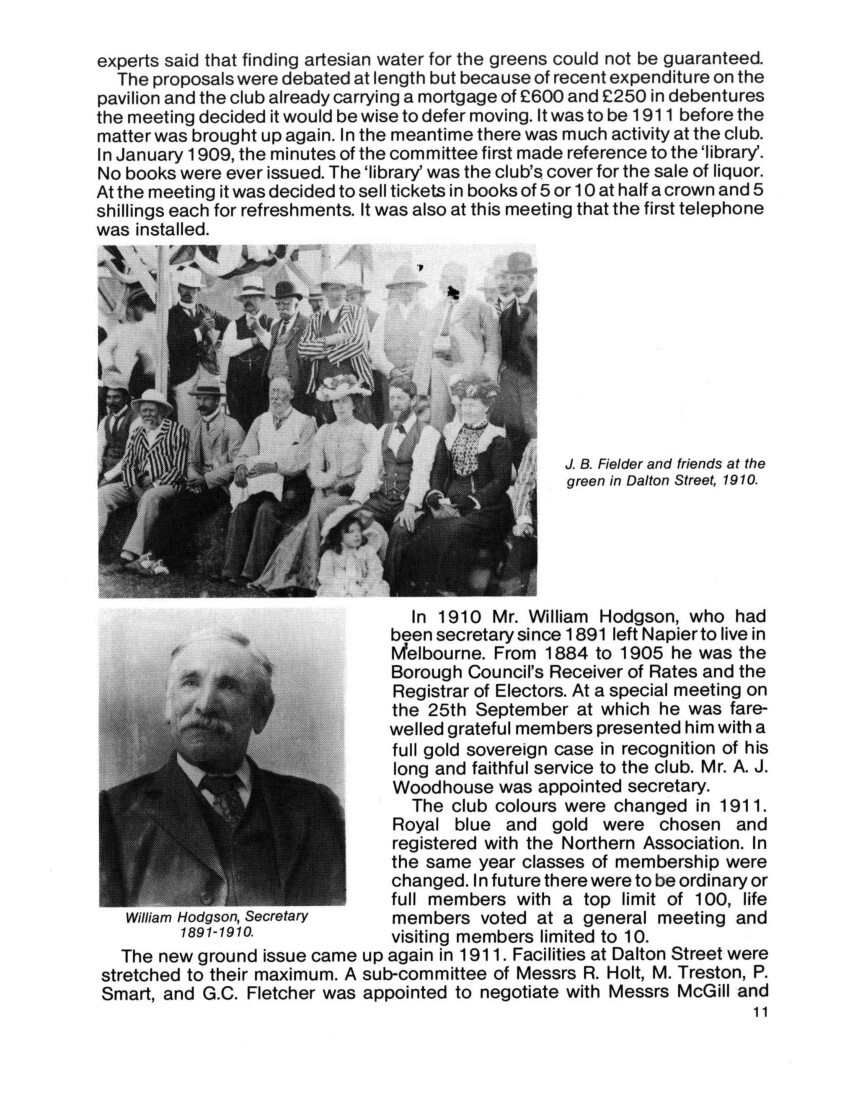
Page 12
Sweetapple for the purchase of land recently reclaimed near Nelson Park. At the 1913 annual meeting approval was given to purchase suitable sections in Nelson Crescent. Finally sections 616 and 617 were bought for £1075 from Messrs Gilberd & Co. and Robert McGill. Possession date was given at 30 April 1915. In addition part of section 614 approximately one eighth of an acre was bought for £100. To finance the new property a sub-committee of Messrs W. C. Yates, K. Beecham and F. C Williams was set up to find a buyer for the Dalton Street land then valued at £1255. In November 1913 the property was sold to Dr. W. W. Moore for £1600 and the club retained the right to remove the pavilion from the site. In December 1913 Messrs Holt and Beecham arranged the fencing of a the new property and in February the next year employed Mr. K. Benson at £3-5-0 a week and a guaranteed contract of two years work to lay out the greens and surroundings. Black soil was purchased from Hukarere School for two shillings a dray load and Mr. J. Griffin delivered it to the site.
The Napier Bowling Club had always had a very close association with the Gisborne Bowling Club so it was not surprising when Gisborne sought advice from Napier on the introduction of an inter-club competition for a handsome cup presented by Mr. E. W. Burton of Gisborne. The Napier Club recommended a tournament to be held at Easter, the Gisborne people agreed and the first Burton Cup Tournament was held at Easter 1910. This tournament is still held at Easter and is regarded as one of the major ones in the country. Napier sent a team to the first tournament and in 1913 A. E. Wrightson (skip), R. Quin, E. Northcroft, and S. J. Dyer were successful in winning the handsome trophy for the first time by a Napier team.
In February 1914 an attempt was made to sell the pavilion as it was in Dalton Street but there were no offers. As the club was badly in need of money to continue work on the new greens a mortgage was raised on the pavilion. It was at the annual
Photo caption – Winners of the Burton Cup (Gisborne), Easter 1913. S.J. Dyer (Lead), E. Northcroft (Two), R. Quin (No. 3), A.E. Wrightson (Skip).
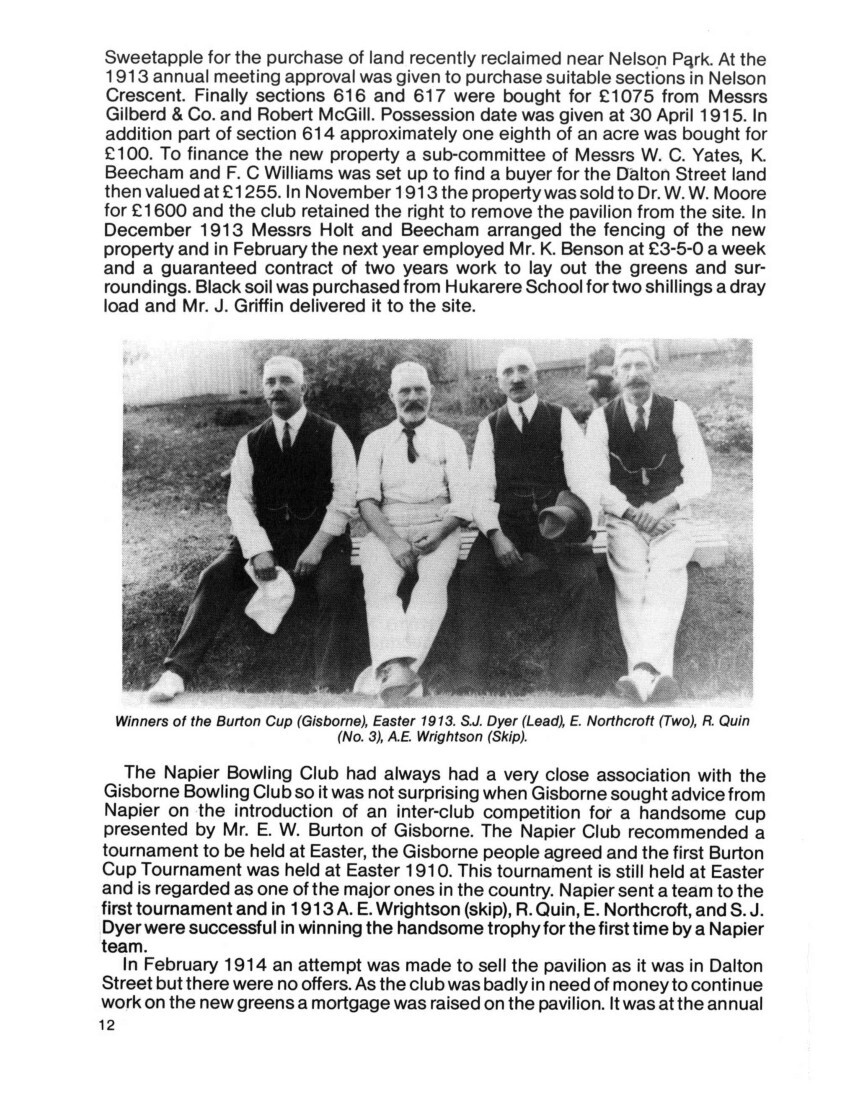
Page 13
meeting in 1915 that the decision was made on the advice of Mr. A. E. Williams to remove the pavilion and erect it on the new property. The building was officially opened on the present site on the 31st October 1915 by Mr. J. Vigor Brown M.P. The town clerk and members of the Napier Borough Council were also present. To complete the project a further £600 at 5% in debentures had to be raised.
In the years leading up to the first world war H. Bull continued to be the outstanding player in the club. However F. C. Williams 1911, W. Letham 1912, and J. A. Asher 1914 were able to defeat him in the club championship singles.
THE FIRST WORLD WAR
At the August meeting of the executive in 1914 the outbreak of war was recorded by Mr. P. J. Bear the club secretary. ‘The president, Mr. W. C. Yates, made some patriotic remarks and the members rose and sang patriotic songs. The meeting closed with the singing of the national anthem.’ Little were members, in their burst of patriotism aware that events in the next five years would so dramatically change the lives of millions of people throughout the world.
In the first season at the new green there were water problems. The Council’s water station in Dalton Street could no longer adequately supply the needs of Napier’s expansion on the recently reclaimed land in Napier South. With the increasing cost and lack of supply from the Council the club committee employed Mr. W. J. Burden to sink an artesian bore. Regrettably the flow was poor and in September 1915 the club returned to the borough supply. It was in connection with this water reticulation that the name Pirie was first recorded in the club records.
Photo caption – Pavilion on new premises, Nelson Crescent. Opening Day 1917.
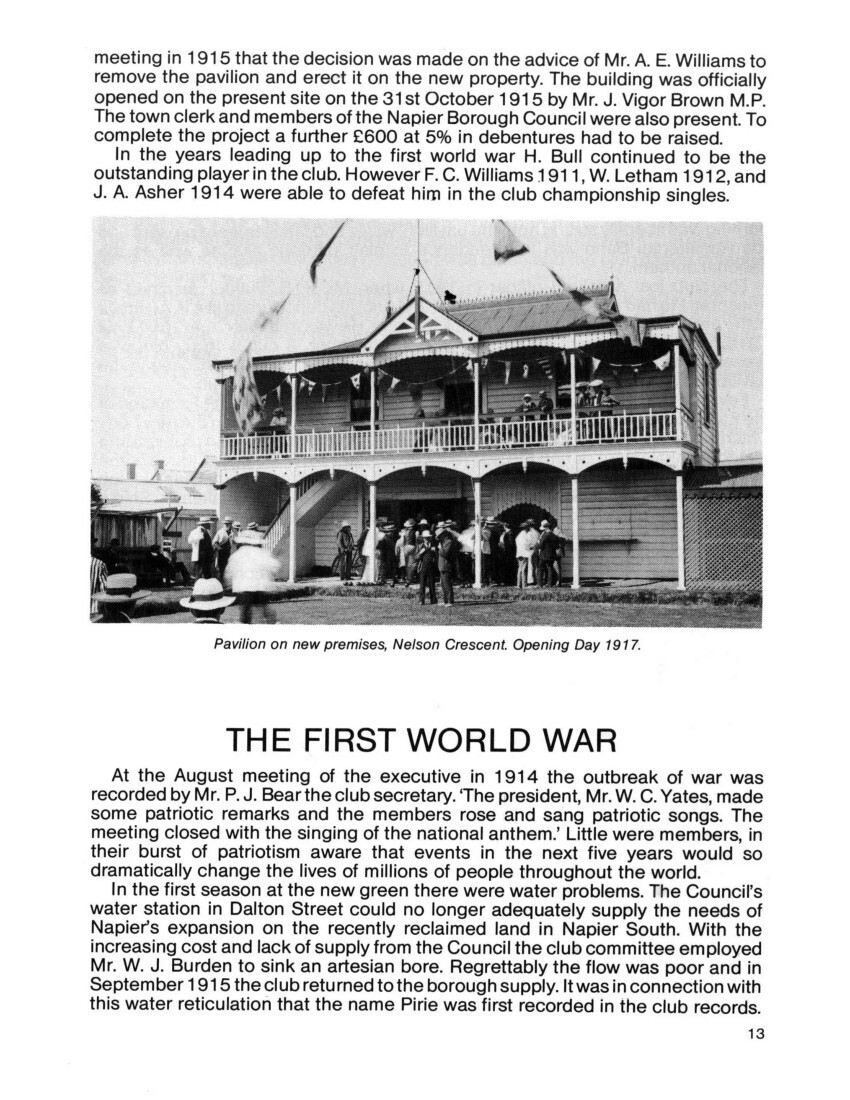
Page 14
From 1915 until 1971 the Pirie family was prominent in almost all activities associated with the club.
There was an attempt without success to get Sunday play on the green in Dalton Street. Another attempt was made in 1916 at Nelson Crescent. When Mr. M. Treston, a prominent member spoke against it at a special general meeting in January, members decided that it would not be in the best interest of the club to the club to play Sunday bowels. However during World War 1 winter bowls were introduced. In 1917 official approval was given to play on Wednesdays and Saturdays.
The opening of the 1917-18 season must have been spectacular. Patriotic bunting was liberally strung from the pavilion, wives and families were present and the Regimental Band was in attendance to play ‘patriotic airs’ as well as the national anthem.
The club lost a valued officer in 1915 when Mr. J.B. Fielder resigned as treasurer. He had joined the club in 1890 and until his departure to live in Australia at the end of World War 1 he was a keen club man. He was treasurer from 1891 until 1915. On his retirement he was made a life member. A cup won by him was presented to the club by his daughter in 1977 and now is in a glass case in the pavilion. It serves as reminder of his great contribution to the club.
Few inter-club matches were played during the war and since the formation of the East Coast Centre in 1913 there were problems of administrating the new body which extended from Woodville to the East Cape. Travel was the main problem and restricted movement during the war reduced contact between clubs. Much of the administration of the East Coast Centre was left to the Officers of the Napier Club particularly Mr. P. J. Bear who was secretary of both. The Challenge Shield matches were difficult to arrange so in 1918 matches were reduced to one round. In 1920 with the increase in new clubs it was decided that the shield be allocated to a Centre New Year tournament.
During the war H. Bull continued to be the club’s best player. Not only did he win the club singles in 1915 but he skipped the club champion fours at the East Coast Centre tournatments to win in 1916, 1917 and again in 1918. Other prominent bowlers of this period were S. Harris, M. Treston, R. Holt, E. Eales and A.O. Tovey.
J. B. Fielder, Treasurer. 1891-1915.
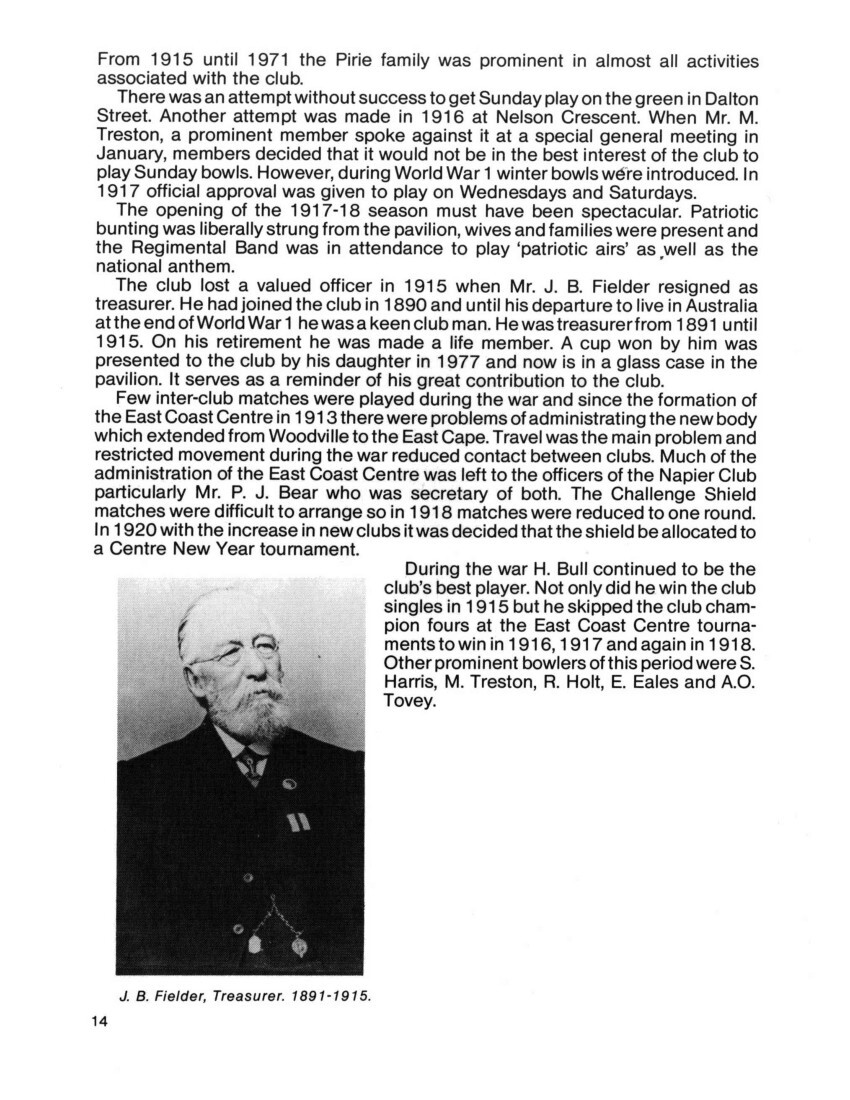
Page 15
THE POST WORLD WAR 1 YEARS
At the end of the war Napier changed its half-day holiday from Wednesday to Saturday. This placed an additional burden on the match committee to get all matches played on Saturdays.
Electricity was first installed in the pavilion in 1919. Funds had been raised at a gala day. Problems with the water supply continued as bigger demands were placed on the Council supply as more houses were built in Napier South. Restrictions were imposed in the summer just when the greens needed water. Once again an attempt was made to get artesian water from a well at the green. But because of financial difficulties no action was taken and the club had to continue with the town supply.
In February 1920 a team from the Wellington Bowling Club visited the club. They presented a handsome leather-bound visitors’ book to the club and in a letter of thanks wrote of the friendly inter-club visits being important in maintaining the social element for which the game had always been justly famous.
During the visit of the Prince of Wales in 1920, the pavilion was decorated with bunting and patriotic flags.
Winter bowls continued on the No. 1 green facing Nelson Crescent. A charge of one shilling a game and the letting of the upstairs room for social evenings were sources of extra revenue in the slump period of the early twenties.
At the annual meeting in September 1922 the type of membership was changed again. There were to be four types:- full or ordinary members, life members elected at annual meetings, associate members, who were members of another club, with limited playing rights, and honorary members who could be appointed by the committee but without playing rights.
Mr. H. Bull was appointed the club’s first official coach in 1923. Since then coaches have been elected annually.
ASunday play was again rejected by a large majority when it was proposed at the 1923 annual meeting.
By 1924 club membership had dropped to 70. However the club continued to
Photo caption – A view over Napier South showing the Napier Bowling Club in 1926.
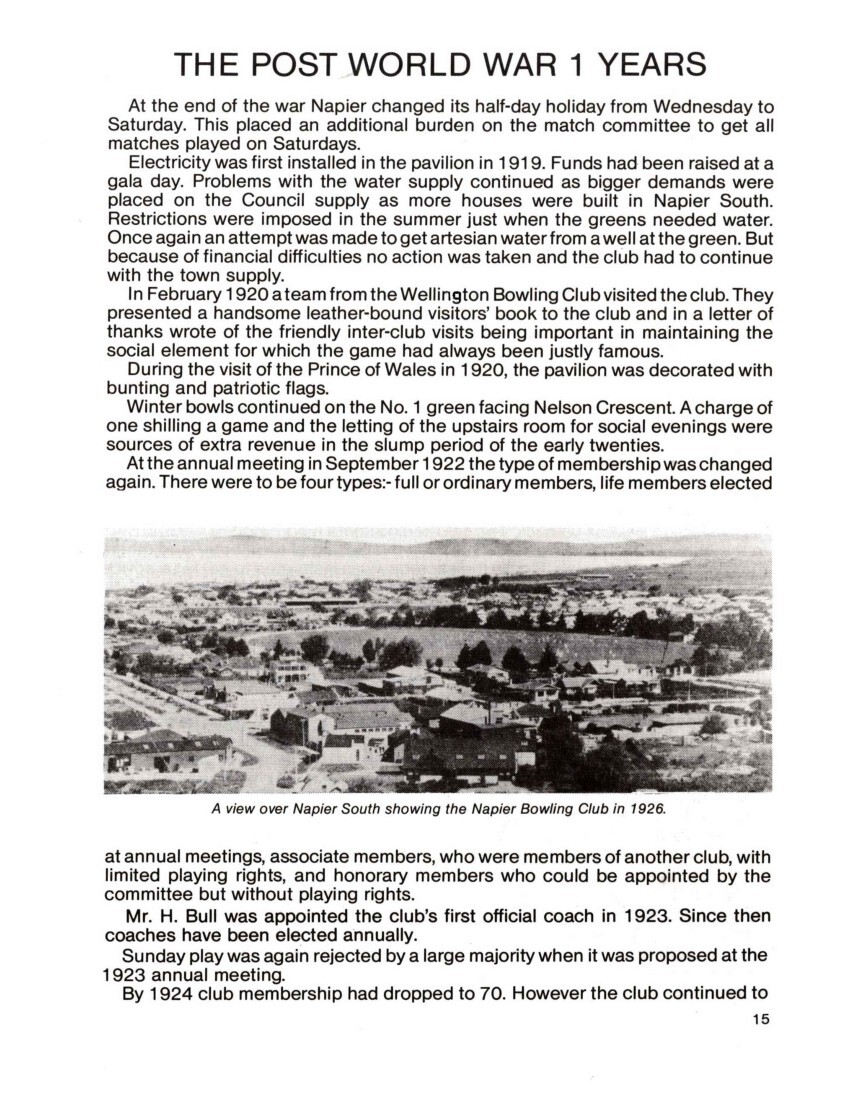
Page 16
produce some excellent bowlers A. Cronin (skip), S. J.Storkey, C. Schmoll and A. McVicar won the East Coast New Year Fours in 1924. Not only was D.A. Evans winner of the Club Championship Singles in 1923, 1924 and 1928 but was in H. Bull’s teams which won the Champion Fours winning team on four occasions. Players in Bull’s teams which won the Centre New Years Fours in 1921 and 1924 were S. Harris, C. Woodcock, J. Carter, C. Cunningham and F. Williams. The Centre Easter Fours in 1924 was won by C. Plested (skip), W. Bailey, C.Briasco and F. Daily.
LIQUOR PROBLEMS
With membership on the decline 1925 was a year of crises. The problems of the club were further added to by an event which seriously endangered the club’s existence.
It has not been determined just why the police raided certain bowling clubs in the district and charged them with breaches of the sale of liquor laws. Napier was one of the clubs charged. In spite of legal help from the Wellington Bowling Club, the club lost its case and was fined £40. It was not the fine, which was paid off by donations from prominent members, that was the problem but the division of membership on the liquor question. In July 1925 the annual meeting went into a special meeting ‘to consider certain subjects of interest to members’. Mr. F. C. Williams, the treasurer, gave an account of the court case indicating that the club had suffered a serious setback. The club had no spare funds. Indeed it was in debt to the bank. Other speakers recommended the closing of the ‘library’ and others the winding up of the club. Finally the secretary was instructed to get legal advice on the closing of the ‘library’. Mr. H. B. Lusk, the club’s solicitor, advised the club by letter in September 1925 that the sale of liquor by the club was illegal and at a special meeting 23 September Mr J. P. Williamson moved and Mr. W. Lyford [Lydford] seconded ‘that the supply of liquor by the club for sale in any shape and form be absolutely cut out and that subscriptions be raised to four guineas per annum plus locker fees’. When the motion was put thirteen voted for and fourteen against. The club obviously was divided on the issue. A compromise was reached when it was decided that no liquor was to be sold to outsiders and that it could be obtained only on the presentation of a ticket, such tickets to be distributed to members only. Mr. Williamson requested that his name was to be recorded as one who disassociated himself with the whole question of liquor in the club. The ‘library’ was closed but was to be re-opened in 1928. Regrettably the liquor problem was to continue to divide the club for many years.
At another special meeting in November 1925 the treasurer reported on the serious state of the club’s finances and the necessity to increase revenue. The only way he could see out of the problem was to sell some of the property facing Nelson Crescent. The meeting decided that this was too drastic a measure. Fortunately for the club the Bank of New Zealand granted special financial arrangements and insisting on strict economy, carried the club through the next few years.
In November 1926 electric floodlights were erected on one green for night play. The green was open to members of all bona fide clubs at one guinea per season. Night bowls was an instant success but because of the extra wear it put on the
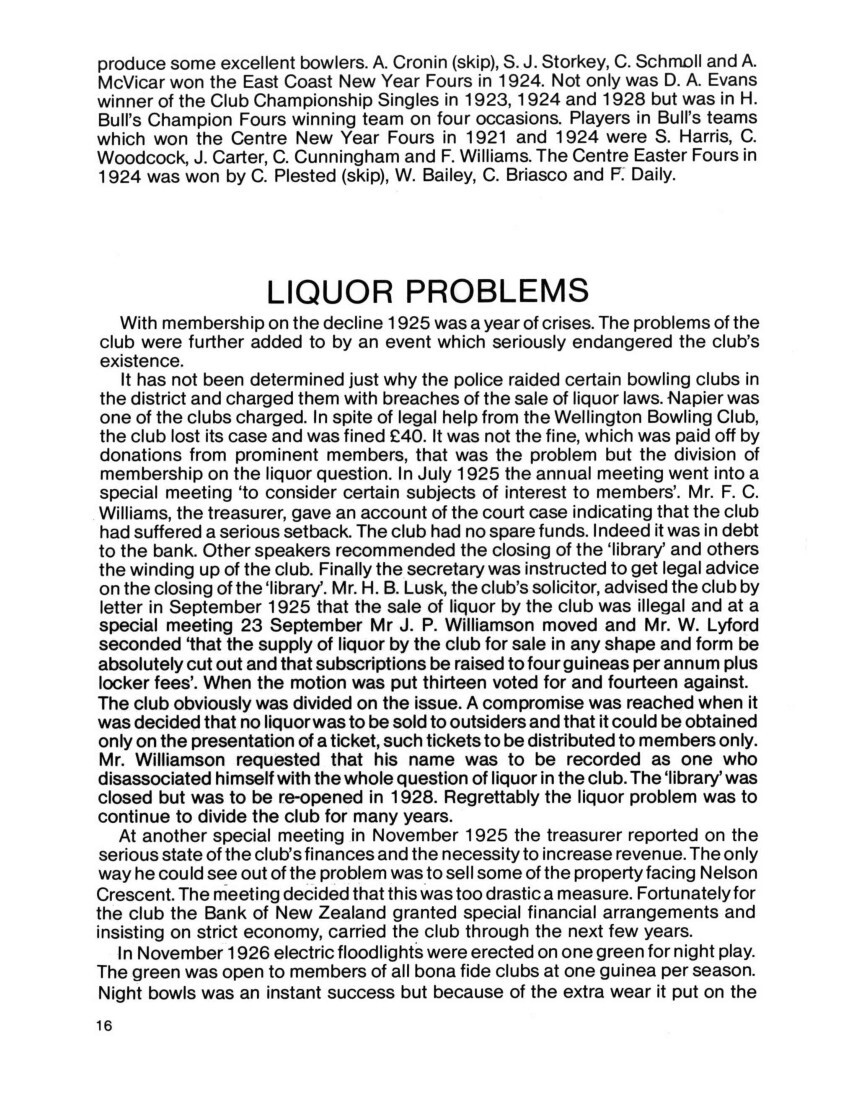
Page 17
green play was discontinued in June 1927. However it was started again in 1928 and continued up to the time of the earthquake in 1931. Several night tournaments were held and the ‘library’ was opened to cater for players. A year later an attempt was made to have the ‘library’ closed again. A vote was taken on closing but it was narrowly defeated by one vote and as a compromise it was agreed that it be closed not later than 7 p.m.
THE SALE OE A GREEN
Notwithstanding the efforts of successive committees guided by the skill of Mr. P. J. Bear, the Secretary-Treasurer, to keep the club solvent in the late twenties, the onset of the world depression and the unwillingness of the bank to give further credit aggravated the club’s financial problems. The raising of the subscription to four guineas in 1929 did little to alleviate the problem. However Mr. P. J. Bear was able to raise £1250 on first mortgage thus saving the club a small amount on service charges.
During 1929 the greens were resurveyed and levelled using Mr J. P. Smith’s levelling machine. Green superintendents still relied heavily on voluntary labour. Sunday bowls was first permitted in 1929 but only for social games.
The sale of the front green was brought up again in March 1929. Mr W. R. Holder offered £800 for the section facing Nelson Crescent. His offer was declined but in June two further offers were made and a special meeting was held to test members’ feelings. A vote was taken and it was decided not to sell by a vote of 12 to 9 with 4 abstentions. By July 1930 the economic depression was causing serious problems throughout the land. Mr. A. Renouf, the president, made earnest appeals to members to pull together to give the club financial support. Support was not forthcoming. An attempt to amalgamate with Wairere was unsuccessful so a special general meeting was held on 29 October 1930 at which on the motion of Mr J. Bissell seconded by Mr. H. Wardell-Johnson, the members approved of the sale of the front green. The land 129 feet by 125 feet facing Nelson Crescent leaving a 10 feet right of way was sold in February 1931 to the New Zealand Baptist Union.
At 10.47a.m. on the 3rd of February 1931 a severe earthquake struck Hawke’s Bay. The devastation caused by the ’quake and the fire after almost destroyed the town of Napier. While only minor damage was done to the club’s wooden pavilion the greens were seriously affected. Levels were upset and it took many years to get the green flat again. Many of the club’s trophies in private homes went missing. Fortunately some financial help was given by the Dominion of New Zealand Bowling Association and the Earthquake Relief Fund helped with a donation of £52. A photograph in the New Zealand Free Lance on the 25th February showed fourteen members on the green back in action three weeks after the ‘quake.
Shortly after the earthquake negotiations with the Baptist Union over the sale of the land were completed. Until a church could be built on the section the Baptist Union used the upstairs room in the pavilion as a Sunday School for five shillings per week. The presence of undisciplined children was not welcomed by members and to their relief the lease of the room was withdrawn in February 1932. The club
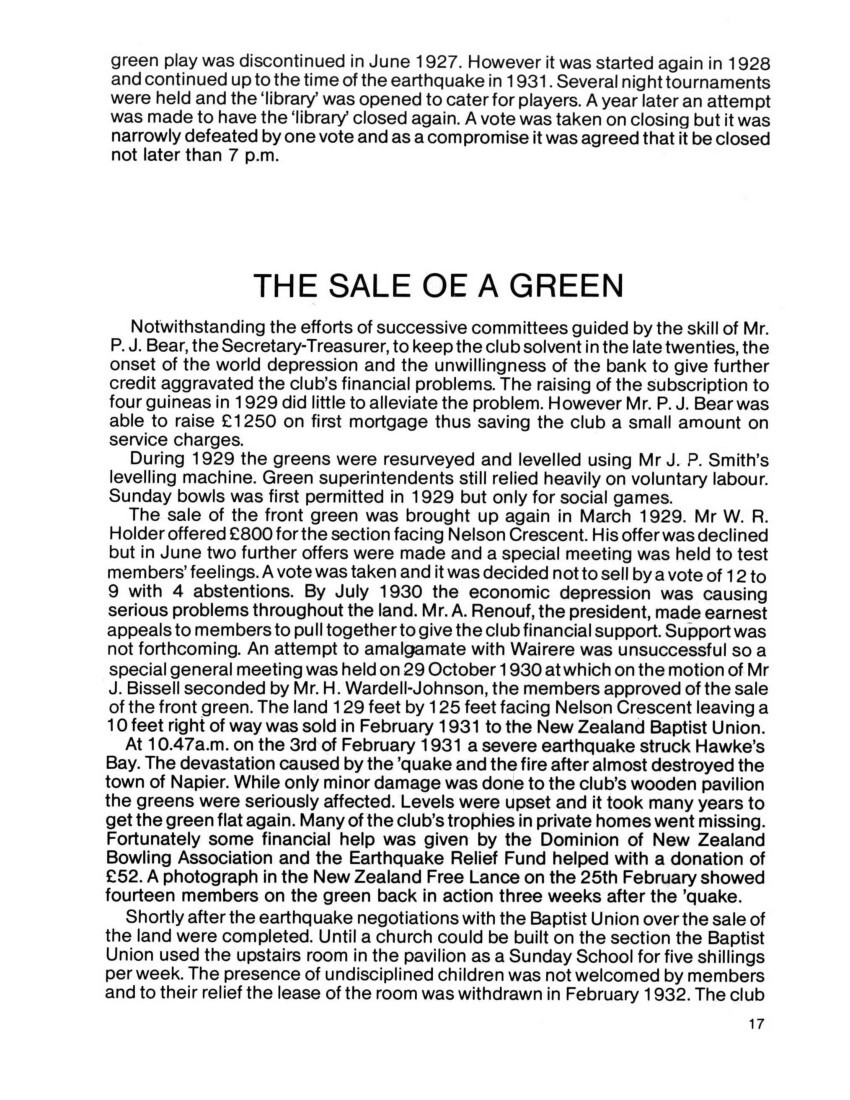
Page 18
was to receive £1000 for the land with all expenses being paid by the purchasers. The club had some difficulty in securing payment. The treasurer was still requesting payment of the last £200 in November 1933. Final payment was made in February 1934 when the Baptists sold the section for private housing.
In spite of the many problems faced by the club during this period playing standards remained high. Napier players still performed well at Centre level. H. Bull continued his excellent record. With A. C. Campbell, P. J. Bear and J. A. Engebretsen as his team he won the Championship Fours in 1928. In 1930 J.A. Engebretsen and E. Bissell won the Pairs.
Photo captions –
Members at the green three weeks after the Quake. February 1931.
Winners of the East Coast Champion Fours, 1928. A. C. Campbell P. J Bear (Scorer), J. A. Engebretsen (Measurer), H. Bull (Skip).
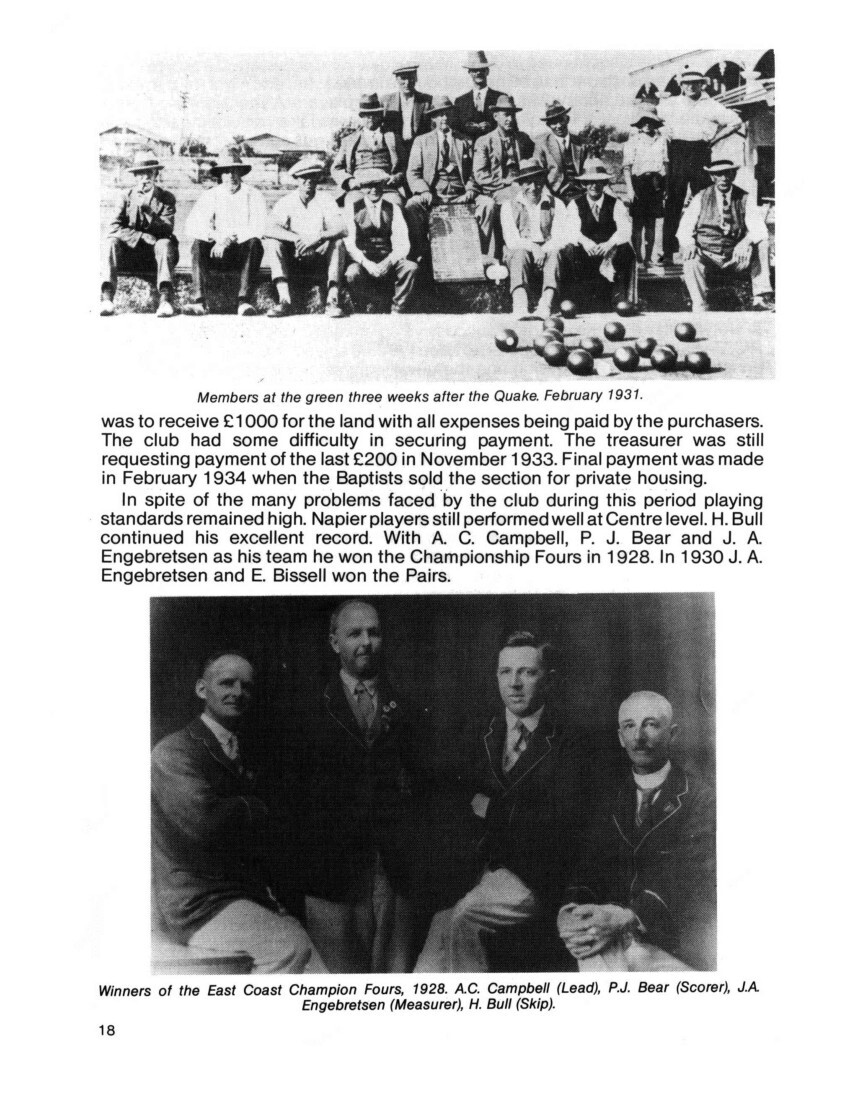
Page 19
RECOVERY
A period of comparative stability was to follow the upsets of the late twenties and early thirties. Although the economic depression was to continue until 1935 when there was a change of government, the club under the guidance of Mr. P. J. Bear, the Secretary-treasurer, and a succession of capable presidents and committee members, recovered its place as a club of good fellowship, goodwill and sound finance.
At a special meeting in September 1933, the club changed its colours to royal blue and gold and adopted a new blazer. The royal blue serge jacket with gold braid and a pocket monogram with the letters N.B.C. over a stylised Norfolk pine was to be worn with pride. The hat band with, blue and gold stripes and the monogram added to the attractiveness of the union.
Until blazers were standardised at Centre level clubs were free to register their own. Early photographs of Napier players show garments with alternate cerise and white stripes with variations of monograms on the pockets. The wearing of white
Champion Pairs 1933-34. Messrs F. K. (Jack) Pirie & S. Bendall.
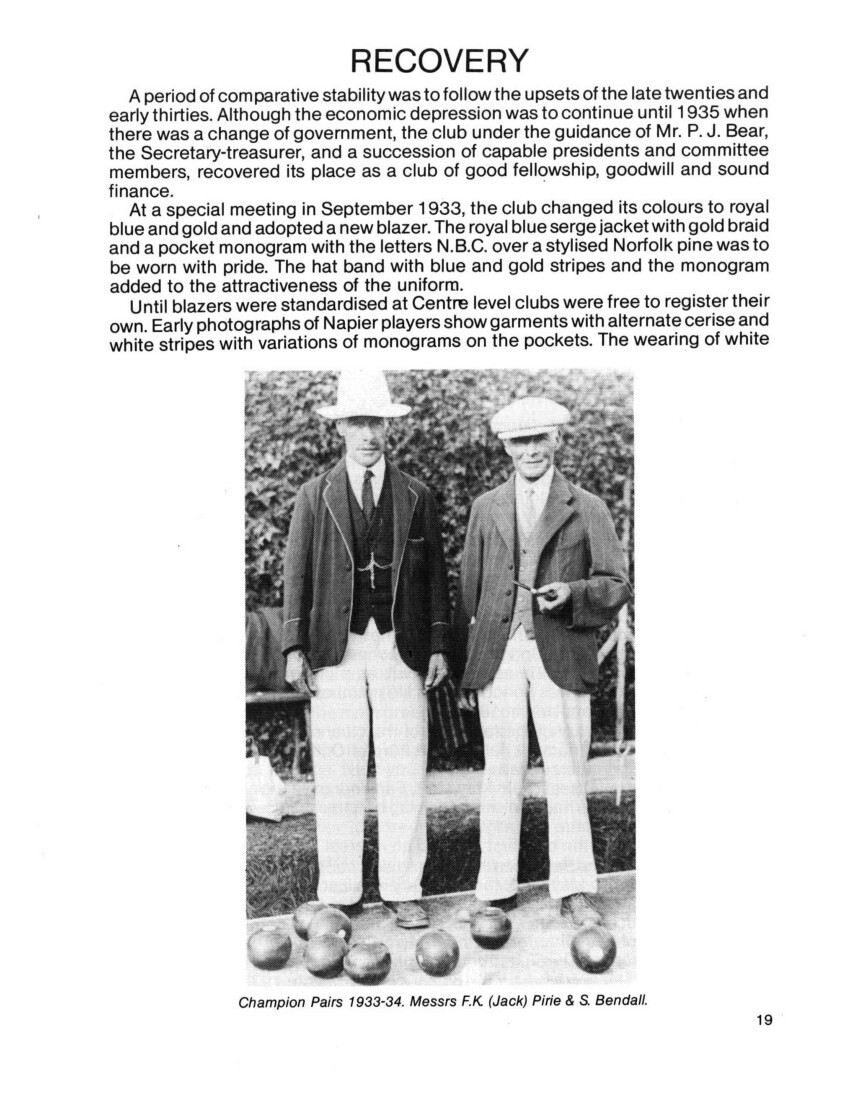
Page 20
trousers was not considered necessary in the early days but there were strict rules about wearing the correct footwear on the greens. The plain all black blazer with the Centre badge and club name in white block letter under was first introduced in 1951.
When the Hawke’s Bay Bowling Centre was set up in 1933 Mr. P. J. Bear became its first secretary filling the position until 1948. He played a very important part in the progress of Centre during its early years.
Great honour came to the club when in 1935 J. A. Engebretsen won the New Zealand Singles title at Auckland. On his return he was presented with a fountain pen by the president Mr. G. H. Cooke. Mr Engebretsen, a local school headmaster was not to be in the club for much longer in February 1937 he went on promotion to Wanganui.
With careful management the club’s finances slowly improved. Credit balances were shown in 1934, 35 and 36. A greenkeeper was employed at £4-15-0 per week and the club was fortunate to have several very capable members to do voluntary maintenance. Messrs. F. Daily and A. W. and F. K. Pirie gave their services freely as painters, plumbers, mechanics, and greenkeeping labourers.
The home and away friendly matches between clubs was first introduced in 1935. Most of these much enjoyed events have continued into the 1980’s. Trophies of minimal value such as the ‘Gold Nugget’ for the Wairere matches and the ‘Naoma Plate’ with Omarunui served as a token reward for the winning club. Results were never recorded. For similar matches with Bluff Hill Mr. E. R. Spriggs donated a cup in 1940. Mr. Spriggs, later to become mayor of the city, first joined the club in October 1935. He served the club as a player and administrator of considerable ability. He was honoured with life membership in 1972 and was still attending the green regularly in 1986.
The fiftieth anniversary of the founding of the club in 1937 passed by almost unnoticed. A small tournament held on the 23rd of October followed by a social evening was a moderate success.
1938-39 was a quiet season. In May Mr. T. Faulknor gave the club permission to use the artesian well he had sunk near the club boundary. This well was used until the flow diminished in the early 1970’s.
It was in 1938 that the club first showed an interest in changing from grass to weed greens. Mercury Bay weed had been used successfully in Auckland. At a committee meeting in May 1938 the secretary was instructed to write to Mt. Eden club ordering eight yards at £1 a yard to be delivered in July. The weed was planted and although successful in its initial stages became a continuing source of management problems throughout the 1940’s.
A feature of the club throughout its long history has been the willingness of members to do voluntary work for the welfare of the club. In 1938 an attempt was made by the committee to recognise the work of Mr. F. K. Pirie who had been green
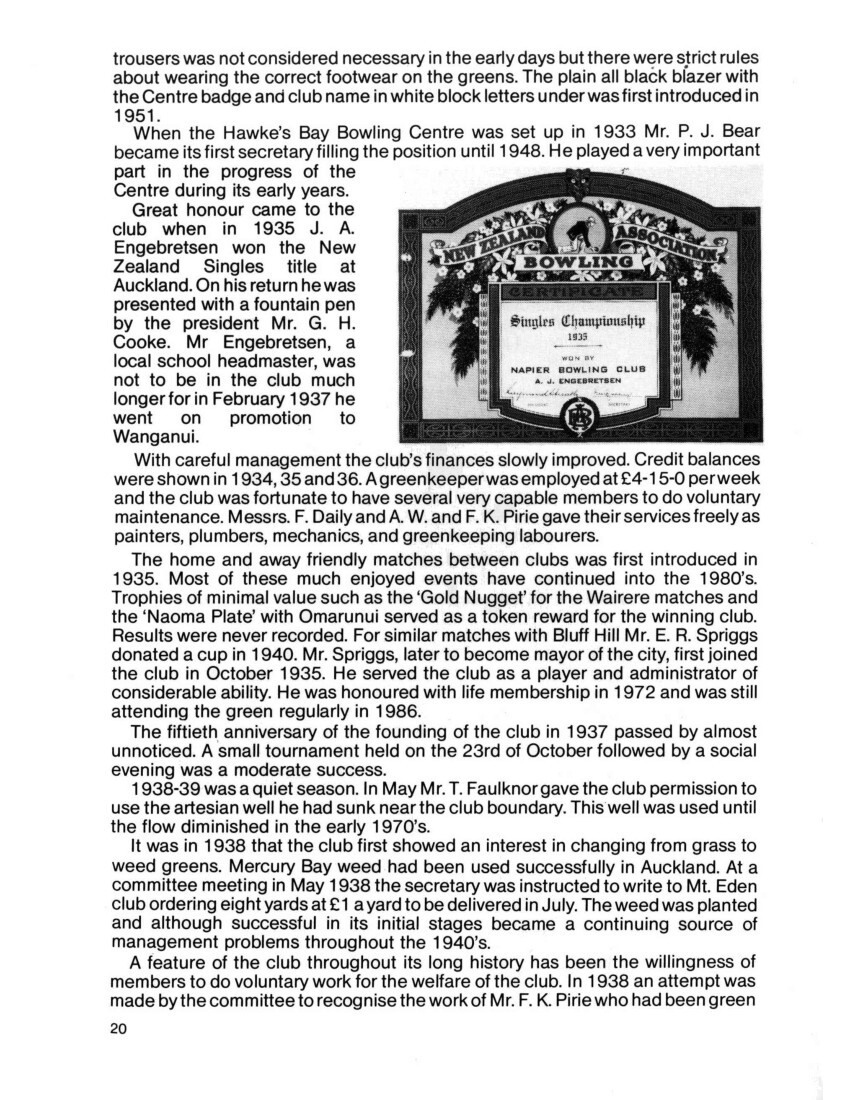
Page 21
superintendent for many years by offering him remission of his subscription. He refused stating that what he had done was for the welfare of the club and he did not expect any reward. Before and since there have been dozens of men who have given their time and expertise to the club without the thought of reward. Mr. F. K. Pirie was one of five members of the Pirie family associated with the club over fifty years. A. W. Pirie (Archie) joined the club in 1915. A. S. Pirie (Spencer) was the last to play on the green in the 1960’s. His death was recorded in the annual report in 1971. The other brothers, S. F. (Jumbo) and G. (Gordon) all gave service as members of the committee or voluntary workers round the green. The Piries were a very supportive family. They gave each other moral and often vocal support when playing important matches.
In the period just before World War 2 A. J. Engebretsen, who won the singles title in 1936-37 was the outstanding player. As previously recorded he won the New Zealand Singles in 1935. S. Beer, R. Thontas, R. McLaren and H. Elmes won the Centre Championship Fours in 1938. In 1936 A. Bryan won the Centre Singles.
THE SECOND WORLD WAR
When war was declared in September 1939 members did not respond with the exuberant patriotism of 1914 but loyalty to Britain was accepted in a quiet determined way. At first bowling activities continued uninterrupted by the war on the other side of the world. Blackouts were started in April 1940 and rationing of food and clothing as well as petrol was to cause some inconvenience. However playing bowls continued and indeed the club was to extend its property.
At a special meeting on the 29th of May 1940 the club agreed to the purchase of a section adjoining the green on the eastern side of an approximate size of 116 feet by 68 feet. Only nine members opposed the purchase and a committee of Messrs. P. J. Bear and R. W. Goodger were authorised to buy the land for £200. To finance the establishment of No. 2 green a £500 mortgage was taken out with the Bank of New Zealand. Mr. J. Corne, the green superintendent was authorised to employ labour to complete the work. The Napier Borough Council gave a small parcel of its land at a peppercorn rental to allow enough room for an implement shed. The green came into use in January 1942.
The playing surface of the main green had become so bad in 1941 that a special meeting was held in March to try to find methods of getting lasting improvements. It was decided to continue with the weed instead of grass. The green was closed and renovations began at once. Next year the green was still in poor condition.
When the war was at its height maintenance on the green suffered. Several greenkeepers were employed but few had the ability to do the work required. There was no clear policy of green management and uninformed opinion aggravated the problems.
Mr. G. H. Cooke died in 1942. His death was a great loss to the club. He had been president on three occasions in the 1930’s and worked hard for the club. Grateful members presented a very attractive silver cup in his memory for the championship pairs.
By 1943 when Mr. E. Boldt became green superintendent the state of the greens improved, Sunday play was again permitted. There were very few inter-club matches. With the severe rationing of petrol, transport was always difficult to arrange and most club members were fully occupied in helping patriotic activities.
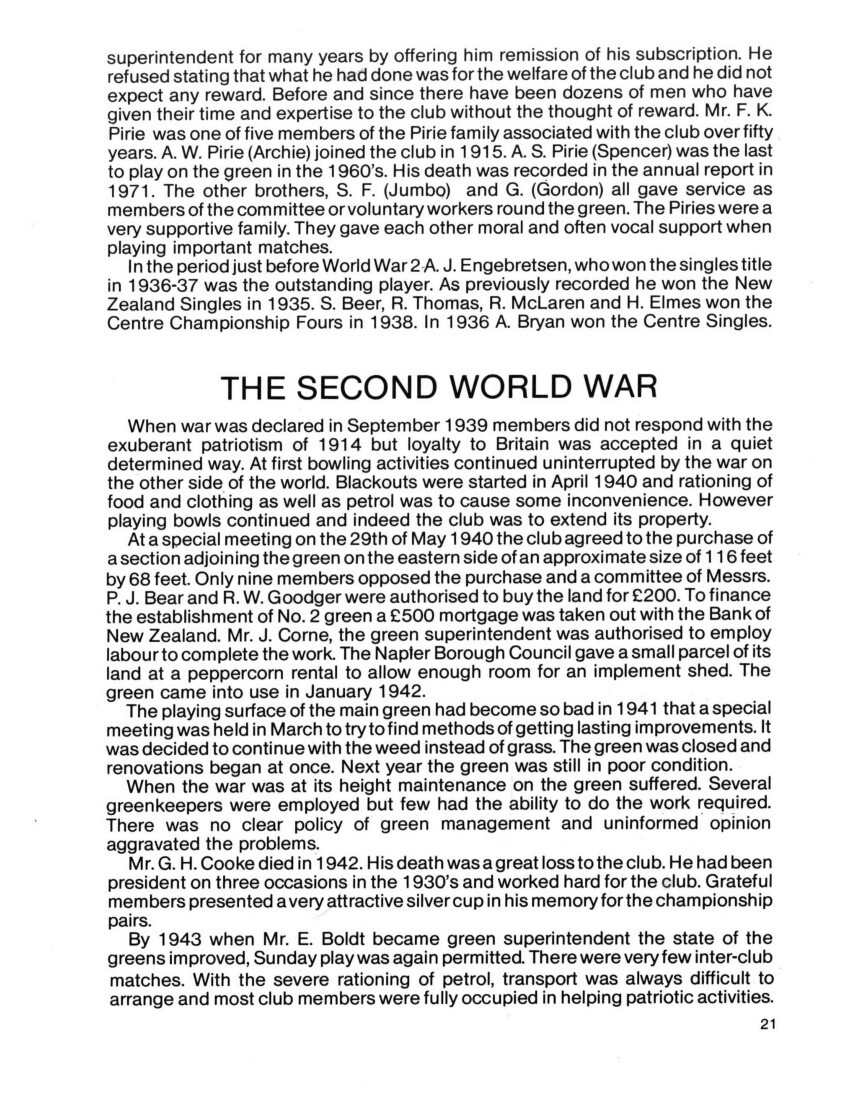
Page 22
They took a major part in a queen carnival to raise funds and ran raffles and card evenings in support of the Patriotic Fund Board. Members of the croquet club continued to take care of the afternoon teas. They were experts at overcoming the problems of rationing. Members were requested ‘to bring a small quantity of tea and sugar say up to four ounces in view of the difficulty in obtaining same because of rationing’.
By the end of the war there was a membership waiting list so it was decided to increase facilities. The locker room was enlarged by removing one of the interior walls of the pavilion. No. 2 green was used for winter bowls at one shilling per player per game.
There were few opportunities for members to compete at National level during the war but the club still had bowlers of high quality. In 1941 and again in 1945 N. Burgess skipped teams to win the Centre pairs. He was the outstanding player of the period. He was club singles champion on six occasions and was an excellent skip. Players who were beginning to show their potential were J. R. Harland and P. A. Hardie both of whom in post war years performed with distinction.
AFTER WORLD WAR TWO
At the conclusion of the war there was an upsurge of interest in the game of bowls. Requests for membership forced the annual meeting in July to raise the limit of membership to 120. The demands placed on the greens increased and when Mr. T. A. Williams took over as superintendent in October 1946 he had big problems. In 1947 to rest the main greens winter bowls was transferred to the croquet green in front of the pavilion. There was some objection from the croquet ladies but even with the limitations of an undersized green, it has been a source of many hours of happy social bowls in the off season ever since.
Green problems continued. The Mercury Bay weed had not been successful and there was strong agitation to return to grass. In April 1948 Mr. S. Nicol advised the club to seek help from the Greens Research committee in Palmerston North. An expert came from Palmerston North and was not impressed with what he found. Messrs. J. Corne, W. Moult and S. Nicol agreed to work on the reconstruction of the greens under the direction of the Research committee. By December 1948 all was going well on the greens. The conversion back to grass seemed to have been successful.
In August 1948 on the motion of Mr. C. S. Findlay it was decided that medallions and bars take the place of prizes in future. From then on winners of club competitions were to be presented with a club badge with a navy blue ribbon to which was attached a small metal and enamel bar recording the event won and the year.
While the standard of play remained high in spite of mediocre playing surfaces at this time, A.C. Snaddon who won the singles title first in 1949 was to dominate club competitions until he was transferred by New Zealand Railways to Wanganui. His record was a most impressive one. Apart from winning the club singles on six occasions in succession from 1949 to 1954 he was also Centre champion in 1949 and 1954. He was in the Centre champion fours in 1950 and 1956. At the New Zealand tournament in 1952 he was runner-up in the fours. However his greatest claim to fame was to represent New Zealand as skip of the pairs at the Vancouver Empire Games in 1954.
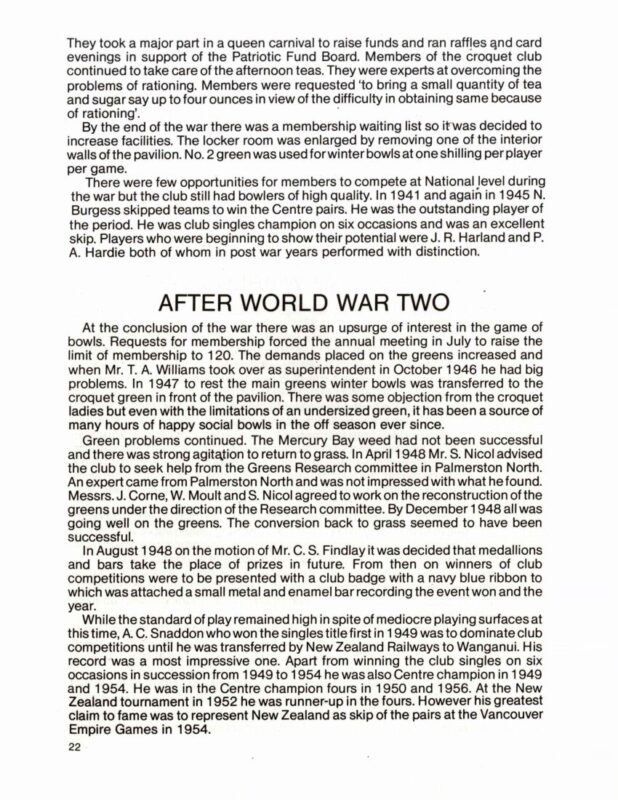
Page 23
THE SEARCH FOR NEW PREMISES
Napier had a population explosion in the 1950’s. The Borough Council through negotiations with the Napier Harbour Board took over land for housing in Marewa, Onekawa and Maraenui. Extensive areas were set aside for recreation. Some members saw this as an opportunity to shift from Nelson Crescent to one of the new parks to give room for more greens and a cut in maintenance costs on an ageing pavilion. Attention was first directed to Marewa Park which had been used for growing vegetables for patriotic purposes during the war. The Council reconditioned the surface and allocated a section of it facing Herrick Street for bowls and croquet.
At a committee meeting at the club the president Mr. S. McIntosh, reported that he had met Mr. C. Corner, the Parks and Reserves Superintendent on the 25 July 1951, to investigate a transfer to Marewa. It was hoped with Council help to set up three greens. Meanwhile another group of bowlers representing the J. P. Smith Citizens’ Bowling Club had had a favourable meeting with the Council. When the club was informed by letter from the Council in November in 1951 it was decided to drop the idea of moving to Marewa. The attempt to get new greens was shelved until 1963.
At a well attended annual meeting in 1955 the retiring president Mr. S. McIntosh reported that the previous season had been a particularly good one. The finances were in a healthy state and the greens were playing well. This was to be Mr. Mclntosh’s last year as president. A retired farmer, he had been president for the previous six years and for much of the time green superintendent. A grateful club honoured him in 1956 with life membership.
Extensive alterations had been made to the upstairs room in the pavilion in 1954-55. All the old furniture was sold, tables designed by Mr. G. A. Faulknor to seat eight people were placed so that ninety six people could be seated at one time, the old photographs were removed and hard board was fitted round the lower walls.
1951-52 was a good year for the club in outside competitions. F. K. Pirie, W. Hislop, H. Cameron and C. F. Johnson won the Centre Veteran Fours while C.F. Johnson, H. Cameron, A.G. Grant and S. Nicol won the Centre Championship Fours. In Dunedin at the National Championships A.C. Snaddon, W.J. Stone, R. Sutherland and D. Haggerty were runners-up in the Fours.
N.Z Champion Fours, runners-up 1952. A.C Snaddon (Skip), D.F. Haggerty, W.J. Stone, R. Sutherland.
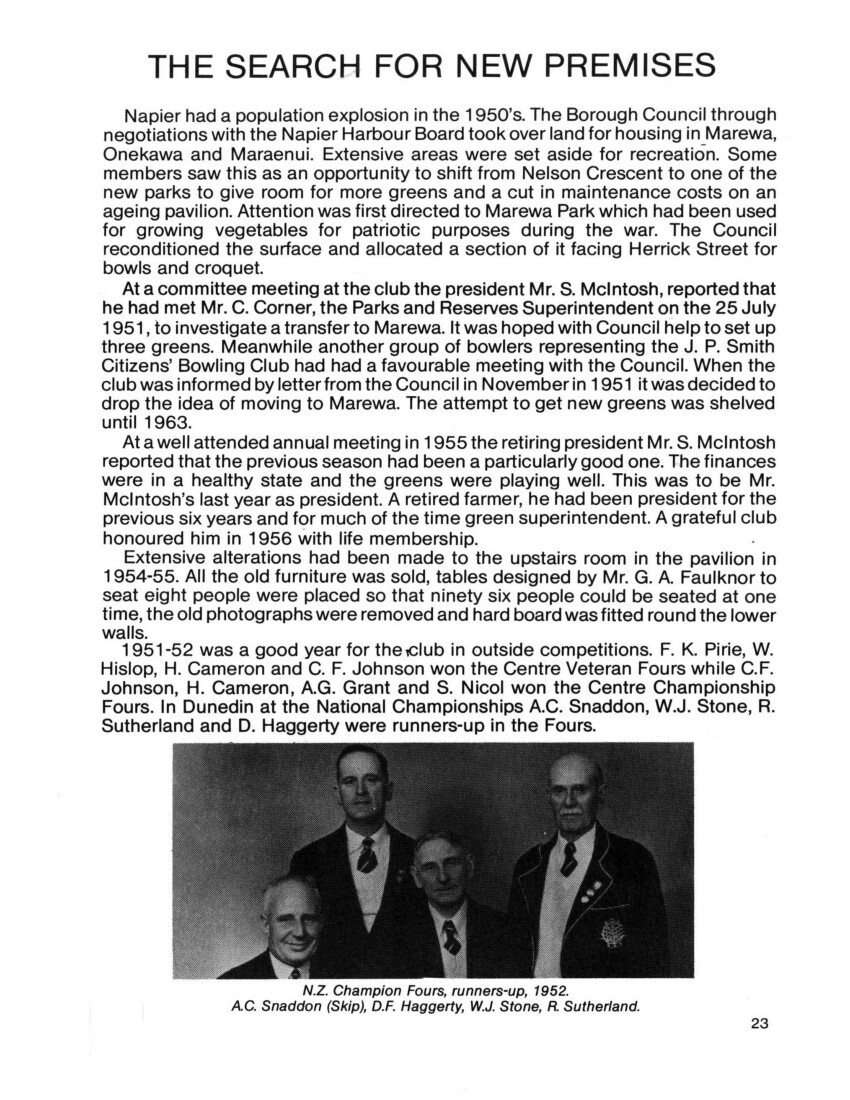
Page 24
THE FOUNDING OF THE NAPIER WOMEN’S BOWLING CLUB
The first reference to the formation of a Napier Women’s Bowling club appeared in the minutes of a committee meeting in August 1949. Members of the Croquet Club were invited to discuss setting up a women’s club. The president, Mr. McIntosh, among other things pointed out that by converting to bowls they would have more players and thus more revenue. The women were not convinced and decided not to change although they were prepared to help the men with teas and catering.
At a committee meeting on the 15th April 1953 the matter of women bowlers was discussed at some length. A meeting was arranged at Mr. S. Mclntosh’s home with members of the croquet club. As a result of this meeting the president called a meeting of the women to form a club limiting play to four rinks. Twenty women attended and the Napier Women’s Bowling Club came into existence on the 22nd of June 1953. Membership was to be limited to forty and the subscription was fixed at £3 per annum. The croquet club was to continue on a green in Nelson Park supplied by the council until 1960 when it closed because of dwindling membership. The remaining members joined the Marewa Croquet Club.
FURTHER EXTENSIONS TO THE GREENS
The club was thriving in 1957. With a playing membership of 117 and the women’s quota of forty members full, pressure was again placed on playing space. In March permission was given by the Council for the club to rent land in Nelson Park adjacent to the club grounds. A special meeting on the 22nd of August gave the committee approval to proceed. The estimated cost of setting up the green of six rinks was £170 and the rent was fixed at £15 per annum for seven years. The new No. 3 green was officially opened on the 15th November 1958 when Mrs. A. Culliford, the women’s president, threw the first jack.
During the 1950’s evening pairs competitons [competitions] were held. Members who worked welcomed the opportunity of competitive play after work. The competitions lapsed later because a large number of members were then retired and having already played in the afternoon did not like playing another game. In the 1960’s and again in the 1970’s attempts to have rink play in the evenings failed due to lack of support.
By the opening of the 1956-57 season the women’s club rooms had been extended towards the main green. These rooms with a large window overlooking the greens served the women until major changes were made in 1979-80 when a new room with all facilities was added to the other end of the building.
By 1958 it was necessary to close the membership and a waiting list was opened. The club’s funds were in a healthy state, and for the first time in the club’s history, the committee on the recommendation of Mr. J. R. Harland, was able to
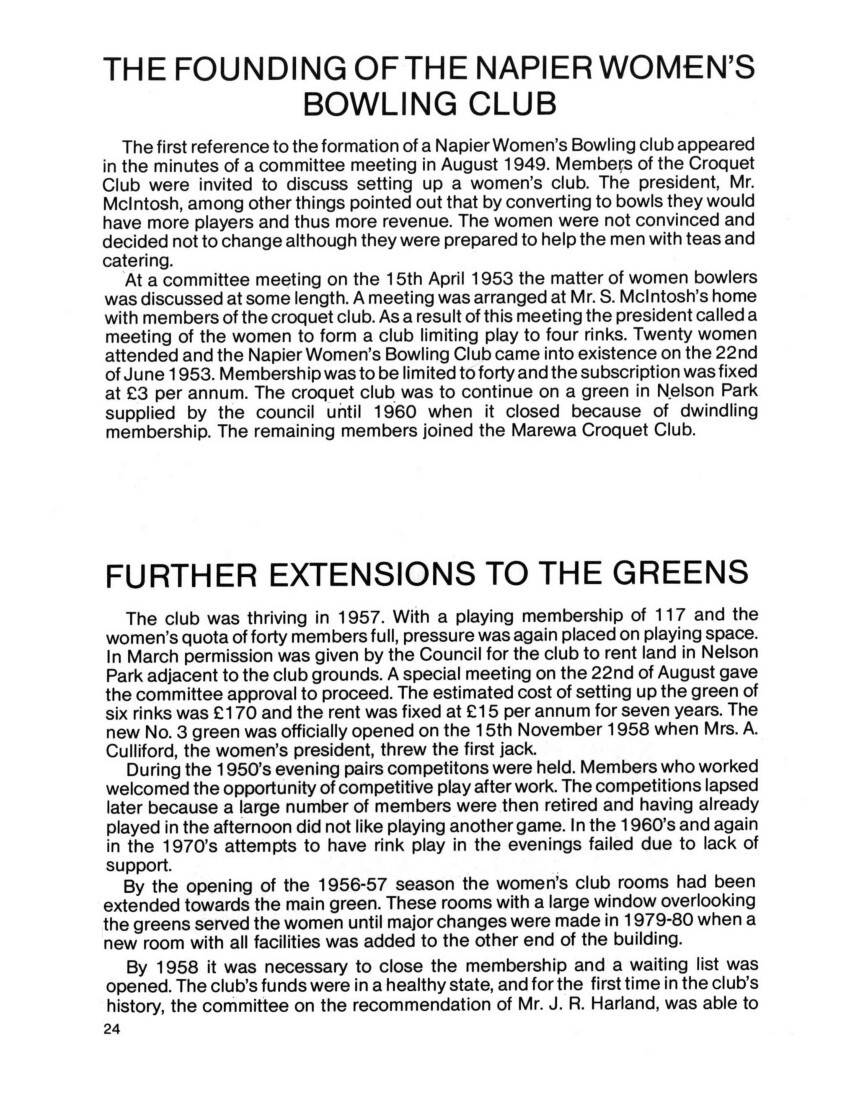
Page 25
lodge £250 in the Post Office as a building and maintenance fund and also £250 was invested in Harbour Board debentures at 5%.
A highlight of the 1957-58 season was a visit from an Australian team touring New Zealand. Seven rink matches were played with the visitors.
Napier City Centennial Celebrations were held in 1958. The club recognised the occasion by holding a mixed tournament in the third week of November and contributed £5 towards a bowling float in a cavalcade of vehicles which paraded through the city.
Although the club was numerically strong during the 50’s there were few bowlers who performed well at Centre events. W. D. Olney won the Singles in 1957 and A. J. Heibner the Junior Singles in 1955. The best player of the period undoubtedly was W. D. Olney who was club Singles Champion in 1955, 1957 and 1959 and he skipped the Champion Fours team with G.A. Faulknor, S. Peed and W. Fulford in 1957. With R. Lawrence in 1954 and 1955 and with W. Fulford in 1958 he won the Championship Pairs. Other players who performed well at club level were C. Lopdell, R. Arbuckle, R. Lewis, H. Cameron and A. Culliford. In 1956 B. J. Scullin won the Centre Open Singles.
THE STRUGGLE TO GET GOOD GREENS
In his annual report in 1961 Mr. G. M. Ruscoe referred to the excellent state of the greens and congratulated Mr J. Lowes the green superintendent on his untiring efforts in getting a good playing surface. It was unfortunate that this state
Photo caption – Opening of 1960-61 season.
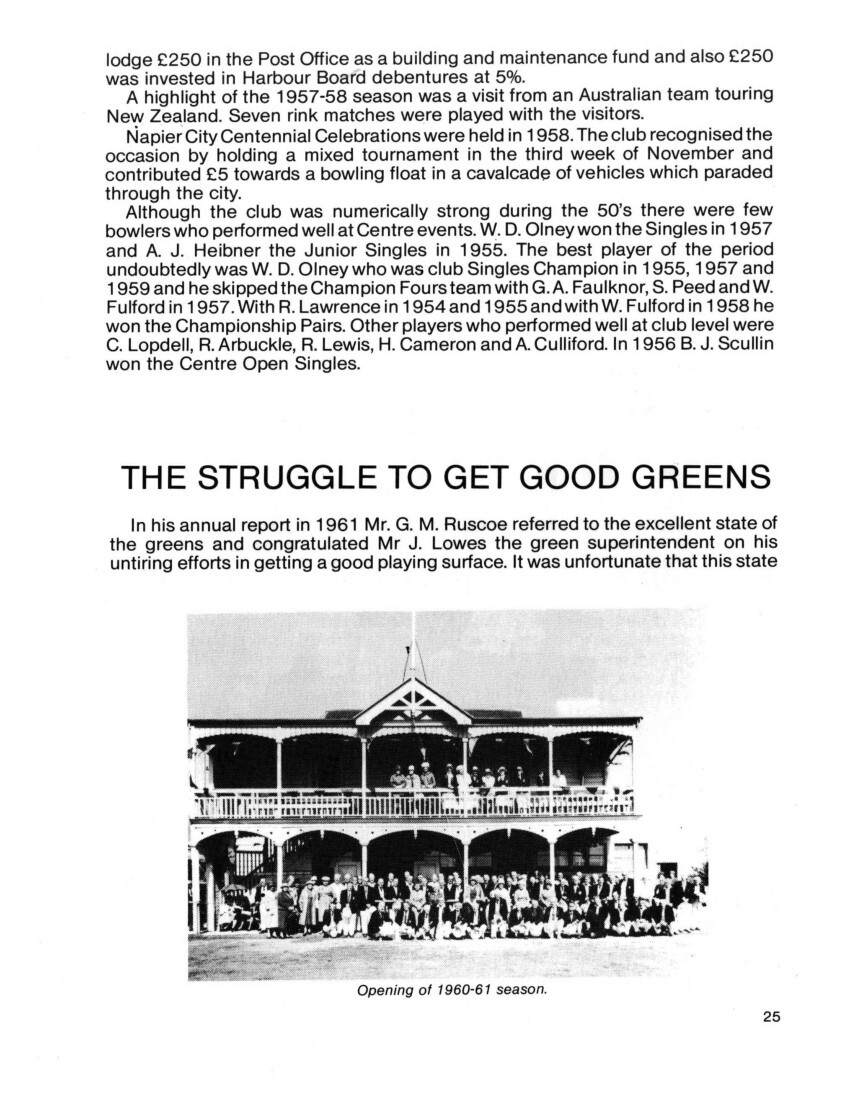
Page 26
of affairs did not last long. Throughout the next decade successive committees were to find their main problems were associated with the poor quality of the greens. In spite of working bees spending many hours plugging dicondra weed the results were most disappointing. Advisory officers visited the club regularly and green superintendents attended the green management courses but the problems continued.
Much work was done on the surrounds in 1961. The western boundary fence was renewed, permanent seats in building block shelters donated by members round the main green and seats round the new green were made.
Mr. E.R. Spriggs was president in 1962 – the clubs 75th anniversary year. At the annual meeting he outlined the plans for an historical booklet, a jubilee dinner and a special three day tournament. Unfortunately because of lack of support none of the plans were achieved.
The club was honoured in 1963 when Mr. J. R. Harland gained a seat on the New Zealand Bowling Council. Mr. Harland was secretary of the Napier Harbour Board and willingly gave his spare time to the administration of bowls.
During the early sixties there were few players in the club of outstanding ability. At Centre level S. Stevens skipped the team which won the Veteran Fours and J. R. Harland was runner-up in the Singles in 1962. Players who performed well at the club were C. P. Lopdell, A. J. Heibner, L. J. Burke, P. A. Hardie and P. J. Murphy all of whom won the club Singles at different times.
Photo caption – Opening 1962-63 season. P.J Bear delivers the first bowl. L to R. A.W. Pirie, J. Hellyer, R. Arbuckle, H. Smith, H.A. Harper, C. Rapsey, G. Buckman, L.J. Burke, E.R. Spriggs (President).
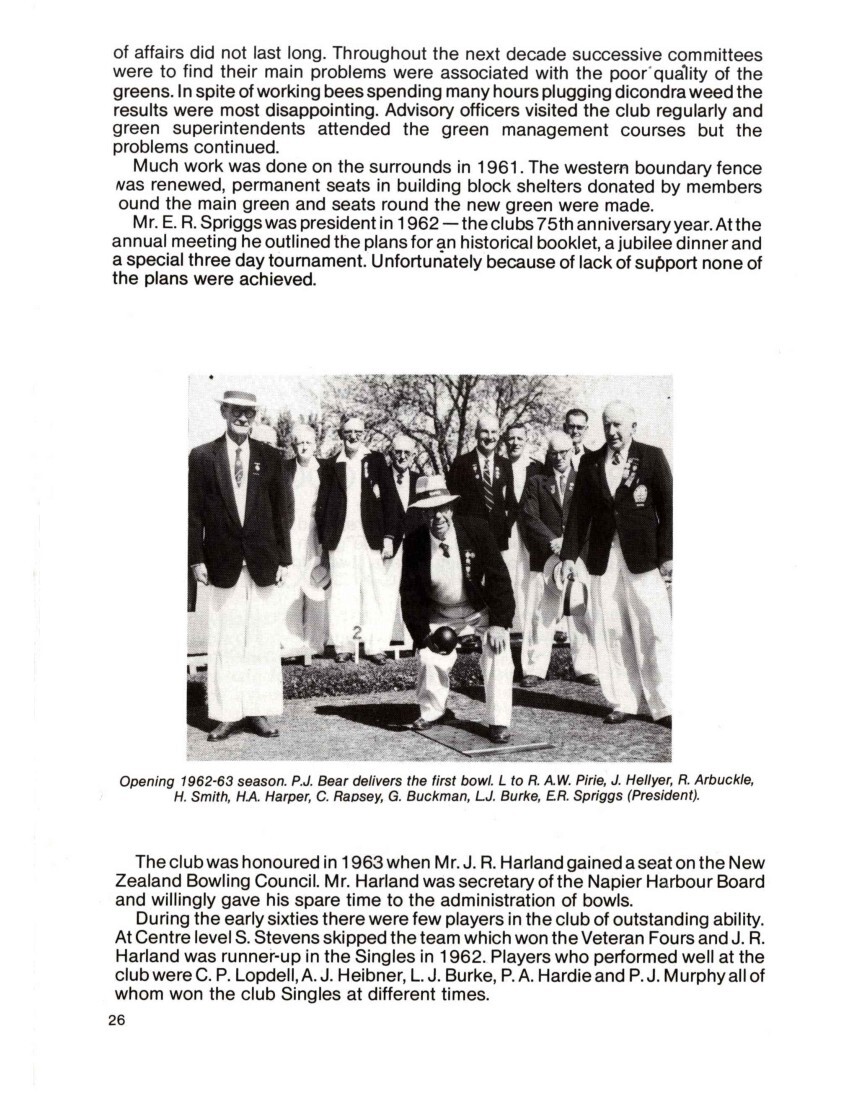
Page 27
FURTHER ATTEMPTS TO SECURE ALTERNATIVE GREENS
With a membership of 105 and a full quota of 55 women pressure was again placed on the club’s facilities in 1963. With the additional problem of maintaining good playing surfaces it was decided to seek new premises again. Approaches were made to the City Council but their offer of land in the Marewa plantation was unsuitable. Two years later Mr. W. S. Harper approached the Council for accommodation in the newly established Onekawa Park. At first the Council approved but later changed its policy over the use of that park for organised sport and the Napier Bowling Club was to continue its activities at Nelson Crescent.
The first suggestion of securing the Faulknor property on the western boundary of the club’s green came up at the annual meeting in 1966. On the site was a large building used as a joinery factory. With the opening of the Onekawa industrial area the City Council zoned the land near the greens non-industrial thus the owners of the Faulknor property would have to move sometime in the future. The club made a move to buy the property in 1973 when a sub-committee of Messrs G. A. Faulknor, A. S. Alsop and P. J. Murphy was given authority to approach the Faulknor Construction Company seeking first refusal on the land if they decided to sell. As their lease was to continue for another year and there was talk of flats being built on the site the matter was dropped in the meantime.
Meanwhile the club approached the City Council for land in the new Pirimai Park. Mr. G. A. Faulknor drew up plans for three greens and submitted them to the Council. Again the club was to be disappointed when in 1975 the Council decided to reduce the size of the park to make more residential sections. The Council did offer an area of land in Anderson Park which was formerly the Napier Park Race Course. The committee led by president Mr. W. K. Hall met the Council on two occasions but the price asked for the rent of the land and for off street parking was so high that the club decided that with the possibility of securing the Faulknor site in the near future, the acceptance of the Council’s offer of Anderson Park be shelved in the meantime. This was a big disappointment to Mr. Hall who had worked hard to make satisfactory arrangements with the Council. However many members considered that by remaining on their historic site, the club could better preserve the unique quality of good fellowship, co-operation and loyalty of which members were very proud.
Hard work was still necessary to keep the Nelson Crescent greens up to standard. With the success of the cotula weed elsewhere it was decided to use it permanently in 1967. Omarunui donated their cotula groovings in April and £30 was spent on more to cover the greens. From then on the condition of the playing surfaces was to improve.
In 1967 Mr. P.M. Dunn, who had already had experience at Wairere was appointed greenkeeper. Until his retirement in 1977 he worked conscientiously for the welfare of the club. He knew how to manage the new cotula weed. From 1966 to 1968 the playing surfaces improved greatly. In 1967 over 50,000 cotula plugs were sown. Much of the success in the establishment was due to the untiring efforts of Mr. A.L. Thomson who was to remain green superintendent until he was
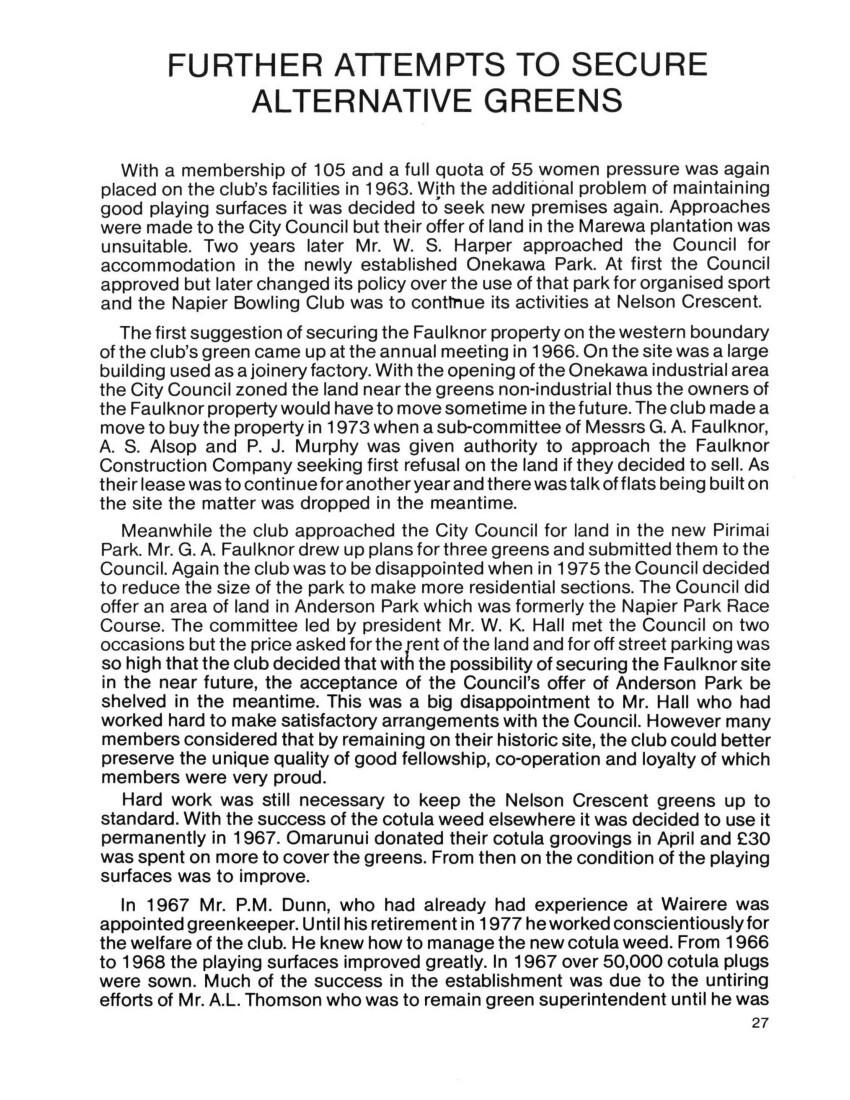
Page 28
succeeded by Mr. L. Lannie in 1977. Living close to the greens he was prepared to give long hours to them. In his quiet way he organised working bees and secured the co-operation of members in securing good playing surfaces. By 1968 the cotula greens were well established giving excellent playing surfaces.
With the greens in good condition more attention was given to improving the surrounds in 1969. Seats between the greens were erected and paths concreted. A new entrance gate was donated by Mrs. Margaret Clay to replace the old wooden one leading into Nelson Crescent.
In 1969 Mr. P. J. Bear died at the age of 95. To the end he was a keen club man. During his later years he walked regularly from his home in May Avenue to enjoy the fellowship of the club. Born in 1874 Percival James Bear became a member of the club in 1905. He joined the management committee as secretary in 1914 and served as secretary for 22 years and was joint secretary-treasurer for 15 of them. It was he who helped the club through the difficult depression years. From 1919 he was also secretary of the East Coast Centre and continued when it became the Hawke’s Bay Centre in 1933 until 1948. He was an excellent draw player with his lignum vitae bowls. For many years he was lead in H. Bull’s champion fours team. After his death club members subscribed to a cup in his memory for the winner of the Intermediate Pairs. His photograph has an honoured place on the wail of the upstairs room. The Centre has also perpetuated his name on a trophy for a midsummer pairs competition.
During the sixties there were several players who performed very well. P. A. Hardie brought honour to himself and the club by winning the Centre Champion of Champion Singles in 1966. At club level he skipped the Champion Fours team in 1969 and in 1964 and 1966 he won the club Singles. G. M. Ruscoe won the Singles in 1968 and again in 1970 and with H. Harper the Pairs in 1965. Perhaps the best skip of the time was C. B. Lopdell who led his team to victory in the club Fours in three successive years from 1965 to 1967. In his teams were R. Arbuckle, A. L. Thomson, G. A. Faulknor and A. Reid. All were very good players. A.L. Thomson was to win the Singles in 1967.
With Mr. A. L. Thomson as green superintendent and Mr. P. M. Dunn as greenkeeper the club was to enjoy a satisfactory period of good greens in the early
Photo caption – Winter Bowlers 1969.

Page 29
1970’s. Mr. Dunn was dedicated to his work and spent many hours beyond his contract to ensure good playing conditions. Mr. Thomson, by consultation with experts from the New Zealand Turf Culture Institute skillfully managed the cotula greens. During this time further additions were made to the equipment shed to keep topdressing soil under cover.
After a special meeting in 1972 the rules were brought up to date. The chief amendments were to define life membership and to alter slightly the nomination of officers. In future before becoming president a member must have served at least one term as a member of the committee within the previous three years.
When walk shorts and long hose became an acceptable form of dress in the early seventies, a proposal by Mr. S. G. Priest at the 1971 annual meeting to wear shorts on week days was approved. However when the Centre gave approval in the following year, the club fell into line and at the annual meeting in 1973 club members were given authority to wear shorts as an alternative to long whites.
Longevity is associated with bowling clubs. The Napier Bowling Club has had many such ‘Old Boys’. In 1972 Mr. A. E. Hollay on his 94th birthday was given a party at the green by winter bowlers. He had been secretary from 1943 to 1950 and had a wide range of interests in the community. He continued his interest in the club until his death in 1973.
In 1969 Mr. P. A. (Angus) Hardie was honoured with life membership. He joined the club in 1937 and was still a regular player at the time of writing. He continues to cycle regularly from his home in Veronica Avenue to enjoy his game at the green and the social hour after. In 1983 he was lead in the Champion Fours team skipped by E. Butler. He served the club as secretary from 1963 to 1968 and again from 1973 to 1977 and was always available to help with work on the greens or in the pavilion. Perhaps his greatest achievement as a skip was the winning of the Webber Shield in February 1964 with F. Hodgman, L. J. Burke and J. Lowes.
Photo caption – Winners of the Webber Shield, February 1964. F. Hodgman, L.J. Burke, J. Lowes, P.A. Hardie(s).

Page 30
THE RESTORATION OF LIQUOR SALES
It was at the annual meeting in 1973 that the club considered the re-introduction of the sale of liquor. After speakers pointed out the financial advantages of selling liqour, Mr. G. A. Faulknor moved and Mr. A. S. Alsop seconded ‘that the incoming committee investigate the introduction of bar facilities in the club for a social hour after play’. The motion was passed but not unanimously. In July Mr. Faulknor drew up plans for altering the pavilion to allow for the inclusion of a bar. At a special meeting held on the 18th August 1973 the introduction of bar facilities was approved by a majority of 31 to 19. The sale of liquor was legal provided a special booth licence was obtained from the Licensing Authority for each time the bar opened. Work on the alterations began at once and were completed soon after the opening of the new season. A social committee of Messrs. A. S. Alsop, D. N. Crawford and G.A. Faulknor was appointed and liquor was on sale again for the first time since the closing of the ‘library’ in July 1930. Revenue from the bar was to make a valuable contribution to the club for extensions made later.
In the early 70’s there was a marked improvement in the standard of play. New players including G. T. Wagg, R. M. Dunn and K. J. Greeks all comparatively young men, were to bring honour to the club in representative matches for Hawke’s Bay. Much credit for this must go to the official coaches of the time. Messrs. A. L. Thomson, G. M. Ruscoe and N. J. Bartle freely gave their time and knowledge to members. Later as sole coach, Mr. N. J. Bartle an excellent draw player himself, unselfishly devoted hours through both summer and winter to ensure that all players were well versed in the basics of the game. At the time of writing he continues with his coaching as his contribution to the welfare of the club. As a competitive player he had few equals. He won the Singles title in 1971, 73, 74, 78 and again in 1982. With his many wins in club and centre fours and pairs he was the best player of the period.
Other players to achieve club honours were J. N. Morris, J. R. Harland, E. N. Butler who was Singles Champion in 1969, P. M. Dunn, A. L. Thomson, R. Arbuckle, R. M. Dunn who was a most promising junior and G. T. Wagg who was to win his first club title in 1974 and his first Centre title in 1975 as Junior Singles Champion.
GROWTH AND DEVELOPMENT
Much of the committee business in the 1974-75 season was considering the possibility of transferring to Pirimai Park and Anderson Park as previously recorded. At the annual meeting in 1975 Mr. A. L. Thomson after having been a member for 27 years was elected a life member. He had been president in 1973 and continued to give valued service as green superintendent. The popular mixed tournaments introduced two years previously were continued on the first Sunday of each month and the club spirit was never better. Winter bowls continued to be popular on the small green with all rinks full on most days. The bar, re-opened in 1973, showed a profit of $2281 in the 1975-76 season. A spirit of goodwill was maintained during the presidencies of both Mr. A. Reid and Mr. W. K. Hall. The club’s funds were in the capable hands of Mr. B. G. Silk, the treasurer and Mr. P. A.
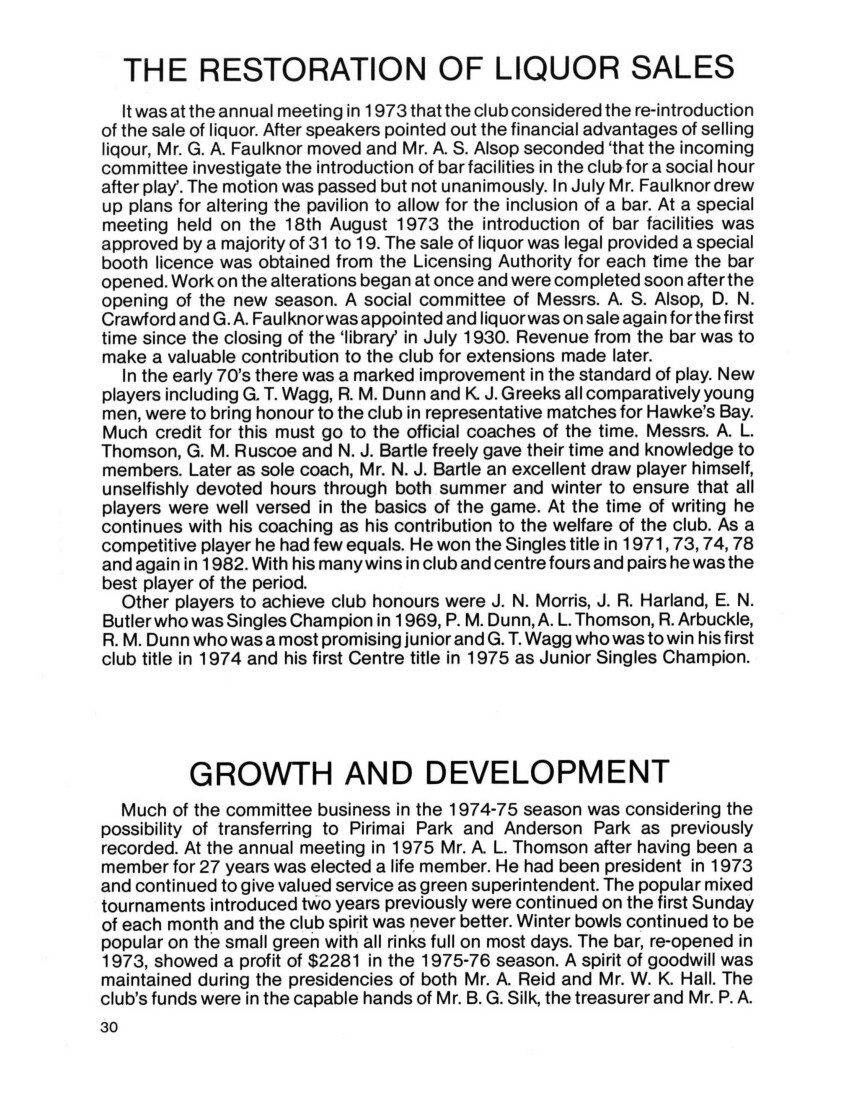
Page 31
Hardie was an efficient secretary. A centennial fund was started by a donation of $65 by Mr. P. Brennan, the amount of his account for paint work done on the pavilion.
In April 1977 a small committee was set up to approach the Faulknor Estate Trustees again to fully investigate the possibility of buying the Faulknor property. The committee reported back with the information that the trustees were prepared to offer first refusal to the club for $40,000. The committee considered the offer and Mr. P. M. Higgins, on behalf of the club, prepared a feasibility study in considerable detail to present to members. Accordingly a special meeting was held on the 10th October 1977 to make a final decision. Mr. W. J. Mason the president, gave members the opportunity to discuss the matter in full. Finally it was resolved that the proposal to move to Anderson Park be rejected, that the proposal to purchase the Faulknor Estate site for $40,000 be dropped because of the club’s inability to finance it and that the committee explore ways and means of improving the present property. A year later the Napier City Council purchased the Faulknor property to build a complex of high density housing.
Now that it was finally decided to remain as a small club in Nelson Crescent, attention could be given to permanent improvements to the club property. In the winter of 1978 the banks of No. 1 green were renewed in concrete with rubber facings by voluntary labour under the direction of Mr. G. A. Faulknor. Consideration was given to demolish the old pavilion and to build a new one on either the winter green which would have deprived members of one of its most popular amenities or on No. 3 green for which the Council was prepared to give approval. Both options were waived when upon close examination, the old pavilion was found to be in very sound condition. The committee decided to set about making alterations and additions to the ground floor.
Major alterations were started in the winter of 1979. Plans were drawn up by Messrs Wagg and Faulknor and the work was done by a skilled tradesman paid by the hour. Some assistance was given by member working bees. The whole area was completely altered and enlarged. A new bar with the latest equipment and the social room was extended towards No. 1 green replacing the former women’s room which was rebuilt at the other end of the building. The lounge, painted and
Photo caption – Club rooms after renovations, 1980.
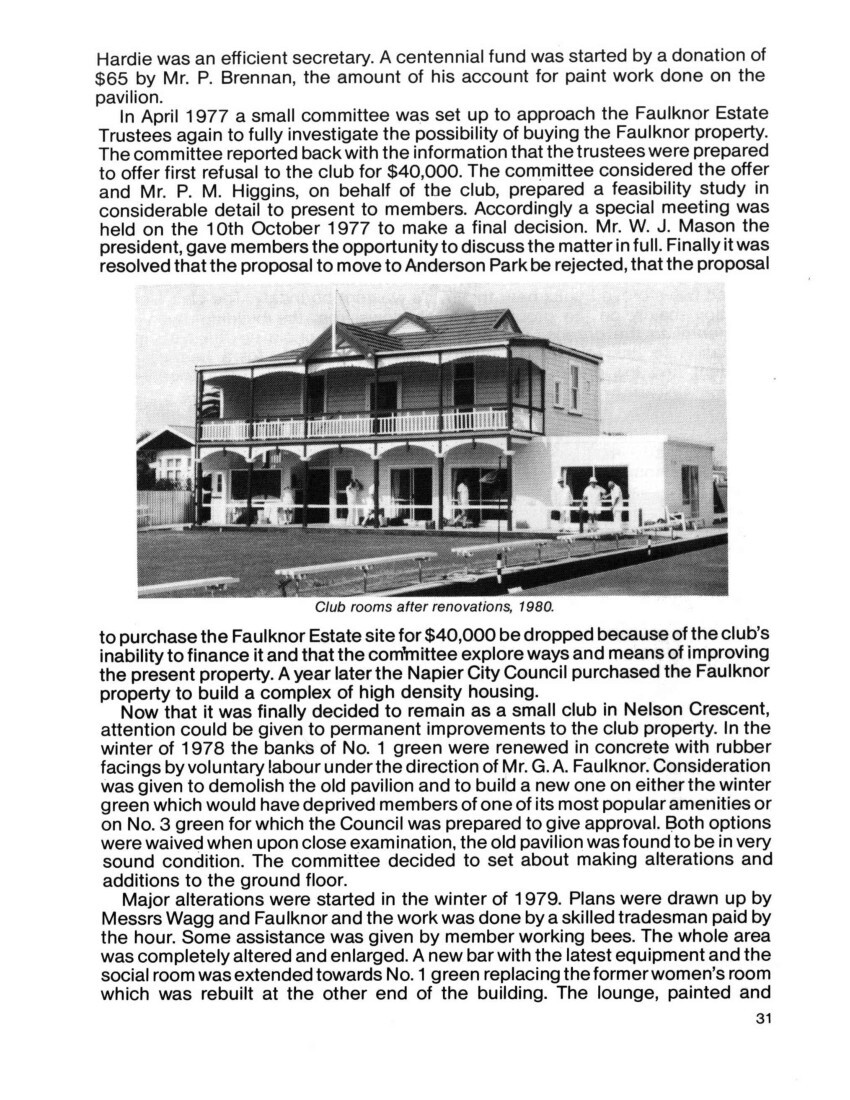
Page 32
decorated by Mr. P. Brennan, with large ranch style doors over-looking the greens and with attractive blue carpet and curtains supplied by the women’s club to match, was a most valuable asset to the club.
The project was financed mostly from club funds. Overdraft facilities were arranged with the Bank of New Zealand but were not used to their limit. The response to a request for donations and short term loans from members was far beyond the committee’s expectations so it was decided to re-roof the building in decromastic tiles. The whole project was completed at a cost of $19,000 and the new amenities were officially declared open by the president, Mr. B. G. Silk on the 22nd March 1980.
While reconstruction was going on with the pavilion the City Council submitted plans for the erection of twelve housing units on the Faulknor site. These plans showed two-storeyed units near the club’s western boundary. The club filed an objection mainly on the grounds that shadows from the buildings would be detrimental to the greens. The objection was not upheld so the club made application to the Town and Country Planning Authority for a hearing. The president and the green superintendent appeared before the authority and presented evidence in a very professional way backed up by support from the New Zealand Turf Culture Institute. Regrettably for the club the Authority ruled in favour of the Council. The houses were erected over the 1980-81 season and as pointed out by the club’s experts did cast shadows on the greens causing inconvenience to winter bowls and the retarding of growth on the western side of No. 1 green.
In December 1978 the club became a member of the Sporting Clubs Association of New Zealand (SCANZ) set up to look after the interests of affiliated
Photo caption – Winners H.B. Champion of Champion Fours, 1980-81. G. T Wagg(s), R. M. Dunn, J. P Hayes, N .J. Bartle.
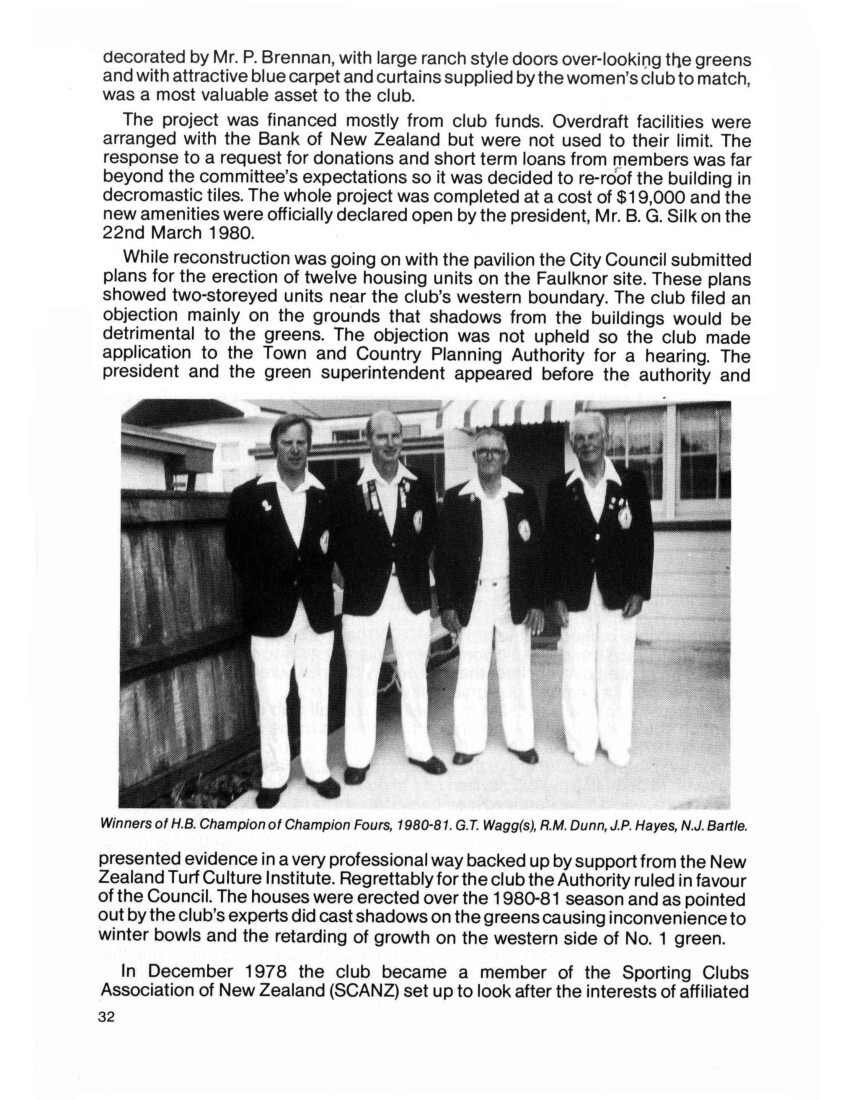
Page 33
clubs particularly those with bar facilities. They did much to persuade the government to liberalise the licensing laws for the benefit of sporting clubs. Extended hours were granted to the club and members who did their social drinking elsewhere began using the club’s amenities to the financial benefit of the club.
The 1979-80 year had been one of considerable development. Members gave full support to the energetic president, Mr. B. G. Silk in upgrading the club amenities. In his annual report he stated that membership had again topped the hundred mark. He attributed the good state of the greens to the hard work and dedication of Mr. L. Lannie. Mr. Lannie, formerly in charge of the City Council Parks and Reserves, had succeeded Mr. A. L. Thomson as green superintendent in 1977.
Two further members were honoured with life-membership in 1980. Both Mr. G. A. Faulknor and Mr. A. S. Alsop had served the club well. The Faulknor family had had a long association with the club. George’s grandfather joined in 1890 and served on the executive from 1896 to 1898. His father Mr. T. F. Faulknor was president in 1925-26. George served on the executive from 1954 and was president in 1970-71. A very capable organiser and skilled tradesman, he had been involved in almost every project carried out during his time on the committee. Alf Alsop joined the executive in 1963 and served continuously until 1982. He was president for two terms and never hesitated to give help in renovating greens, painting, shovelling concrete and the host of other activities in running a bowling club.
For the first time in the 1979-80 season a fixture and membership card was produced for each member. They were well received and are now printed annually.
In the early 1980’s the club made steady progress. Membership remained about the 100 mark and in spite of increasing costs of green maintenance and labour the treasurer, Mr. S. G. Pearce was able to report continuing improvements in club finances. The rapid decrease in the value of the New Zealand dollar necessitated a substantial increase in the members subscription in 1981 and again in 1982.
During this period there was a great improvement in the standard of play. In both 1980-81, 1981-82 G. T. Wagg, K. J. Greeks, G. C. Robinson and J. Gasson earned places in Hawke’s Bay Centre teams. At the club closing ceremony in 1982, Mr. A. A. Johnston, the Centre president presented G. T. Wagg with a Centre gold star badge for having won five Centre titles. At club level there were many good players. R. M. Dunn was to win the Singles title in 1976, 79, 80 and 81 as well as being a member of the Champion Fours team on three occasions. N. J. Bartle as mentioned previously won the Singles in 1982. He was a member of the Champion Fours team from 1977 to 1981 and was lead in the Champion Pairs teams in 1970, 74, 75, 76 and 79. Few players had had such an outstanding record in the club since H. Bull in the 1920’s. G. C. Robinson joined the club in 1975 and soon showed his potential as a bowler of exceptional ability. After winning the Junior Singles in 1978 and 1980 and the Intermediate Singles in 1979 and 1980 he was promoted to skip and his record as skip of winning teams in pairs, triples and fours was a most impressive one. His team of W.J. Mason, W.K. Hall, and K.J. Greeks won the Centre Champion of Champion Fours in 1982. With K.J. Greeks as lead in 1981 he won the Centre Championship Pairs.
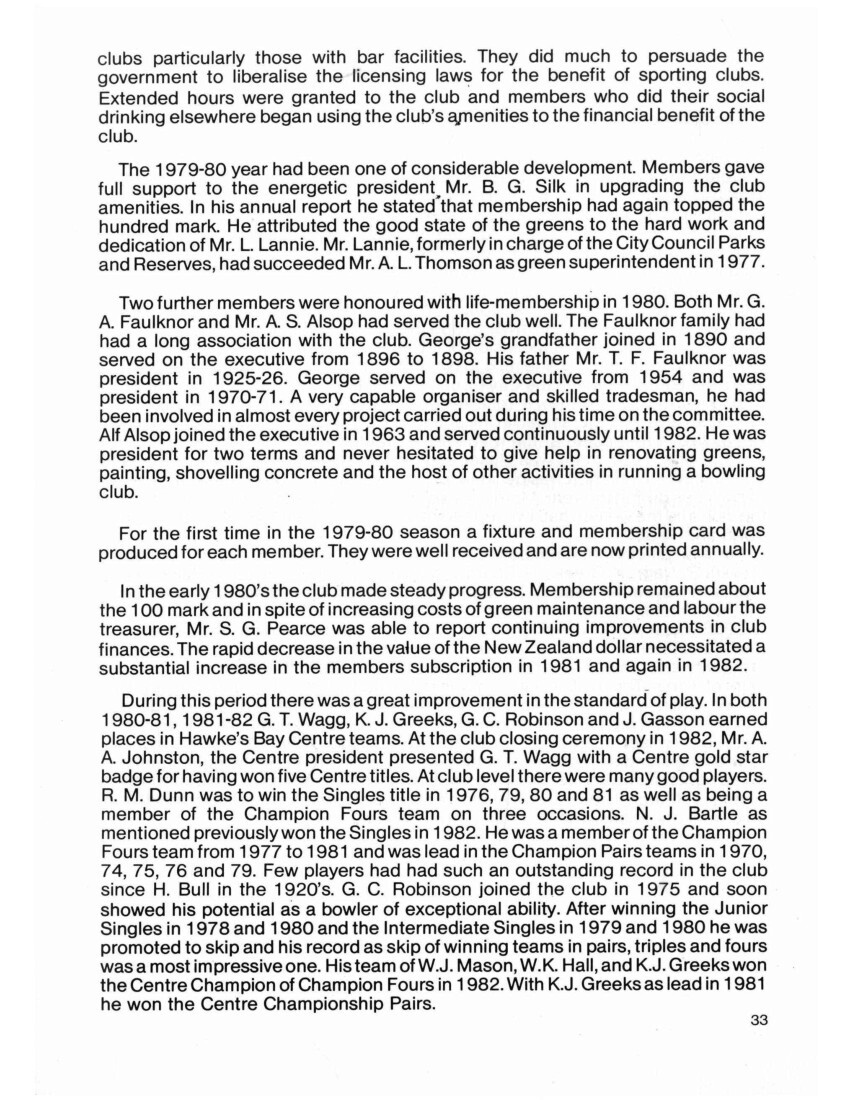
Page 34
RECENT HISTORY
The summer of 1982-83 was the driest in Hawke’s Bay for several years. It was unfortunate that the greens did not receive enough water at the correct time in January to sustain cotula growth. The greens deteriorated so much that many players went elsewhere. Mr. E. Bradley was appointed greens superintendent in March 1983 and began renovations. In spite of his and his willing helpers’ work the greens had not improved in the next season. Mr Bradley resigned and Mr. P. Coyle took on the responsibility. Although the playing surface had improved in 1984 it was not up to the required standard. The following year the No. 1 green was completely renovated. Until Mr. E. Bradley again took on the job of looking after the greens in May 1985 Mr. S. G. Pearce was in charge. Mr. P. Coyle had resigned in February 1985 for business reasons.
When winter bowls began in May 1985 the green was in excellent condition and working bees under the supervision of Mr. W. Wallace had renewed the western bank in concrete and the side next to No. 1 green in concrete blocks. After several years of negotiations with the City Council over the north-western boundary fence the Council agreed to renew it from Nelson Crescent to the end of No. 1 green. The entrance drive-way was sealed in the spring of 1985 and new gates donated by Mr. C. Findlay were erected at the road end of the driveway.
From May 1984 there was closer co-operation with the women’s club in the conduct of club affairs. It was decided to have joint committee meetings informally three times during the year. More sponsored mixed tournaments were held within the club and the women had two representatives on the winter bowls committee in 1985 and 1986.
For a small club the members continued to play well in outside competitions. Messrs G. Wagg, K. Greeks, H. Chard and E. Bradley were selected in Hawke’s Bay teams. In November 1985 G. T. Wagg won the Centre Open Singles to continue as the outstanding player in the club’s recent history.
1985 was a year of considerable activity in the pavilion and round the greens. A new committee with Mr. J. E. Hunt as president was elected in May 1985. A programme for improvements was drawn up and Mr. K. Beattie was appointed clerk of works. The upstairs kitchen was renovated. Most of the work was done by Mr. W. Wallace with the help of committee members. The upstairs lounge was carpeted and a big painting programme under the supervision of Mr. P. Brennan had the premises in first class order for the opening of the 1985-86 season.
The long standing problem of getting water on the greens in the right quanitites [quantities] at the right time was hopefully solved with the installation of an automatic sprinkler system in March 1986. Over half of the $6,000 for installing the equipment was paid from donations. The rest came from debentures.
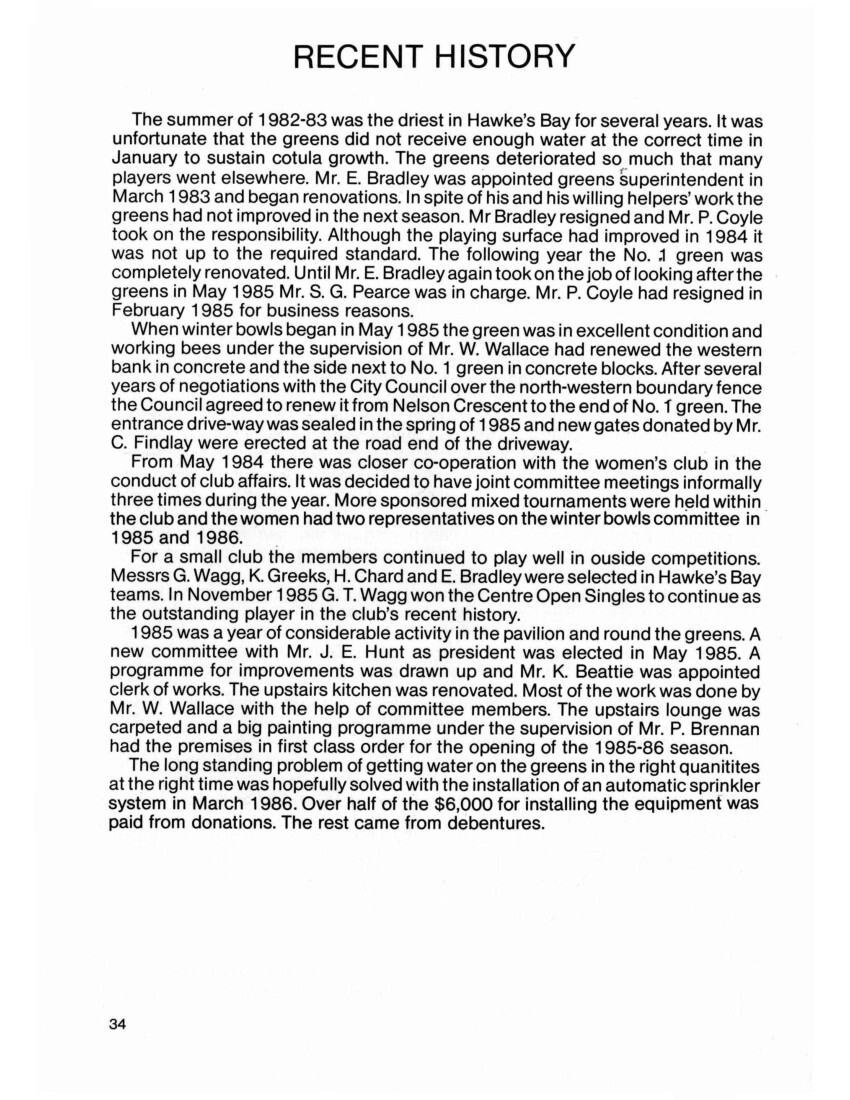
Page 35
CENTENNIAL CELEBRATIONS
As far back as 1978 the club committee decided to make a feature of the club’s centennial in 1987.
The accumulation of money for a special centennial fund began in 1977 by a donation from Mr. P. Brennan and with the proceeds from the “bandit” machine in the club rooms. Investments of these funds and some donations had reached over $5,000 at the time of the Annual General Meeting in 1986. This gave a satisfactory base for plans for the Centennial Celebrations.
At the first committee meeting after the 1986 Annual meeting a special Centennial Committee was formed. Mr Gordon Steele accepted the position of chairman with Messrs Stan Pearce, Ray Reid, Hilton Chard and Phil Coyle as members with power to co-opt.
It was agreed that there be three main tournaments catering for as wide a range of players as possible.
1. An open tournament from 5th to 8th November 1987.
2. A mixed tournament 26th and 27th December 1987.
3. A graded tournament 17th and 18th February 1988.
All tournaments would be advertised widely with substantial prizes.
In addition, the club would hold several one day tournaments to cater for members of the club and friends who did not wish to enter the major ones.
The intention is to have a Centennial Dinner or Social Evening on Saturday 7th November 1987 to which bowling personalities and civic dignitaries would be invited.
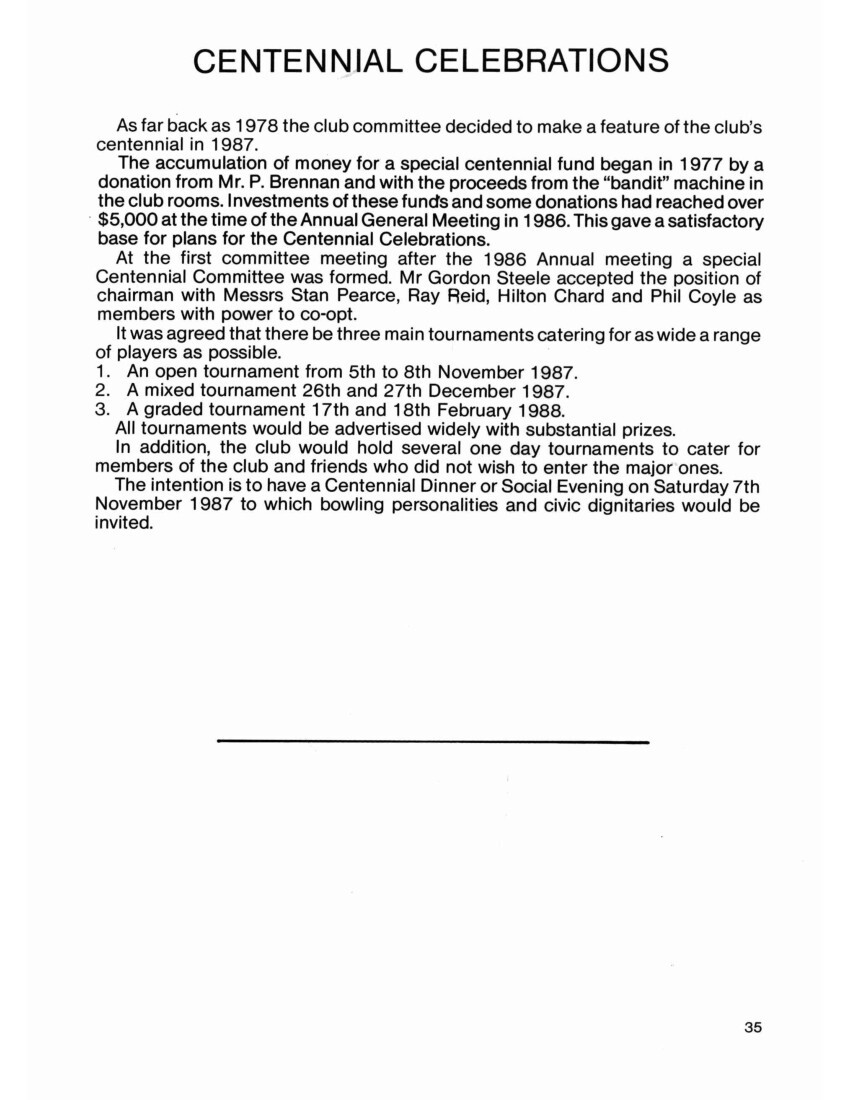
Page 36
APPENDICIES
1. PRESIDENTS
1887-88 HITCHINGS T. H.
1888-89 HITCHINGS T. H.
1889-90 BALFOUR T. W.
1890-91 DINWIDDIE P.
1891-92 LYNDON E.
1892-93 McVAY J. C.
1893-94 EDWARDS C. H.
1894-95 BEATSON J.
1895-96 SHIRLEY T. A.
1896-97 SHIRLEY T. A.
1898-99 MOELLER F.
1899-00 EVANS E.
1900-01 FIELDER J. H.
1901-02 DEAN J. H.
1902-03 REVANS S. S
1903-04 STEDMAN A.
1904-05 THOMSON J. P.
1905-06 ASHER J. A.
1906-07 BEECHAN K.
1907-08 WILLIAMSON J. P.
1908-09 McVAY J. C.
1909-10 BULL H.
1910-11 WILLIAMS F. C.
1911-12 HOLT R.
1912-13 RUNCIMAN R. C.
1913-14 YATES W. C.
1914-15 YATES W. C.
1915-16 TRESTON M.
1916-17 BEAR P. J.
1917-18 BEECHAM K.
1918-19 CUNNINGHAM C. St J.
1919-20 TUCK S. H.
1920-21 BARRY P.
1921-22 ANDREW J. B.
1922-23 EVANS D. A.
1923-24 BADLEY C.W.
1924-25 THORP R.
1925-26 FAULKNOR T. F.
1926-27 SCHMOLL C. L.
1927-28 HARRIS S.
1928-29 GOODGER R. W.
1929-30 RENOUF A. E.
1930-31 PIRIE A. W.
1931-32 PIRIE A. W.
1932-33 LYDFORD W. F.
1933-34 DAILY F. T.
1938-39 KILPATRICK A. J. M.
1939-40 NUTTALL H.
1940-41 SPRIGGS E. R.
1941-42 FINDLAY C. S.
1942-43 KILPATRICK A. J. M.
1943-44 KILPATRICK A. J. M.
1944-45 McGLASHAN R.
1945-46 TIMMS F. A.
1946-47 WILLIAMS T. A.
1947-48 HARLAND J. R.
1948-49 BOLT T.
1949-50 McINTOSH S.
1950-51 McINTOSH S.
1951-52 McINTOSH S.
1952-53 McINTOSH S.
1953-54 McINTOSH S.
1954-55 McINTOSH S.
1955-56 ANDERSON C. F.
1956-57 TANNER C. E.
1957-58 CULLIFORD A. F.
1958-59 LEWIS L. R.
1959-60 RUSCOE [RUSCOE] G. M.
1960-61 HARPER H. A.
1961-62 BURKE L. J.
1962-63 SPRIGGS E. R.
1963-64 ARBUCKLE R.
1964-65 HARPER W. S.
1965-66 HARPER W. S.
1966-67 ALSOP A.S.
1967-68 ALSOP A. S.
1968-69 HARPAR W. S.
1969-70 RUSCOE R. M.
1970-71 FAULKNOR G. A.
1971-72 BUTLER E. N.
1972-73 MURPHY P. J.
1973-74 THOMSON A. L. W.
1974-75 REID A.
1975-76 HALL W. K.
1976-77 MASON W. K.
1976-78 MASON W. K.
1978-79 SILK B. G.
1979-80 SILK B. G.
1980-81 SILK B. G.
1981-82 MASON W. J.
1982-83 SILK B. G.
1983-84 COYLE P.
1984-85 HUNT J. E.
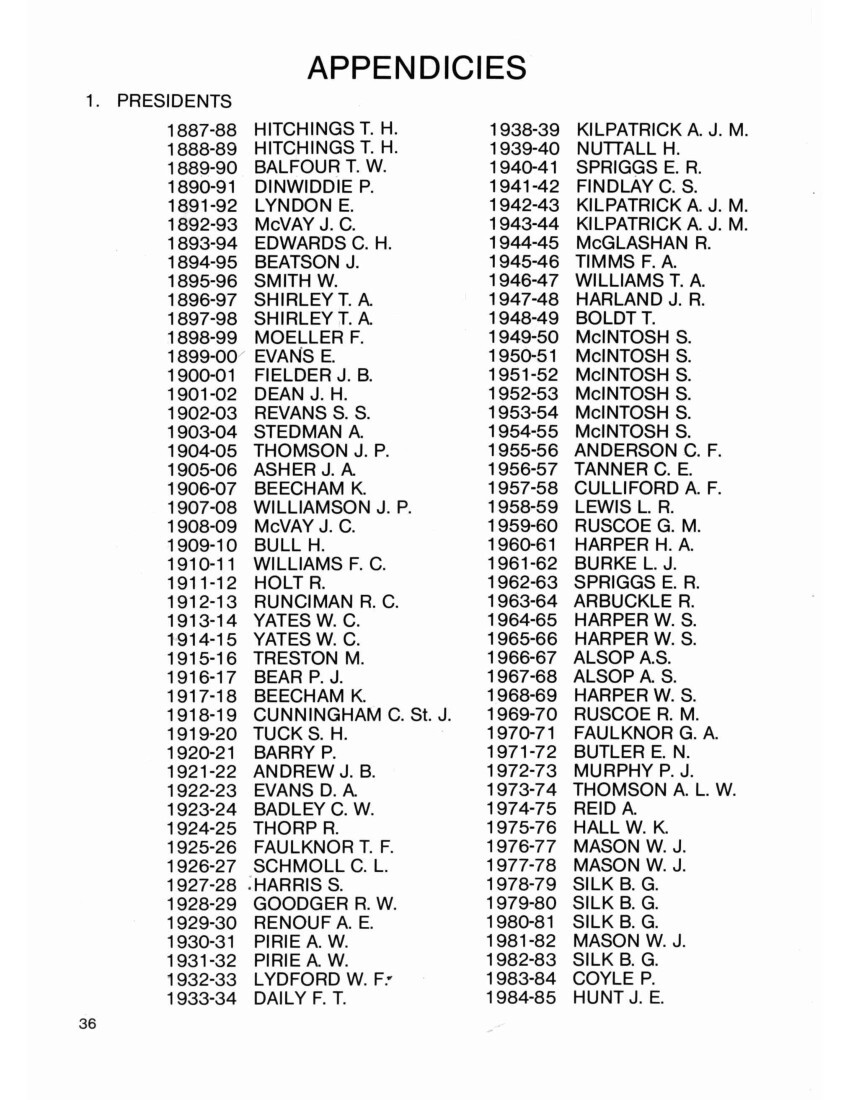
Page 37
1934-35 COOKE G H.
1935-36 McGHEE C. D.
1936-37 COOKE G. H.
1937-38 COOKE G. H.
1985-86 HUNT J. E.
1986-87 REVELL D. G.
2. LIFE MEMBERS
1897 MILLER W.
1910 HODGSON W.
1915 FIELDER J. B.
1919 YATES W. C.
1932 BEAR P. J.
1932 SMITH J. P.
1938 GOODGER R. W.
1945 PIRIE A. W.
1948 PIRIE F. K.
1948 CORNE J.
1951 BOLDT T.
1956 McINTOSH S.
1957 KILPATRICK A. J. M.
1960 DAILY F.
1966 HARLAND J. R.
1969 HARDIE P. A.
1972 HOLLAY A. E.
1972 RUSCOE G. M.
1975 THOMSON A. L. W.
1980 ALSOP A. S.
1980 FAULKNOR G. A.
3. SECRETARIES
1887-91 COOK J. T. C.
1891-1910 HODGSON W.
1910-11 WOODHOUSE A. J.
1911-12 YATES W. C.
1912-15 BEAR P. J.
1915-16 LYDFORD R. L.
1916-19 SAGE J. L.
1919-20 FLYNN J. B.
1920-24 BEAR P. J
1924-25 BRIASCO C. C.
1925-26 WARDELL-JOHNSON H.
1926-41 BEAR P. J.
1941-43 McGLASHAN R.
1943-50 HOLLAY A. E.
1950-52 NEWTON W. P.
1952-55 ZORN O.
1955-58 RUSCOE G. M.
1958-63 ARBUCKLE R.
1963-68 HARDIE P. A.
1968-73 SMITH W. M.
1973-77 HARDIE P. A.
1977-84 REVELL D. G.
1984- SILK B. G
4. TREASURERS
1887-91 COOK J. T. C.
1891-1915 FIELDER J. B.
1915-19 TUCK S. H.
1919-21 DICK J.
1921-26 WILLIAMS F. C.
1926-41 BEAR P. J.
1941-44 PEEL W.
1944-48 KILPATRICK A. J. M.
1948-49 FINDLAY C. S.
1949-52 NEWTON W. P.
1952-55 ZORN O.
1955-56 RUSCOE G. M.
1956-59 MAYO P. P.
1959-61 CULLIFORD A. F.
1961-62 HODGMAN G. F.
1962-65 HOWELL F. A.
1965-67 BUTLER E. N.
1967-72 MURPHY P. J.
1972-78 SILK B. G.
1978-85 PEARCE S. G.
1985- ROBB W. G.
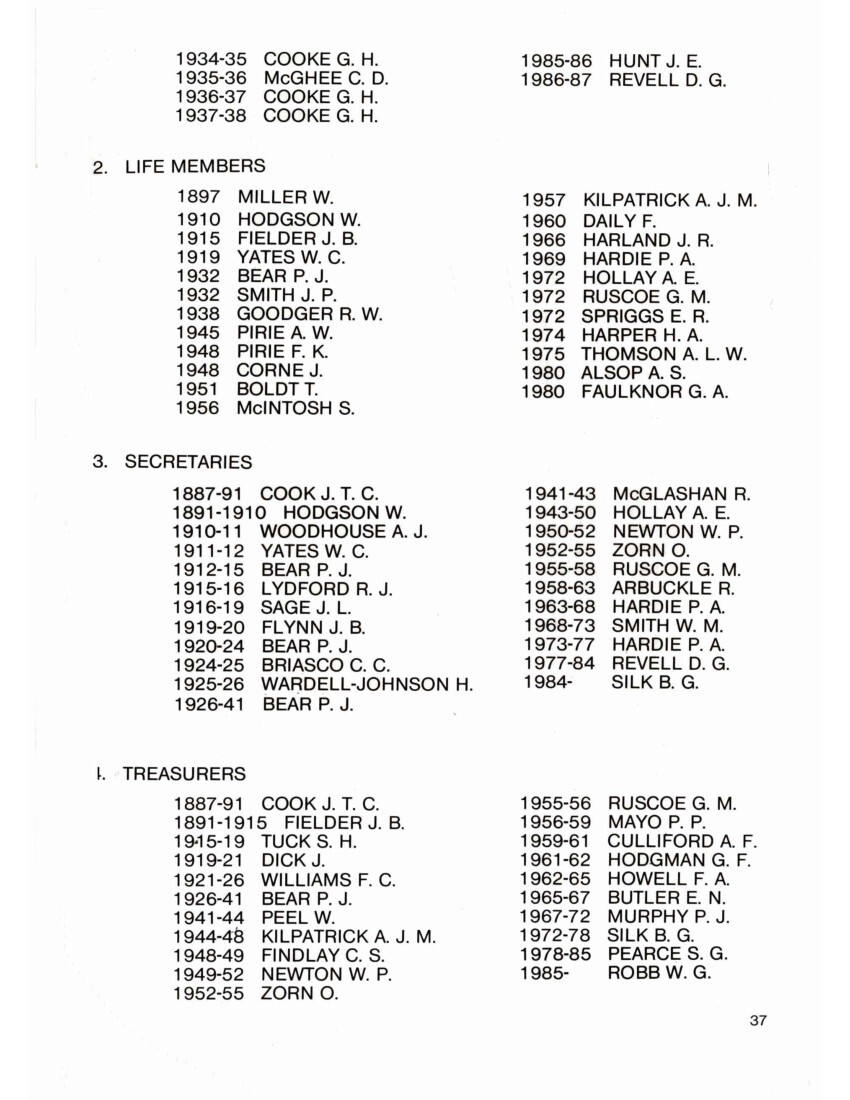
Page 38
5. CHAMPIONSHIP SINGLES
1889 ASHTON W. A.
1890 STUBBS A.
1891 SOUTH G.
1892 STUBBS A.
1893 EVANS E.
1894 SWAN J. H.
1895 SOUTH G.
1896 EVANS E.
1897
1898 STUBBS A.
1899 GILBERD J. G.
1900 YATES W. C.
1901 SWAN J. H.
1902 YATES W. C.
1903 BULL H.
1904 BULL H.
1905 BULL H.
1906 TERRY R. F.
1907 BULL H.
1908 WILLIAMSON J. P.
1909 HAYWARD J. W.
1910 BULL H.
1911 WILLIAMS F. C.
1912 LETHAM W.
1913 BULL H.
1914 ASHER J. A.
1915 BULL H.
1916 TATTLE F. V.
1917 WILLIAMS F. C.
1918 BULL H.
1914 ASHER J. A.
1915 BULL H.
1916 TATTLE F. V.
1917 WILLIAMS F. C.
1918 BULL H.
1919 HAWKE F.
1920
1921 HAWKE F.
1922
1923 EVANS D. A.
1924 EVANS D. A.
1925 YATES W.
1926 PIRIE A. W.
1927 BISSELL E.
1928 EVANS D. A.
1929 HUNT W. F.
1930 HUNT W. F.
1931 Earthquake year.
1932 McGHEE C. D.
1933 BENDALL S. J.
1934 BENDALL S. J.
1935 PIRIE F. K.
1936 BENDALL S. J.
1937 ENGEBRETSEN A. J.
1938 BURGESS N.
1939 BURGESS N.
1940 FRANKLIN J.
1941 NUTTALL H.
1942 BURGESS N.
1943 BURGESS N.
1944 THOMAS R. V.
1945 PIRIE A. W.
1946 BURGESS N.
1947 BURGESS N.
1948 THOMAS R. N.
1949 SNADDON A. C.
1950 SNADDON A. C.
1951 SNADDON A. C.
1952 SNADDON A. C.
1953 SNADDON A. C.
1954 SNADDON A. C.
1955 OLNEY W. D.
1956 SCULLIN B. J.
1957 OLNEY W. D.
1958 ANDERSON C. F.
1959 OLNEY W. D.
1960 LOPDELL C. D.
1961 HEIBNER A. J.
1970 RUSCOE G. M.
1971 BARTLE N. J.
1972 GARNHAM J. H.
1973 BARTLE N. J.
1974 BARTLE N. J.
1975 MORRIS J. N.
1976 DUNN R. M.
1977 WAGG G. T.
1978 BARTLE N. J.
1979 DUNN R. M.
1980 DUNN R. M.
1981 DUNN R. M.
1982 BARTLE N. J.
1983 WAGG G. T.
1984 WAGG G. T.
1985 WAGG G. T.
1986 WAGG G. T.

Page 39
6. CHAMPIONSHIP PAIRS
1938 NUTTALL H. & BEER S.
1939 McNIVEN R. & THOMAS R. V.
1940 McNIVEN R. & THOMAS R. V.
1941 NUTTALL H. & BURGESS N.
1942 SEATON C. & WILLIS A.
1943 WILSON S. & BURGESS N.
1944 PIRIE A. W. & BURGESS N.
1945 PIRIE A. W. & BURGESS N.
1946 BROWN J. & PIRIE A. W.
1947 FINLAY D. & BEER S.
1948 PIRIE A. D. & NICOL S.
1949 BROADHEAD J. & BURGESS N.
1950 SNADDON A. C. & NICOL S.
1951 BURKE L. J. & NICOL S.
1952 HISLOP W. & FULFORD J.
1953 ANDERSON C. & SPRIGGS E. R.
1954 LAWRENCE R. & OLNEY W. D.
1955 LAWRENCE R. & OLNEY W. D.
1956 CAMERON H. & SNADDON A. C.
1957 CARTER C. & BURKE L. J.
1958 FULFORD W. & OLNEY W. D.
1959 MURPHY P. J. & SPRIGGS E R.
1960 COOK W. T. & ARBUCKLE R.
1961 HODGMAN G. F & HARDIE P. A.
1962 BEACH H. & STEVENS S.
1963 ALSOP A. S & HARLAND J. R.
1964 THOMSON A. L & FINCH A. F.
1965 HARPER H. A. & RUSCOE G. M.
1966 BEACH H. & STEVENS S.
1967 HALL W. K. & HARDIE P. A.
1968 ATLEY W. & BLAKIE W.
1969 WIGG E. & ALSOP A. S.
1970 BARTLE N. J. & FITZPATRICK J.
1971 SMITH W. M. & MORRIS J.N.
1972 HARLAND J. A. & SPRIGGS E. R.
1973 OSBORNE A. C. & DUNN R. M.
1974 BARTLE N.J. & FITZPATRICK J.
1975 BARTLE N. J. & FITZPATRICK J.
1976 BARTLE N. J. & FITZPATRICK. J.
1977 SCHOLES M. & ALSOP A. S.
1978 MORRIS J. N. & BUTLER E. N.
1979 BARTLE N. J. & WAGG G. T.
1980 LIGHTBAND A. & CARTER H.
1981 GREEKS K. J. & ROBINSON G. C.
1982 GREEKS K. J. & ROBINSON G. C.
1983 ALSOP A.S & WAGG G. T.
1984 DUNN R.M. & WAGG G. T.
1985 REVELL D. G. & BUTLER E. N.
1986 GASSON J. & COYLE P.
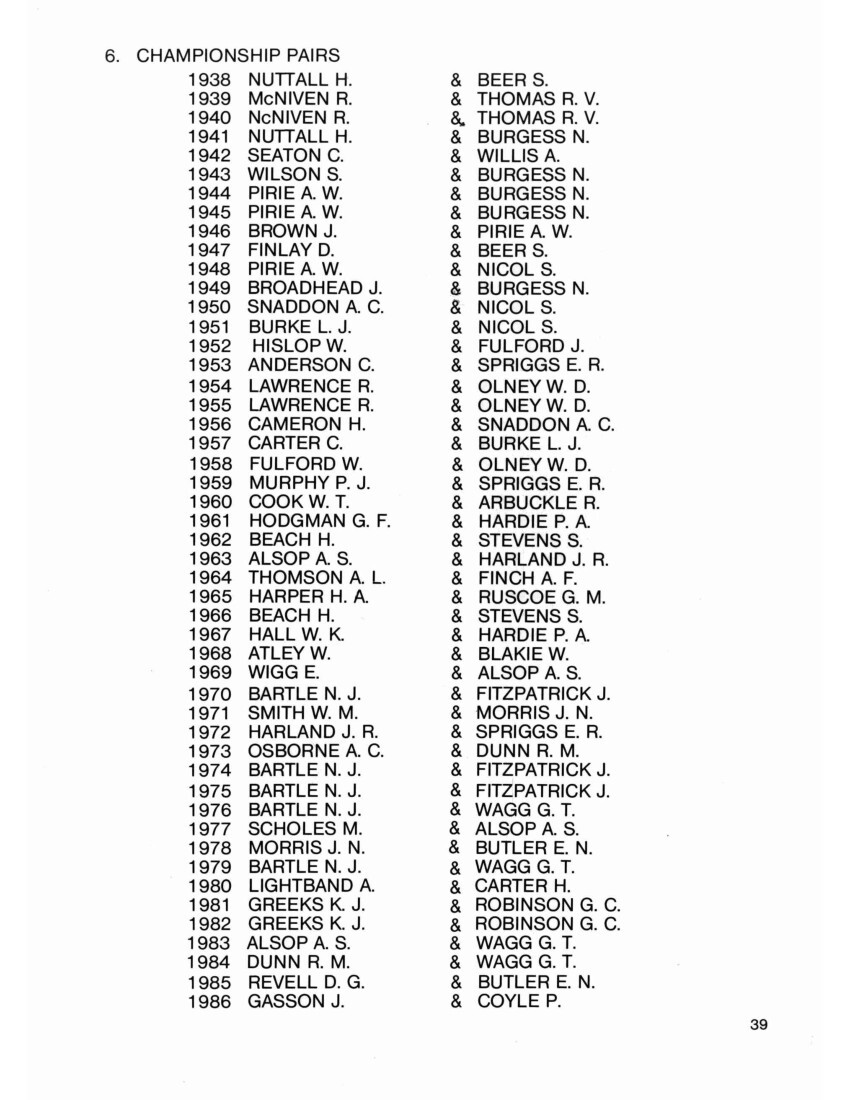
Page 40
7. CHAMPION FOURS
1954 RUSCOE G., HARPER H., CULLIFORD A., LEWIS R.
1955 HEIBNER A., RUSCOE G., LOPDELL C., LEWIS R.
1956 CARTER C., ARBUCKLE R., CAMERON H., SNADDON A. C.
1957 FAULKNOR G., PEED S., FULFORD W., OLNEY W.
1958 GEBBIE A., LAWRIE J., LEE F., CULLIFORD A.
1959 McKENNA P., LEVERETT C., ARBUCKLER R., LOPDELL C.
1960 SNOW C., GEBBIE A., CARTER C., FINCH A.
1961 IVEY G., HODMAN F., CARTER C., MURPHY P.
1962 WATTS J., WATKINS C., PROFFITT L., OLNEY W.
1963 WATTS J., WATKINS C., WIIG E., YOUNG J.
1964 CROSS G., WATKINS C., PROFFITT L., OLNEY W.
1965 FAULKNOR G., THOMSON A., ARBUCKLE R., LOPDELL C.
1966 THOMSON A., FAULKNOR G., ARBUCKLE R., LOPBELL C.
1967 THOMSON A., REID A., ARBUCKLE R.,LOPBELL C.
1968 HALL W. K., RAPSEY C., ATLEY W., MORRIS J.
1969 EVANS L., BEDDOWS A., BUTLER E., HARDIE A.
1970 REID A., WYETH A., ARBUCKLE R., THOMSON A.
1971 HANNAN C., DUNN R., FITZPATRICK J., DUNN P.
1972 HALL W. K., RAPSEY C., SMITH W., MORRIS J.
1973 DUNN R., NICHOLSON C., DUNN P., FITZPATRICK J.
1974 TODD T., NICHOLSON C., DUNN P., FITZPATRICK J.
1975 MASON W., PRIEST S., CRAWFORD D., FAULKNOR G.
1976 BRENNAN P., O’SHAUGHNESSY D., WAGG G., MURPHY P.
1977 ROBINSON G. C., LAMPITT L., DUNN R., WAGG G.
1978 ROBINSON G. C., LAMPITT L., DUNN R., WAGG G.
1979 BARTLE N., LAMPITT L., DUNN R., WAGG G.
1980 BARTLE N., LAMPITT L., DUNN R., WAGG G.
1981 BARTLE N., HAYES J., DUNN., R WAGG G.
1982 HALL W. K., MASON W., GREEKS K., ROBINSON G. C.
1983 HARDIE A., JOHNSON R., HALL W. K., BUTLER E.
1984 QUIRK L., MASON W., GREEKS K., ROBINSON G. C.
1985 QUIRK L., BRADLEY E., GREEKS K., WAGG G.
1986 CHARD H., GASSON J., COYLE P., ROBINSON G. C.
8. INTERMEDIATE PAIRS
FROM 1948 to 1960 for leads, two’s and three’s
FROM 1961 for leads and two’s. Competition discontinued after 1981
1948 HISLOP W. & MOORE S.
1949 HEAD D. & HAGGERTY D.
1950 BURKE L. J. & HARDIE P. A.
1951 PEACE T & WEST A.
1952 CHESNEY R. & PIRIE F. K.

Page 41
1953 ARBUCKLE R. & BURKE L. J.
1954 BAGLEY C. J. & ANDERSON C.
1955 POYNTER H. & FINCH A.
1956 GARDNER H. & HEIBNER A.
1957 SCHOLES M. & MAYO P.
1958 O’BRIEN D. & RENTON M.
1959 ATLEY W. & MURPHY P.
1960 PROFFITT L. & CARTER C.
1961 PIRIE A. S. & O’BRIEN D.
1962 HARPER W. & HOWELL F.
1963 HARPER W. & PIRIE A. S.
1964 WATKINS C. & LAWRIE J.
1965 WATTS J. & BUTLER E.
1966 PRIEST S. G. & HALL W. K.
1967 SCHOLES M. & SNOW C.
1968 WIDERSTROM F. & FRUDE L.
1969 BICK F. & RIGG A.
1970 BURNS F. & LEZARD G.
1971 OSBORNE A. & DUNN R.
1972 OSBORNE A. & DUNN R.
1973 WAGG G. & HAYES J.
1974 WAGG G. & BRACKEN J.
1975 ROBINSON C. J. & WAGG G.
1976 DAVIDSON J. & JOHNSON R.
1977 HUNTER B. & ROBINSON G. C.
1978 ROBINSON G. C. & GREEKS K.
1979 HUNTER B. & ROBINSON G. C.
1980 COYLE P. & GASSON J.
1981 CHARD H. & GASSON J.
9. INTERMEDIATE SINGLES
From 1946 to 1960 for leads, two’s and three’s.
From 1961 for leads and two’s.
1946 CATER E. E
1947 HAGGERTY D.
1948 CAMERON H.
1949 GRANT A.
1950 FINDLAY C. S.
1951 BURKE L. J.
1952 LAWERNCE R.
1953 HUNT W.
1954 FINCH A. F.
1955 HOWES L.
1956 RUSCOE G. M.
1957 GARDNER H.
1958 JAMIESON R.
1959 CARTER C.
1960 BETCHLEY F.
1967 SMITH W. M.
1968 SCHOLES M.
1969 BICK F.
1970 SMITH G. H.
1971 DUNN R. M.
1972 DUNN R. M.
1973 O’SHAUGHNESSY D.
1974 O’SHAUGHNESSY D.
1975 WAGG G. T.
1976 O’SHAUGHNESSY D.
1977 GREEKS K. J.
1978 GREEKS K. J.
1979 ROBINSON G. C.
1980 ROBINSON G. C.
1981 MacKENZIE R.
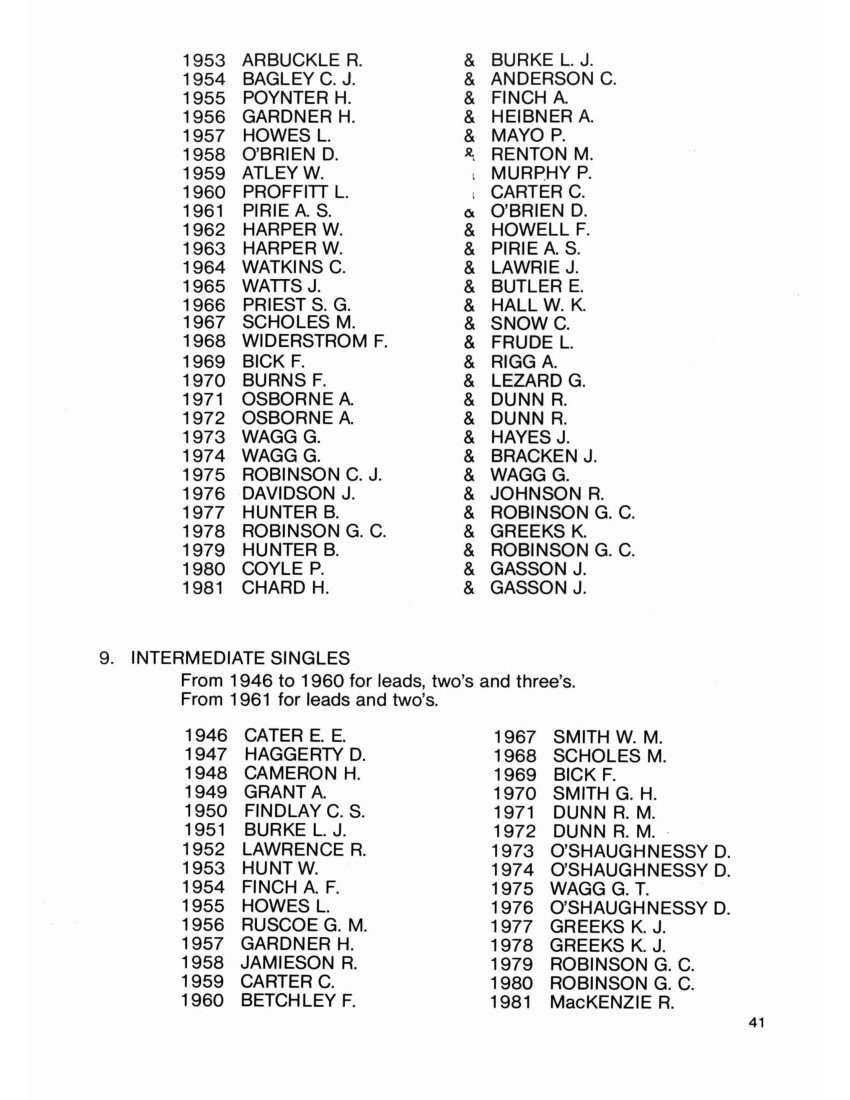
Page 42
1961 O’BRIEN D.
1962 HOWELL F. A.
1963 WILLIAMS F.
1964 WATKINS C.
1966 CRAWFORD D. N.
1982 CHARD H.
1983 WILTON P.
1984 QUIRK L. B.
1985 BEATTIE K. H.
1986 STEVENSON H. C.
10. JUNIOR SINGLES
From 1938 to 1945 for leads and two’s.
From 1946 to 1974 for first and second year players.
From 1975 to 1979 for first, second and third year players.
From 1980 for fifth year players under.
1938 FRANKLIN J.
1939 FRANKLIN J.
1940 McGLASHEN R.
1941 HARLAND J. R.
1942 BURNS J.
1943
1944 CAMERON H.
1945 CATER E. E.
1946 WATKINS C.
1947 WATKINS C.
1948 GRANT D.
1949 BURKE L. J.
1950 FINCH A. F.
1951 ARBUCKLE R.
1952 ALSOP A. S.
1953 HOWES L.
1954 POYNTER H.
1955 HEIBNER A. J.
1956 HEIBNER A. J.
1957 GEBBIE A. E.
1958 ATLEY W. J.
1959 ENNOR J. V.
1960 McIVOR D.
1961 HARPER W. S.
1962 RAPSEY C. E.
1963 CROSS G. G.
1964 STYLES W. W.
1965 FRUDE L. W.
1966 SCHOLES M.
1967 SMITH G. H.
1968 BICK F.
1969 WILKINSON B.
1970 HANNAN C.
1971 MATHESON A. R.
1972 O’SHAUGHNESSY D.
1973 HICKEY A. D.
1974 WAGG G. T.
1975 WAGG G. T.
1776 DAVIDSON J. C.
1977 REVELL D. G.
1978 ROBINSON G. C.
1979 CUNNINGHAM J.
1979 ROBINSON G. C.
1980 GASSON J.
1982 GASSON J.
1983 CAMPBELL W. M.
1984 CHARD G.
1985 CHARD G.
1986 STEVENSON H. C.
11. COLT SINGLES
For first and second year players.
1980 BARKER P. S.
1981 DALLIMORE J.
1982 BRADLEY E.
1983 BRADLEY E.
1984 STEVENSON M.
1985 STEVENSON M.
1986 KNOWLES K.
12. CLUB GRADED FOURS
1965 WIDERSTROM F., RAPSEY C., ATLEY W., BLAKIE W.
1966 PEED S., LEWIS T., ALLAWAY A., FINCH A.
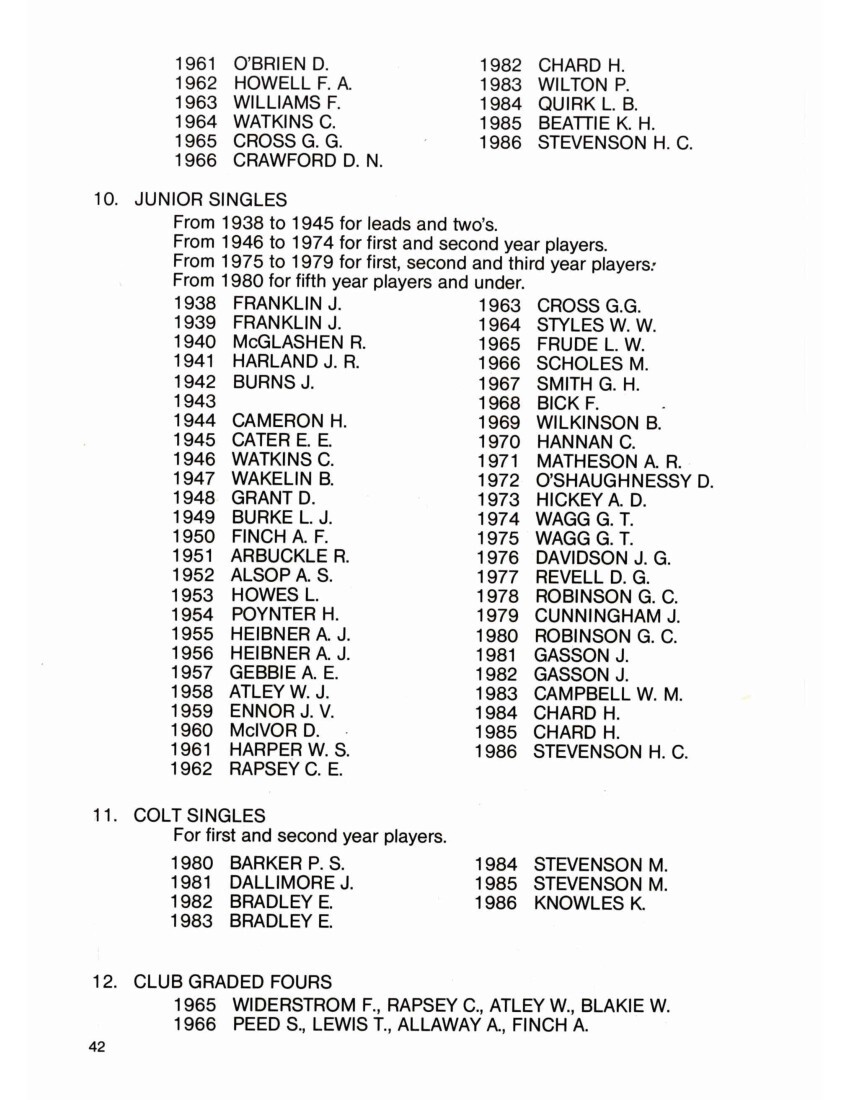
Page 43
1967 MEYER H., EVANS L., LAWRIE J., BUTLER E.
1968 WRIGHT R., BEACH H., PIRIE A. S., THOMSON A. L.
1969 WRIGHT R., WIDERSTROM F., SMITH W., MORRIS J.
1970 DUNN R., SMITH G., SCHOLES M., DUNN P.
1971 NICHOLSON C., DUNN R., O’BRIEN D., BARTLE N.
1972 O’SHAUGHNESSY D., DUNN R., PRIEST S., MORRIS J.
1973 ASHCROFT K., SILK B G., THOMPSON G., SHAW H.
1974 LEMIN H., WAGG G., BURKE L., BARTLE N.
1975 PHILIP R., BURKE L. J., SHAW H., DUNN P.
1976 ROBINSON C. J., ENNOR B. PRIEST S., DUNN P.
1977 ROBINSON C. J., BLENNERHASSETT R., CALLAGHAN P., OSBORNE A.
1978 Not Played.
1979 CAMPBELL W., BEDDOWS T., HAMBLETON S., MORRIS J.
1980 McMANUS C. WYLIE M., LIGHTBAND A., FAULKNOR G.
1981 O’CONNOR B.,WYLIE M., WHARTON J., FAULKNOR G.
1982 DALY F., LAMPITT L., HALL W. K., REVELL D. G.
1983 BURGESS V., GRAHAM R., WHARTON J., SILK B. G.
1984 ROBB G., RITCHIE A., HALL W. K., ALSOP A. S.
1985 STEVENSON H., CURPHEY P., BRENNAN P., FAULKNOR G.
1986 HARDIE A., STEVENSON H., BARKER P., SILK B. G.
13. OPEN TRIPLES
1980 HUNTER B., GREEKS K., ROBINSON G. C.
1981 ASHCROFT K., EDSER R., PRIEST S.
1982 MASON W., GREEKS K., ROBINSON G. C.
1983 MASON W., GREEKS K., ROBINSON G. C.
1984 HALL W. K., McMANUS C., ALSOP A. S.
1985 ROBB G., MacKENZIE R., HAMBLETON S.
1986 CURPHEY P., BRENNAN P., SILK B. G.
14. FAULKNOR CUP
For players 60 years of age or over who have not previously won a club singles competition.
1977 FAULKNOR G.
1978 LAMPITT L.
1979 EDSER R.
1980 ASHCROFT K.
1981 NELSON M.
1982 JOHNSON R.
1983 PARKER R.
1984 Not played.
1985 BEATTIE K.
1986 BURDIS J.
15. HUNT TROPHY
For the most improved player.
1951 PEACE T. A.
1952 HARPER H. A.
1953 HOWES L.
1954 RUSCOE G. M.
1955 RUSCOE G. M.
1956 BEACH H.
1957 PIRIE A. S.
1958 COLLEY D. F.
1959 SLADE B.
1968 HAYES J. P.
1969 THOMPSON A. C.
1970 WHARTON J.
1971 MASON W. J.
1972 BEDDOWS T.
1973 O’SHAUGHNESSY D.
1974 WAGG G. T.
1975 DAVIDSON J. G.
1976 REVELL D. G.
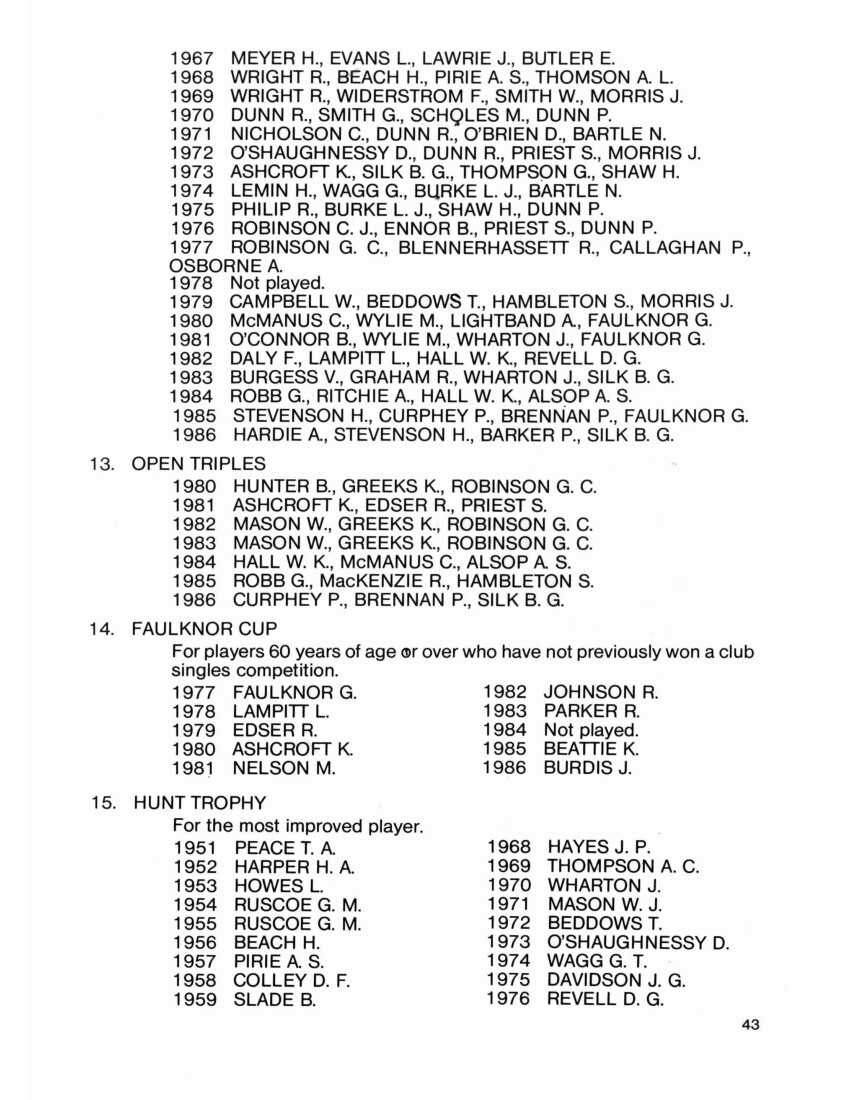
Page 44
1960 ALSOP A. S.
1961 ENNOR W. T.
1962 REID A.
1963 McMAHON J. V.
1964 CROSS G. G.
1965 BUTLER E. N.
1966 BLENNERHASSETT R.
1967 STYLES W. W.
1977 WYLIE R.
1978 ROBINSON G. C.
1979 MacKENZIE R.
1980 HAY G. W.
1981 HIGGINS S. V.
1982 CHARD H.
1983 BRADLEY E.
1984 HANNAH J. A.
1985 BEATTIE K. H.
1986 PRINCE A.
16. JUNIOR PAIRS
For players five years and under.
1982 CHARD H. & GASSON J.
1983 JOSEPHS V. & WHEELER N.
1984 ROBB G. & CHARD H.
1985 GILMOUR P. & CHARD H.
1986 NEAL D. & READE B.
17. WINTER COMPETITIONS
1. HAYES SHIELD.
1972 O’SHAUGHNESSY D., EVANS L., HARDIE A., BUTLER E.
1973 OSBORNE A., PRIEST S., MURPHY P., RUSCOE G.
1974 NATION J., HAYES J., FISHER G., FITZPATRICK J.
1975 O’SHAUGHNESSY D., STEVENS., MURPHY P., HARDIE A.
1976 HIGGINS P., BURKE L.J., BARTLE N., WAGG. G.
1977 CUNNINGHAM J., BRACKHEN J., MURPHY P., ALSOP A.
1978 HIGGINS M., JOHNSON R., CALLAGHAN P., ALSOP A.
1979 MacKENZIE R., HIGGINS S., HARDIE A., BUTLER E.
1980 McMANUS C., RUSCOE R., WHARTON J., BARTLE N.
1981 HIGGINS S., BRACKEN J., HALL K., HAYES J.
1982 HARDIE A., LAMPITT L., HALL K., HAYES., BRENNAN P.
1983 WILTON P., YOUNG L., LAMPITT L., BARKER P.
1984 STEELE G., ROBB G., BEATTIE K., ALSOP A.
1985 VALENTINE S., NELSON M., HALL K., BUTLER E.
1986 McNAUGHT J., STEELE G., HAMBLETON S., BUTLER E.
2. ALBERT WYETH MEMORIAL ROSEBOWL.
1974 BICK F., OSBORNE A., FISHER G., BUTLER E.
1975 HARPER.H., O’SHAUGHESSY D., BEDDOWS A., REID A.,
1976 HUNTER B., WEIR I., HARDIE A., BARTLE N.
1977 RAWLINGS S., CALLAGHAN P., LAMPITT L., HALL K.
1978 CUNNINGHAM J., BURDIS J., LAMPITT L., HALL K.
1979 BEATTIE K., BURKE L. J., ASHCROFT K., ALSOP A.
1980 NELSON M., JOHNSON R., LAMPITT L., PRIEST S.
1981 McMANUS C., HAY G. ASHCROFT K., REVELL D. G.
1982 HARDIE A., HYDE L., RUSCOE R., FAULKNOR G.
1983 ROBB G., HIGGINS S., HAYES J., BUTLER E.
1984 ELVINES B., STEELE G., REANEY H., HUNT J.
1985 LAWSON R., MURTAGH J., HAMBLETON S., FAULKNOR G.
1986 McNAUGHT J., MARTIN L., BEATTIE K., REVELL D.G.

Page 45
3. HAROLD CARTER MEMORIAL CUP
For mid-week mixed triples.
1981 BENNETT M., HYDED L., FAULKNOR G.
1982 LAMPITT L., NELSON M., CUNNINGHAM J.
1983 HIGGINS S., ROBB G., CALLAGHAN P.
1984 BENNETT M., HAY G., ALSOP A.,
1985 LAWSON R.M., BARTLE N., REVELL D.G.
1986 WASHBOURN D., RUSCOE T., BRENNAN P.
18. NEW ZEALAND HONOURS
1909 NORTHERN BOWLING ASSOCATION FOURS
HOLT R., WRIGHTSON A., SMITH J.P., BULL H.
1935 NEW ZEALAND BOWLING ASSOCATION SINGLES (Auckland)
Winner:- ENGEBRETSEN A. J.
1952 NEW ZEALAND BOWLING ASSOCATION FOURS (Dunedin)
Runners-up:- HAGGERTY D., SUTHERLAND R., STONE W., SNADDON A.C.
1954 EMPIRE GAMES REPRESENTATIVE (Vancouver)
SNADDON A. C.
19. CENTRE TOURNAMENT WINNERS
1921 NEW YEAR FOURS:- HARRIS S., WOODCOCK S., CUNNINGHAM C., BULL H.
1923 NEW YEAR FOURS:- McVICAR F., SCHMOLL C., STORKEY S., CRONIN A.
1924 NEW YEAR FOURS:- CARTER J., WILLIAMS F., CUNNINGHAM C., BULL H.
1924 EASTER FOURS:- BAILEY W., BRIASCO C., DAILY F., PLESTED C.
1927 EASTER FOURS :- WRIGHT C., WHITE S., CRITCHLEY C., MAYO H.
1934 NEW YEAR FOURS:- ELMES H., CAMPELL J., PIRIE F. K., BURGESS N.
1935 EASTER FOURS:- SWEETAPPLE G., SMITH P., ENGERBRETSEN A., BEER S.
1936 NEW YEAR FOURS:- ELMES H., MCNIVEN R., WEBLLEY V., ENGEBRETSEN A.
1938 NEW YEAR FOURS:- ELMES H., CAMPBELL J., BRYAN A., THOMAS R.
1939 NEW YEAR FOURS:- FRANKLIN J., PIRIE A., PIRIE F. K., BURGESS N.
1945 NEW YEAR FOURS:- CAMERON H., SWEETAPPLE G., HENDERSON G., CORNE J.
1947 VETERANS FOURS:- HOLLAY A., SUTHERLAND R., ROWLANDS C., CORNE J.
1952 VETERANS FOURS:- PIRIE F. K., HISLOP W., CAMERON H., JOHNSON C.
1952 OPEN PAIRS:- STONE W. & OLNEY W.
1953 TONG CUP:- SWENSON S. & HOWES L.

Page 46
1956 OPEN SINGLES:- SCULLIN B. J.
1961 VETERANS FOURS:- PEED S., HUNT W., LAMBERT H., STEVENS S.
1968 INTERMEDIATE FOURS:- WILKINSON B., PRIEST S., FITZPATRICK J., HARPER H.
1975 TONG CUP:- DAVIDSON J. & GREEKS K.
1977 TONG CUP:- WYLIE M. & WYLIE R.
1979 INTERMEDIATE FOURS:- HUNT J., MASON W., GREEKS K., ROBINSON G. C.
1981 MIDSUMMER FOURS:- BARTLE N., WAGG G., GREEKS K., DUNN, R.
1981 CHRISTMAS TRIPLES :- BARTLE N., DUNN R., WAGG G.T.
1985 OPEN SINGLES:- WAGG G.
20. CHAMPION OF CHAMPION FOURS
1916 HARRIS S., TRESTON M., HOLT R., BULL H.
1917 HARRIS S., TOVEY A., EALES E., BULL H.
1918 HARRIS S., TRESTON M., HOLT R., BULL H.
1921 HALL W., EVANS D., HOLT R., BULL H.
1922 HALL W., EVANS D., HOLT R., BULL H.
1923 BEAR P., CRONIN A., EVANS D., BULL H.
1924 BEAR P., CRONIN A., EVANS D., BULL H.
1928 CAMPBELL A., BEAR P., ENGEBRETSEN A., BULL H.
1935 PIRIE F. K., BENDALL S., WEBLEY V., ENGERETSEN A.
1938 ELMES H., McLAREN R., BEER S., THOMAS R.V.
1950 WILLIAMS T., SUTHERLAND R., SNADDON A.C., NICOL S.
1952 JOHNSON C., ARBUCKLE R., CAMERON H., SNADDON A. C.
1956 CARTER C., ARBUCKLE R., CAMERON H., SNADDON A. C.
1981 BARTLE N., HAYES J., DUNN R., WAGG G. T.
1982 MASON W., HALL W. K., GREEKS K., ROBINSON G. C.
21. CHAMPION OF CHAMPION PAIRS
1930 ENGEBRETSEN A. & BISSELL E.
1933 PIRIE F. K. & BENDALL S.
1941 NUTTALL H. & BURGESS N.
1945 COOKE E. & BURGESS N.
1954 LAWRENCE R. & OLNEY W. D.
1976 BARTLE N. J. & WAGG G. T.
1981 GREEKS K. J. & ROBINSON G. C
22. CHAMPION OF CHAMPION SINGLES
1934 BENDALL S. L.
1936 BRYAN A.
1949 SNADDON A.C.
1954 SNADDON A. C.
1957 OLNEY W. D.
1966 HARDIE P. A.
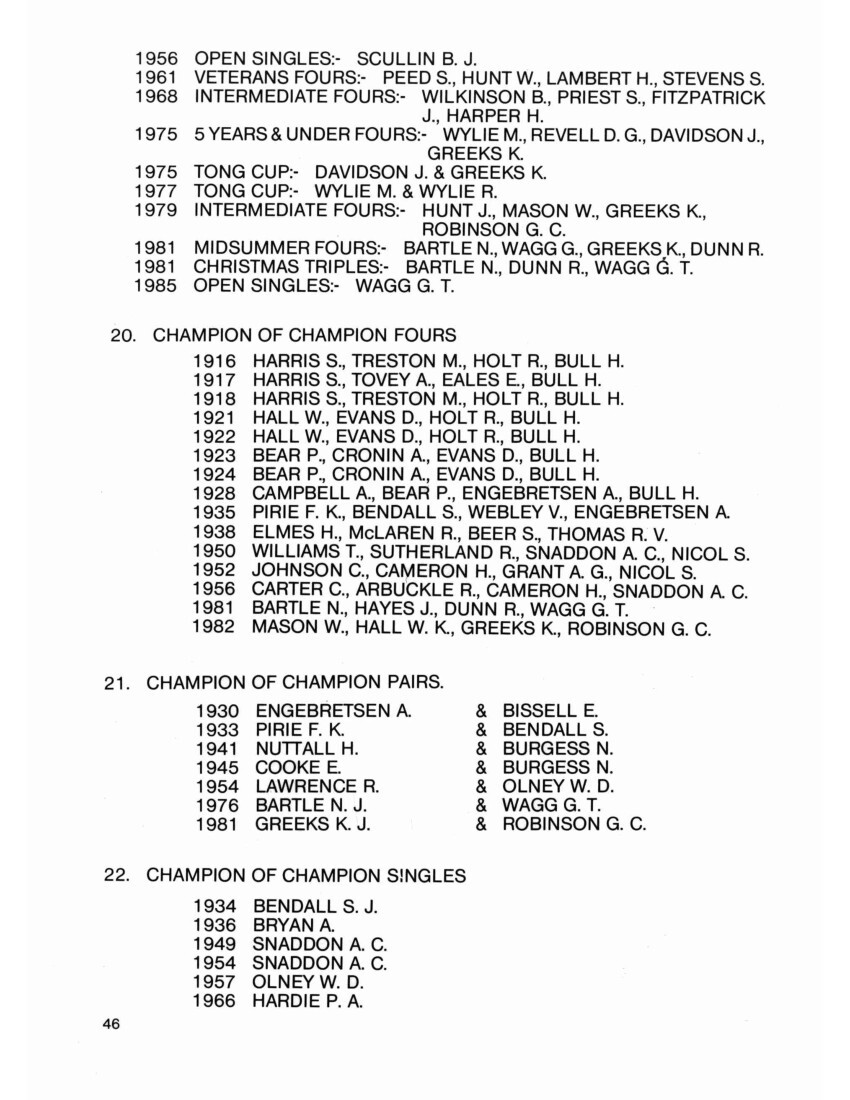
Page 47
23. JUNIOR CHAMPION OF CHAMPION SINGLES
1948 GRANT D.
1955 HEIBNER A. J.
1974 WAGG G. T.
24. COLTS CHAMPION OF CHAMPION SINGLES
1983 BRADLEY E.
CLUB TROPHIES BEING COMPETED FOR AS AT APRIL 1986
1 D.L.M. CHALLENGE BOWL Championship singles
2 G.H. COOKE MEMORIAL CUP Championship Pairs
3 KEN GREEKS CUP Open Triples
4 ARCHIE WALLACE MEMORIAL CUP Intermediate Singles
5 JUNIOR CUP (Presented By S.H. TUCK) Junior Singles
6 PERCY BEAR MEMORIAL TROPHY Junior Pairs
7 ANGUS HARDIE CUP Colts Singles
8 HUNT TROPHY Most Improved Player
9 FAULKNOR TROPHY Singles for the Player who has never won a club singles competition and who have reached the age of sixty
10 JIM HAYES SHEILD Drawn Fours for Winter Bowls
11 ALBERT WYETH ROSE BOWL Drawn Fours for Winter Bowls
12 HAROLD CARTER MEMORIAL CUP Drawn Mid-week Triples for Winter Bowls
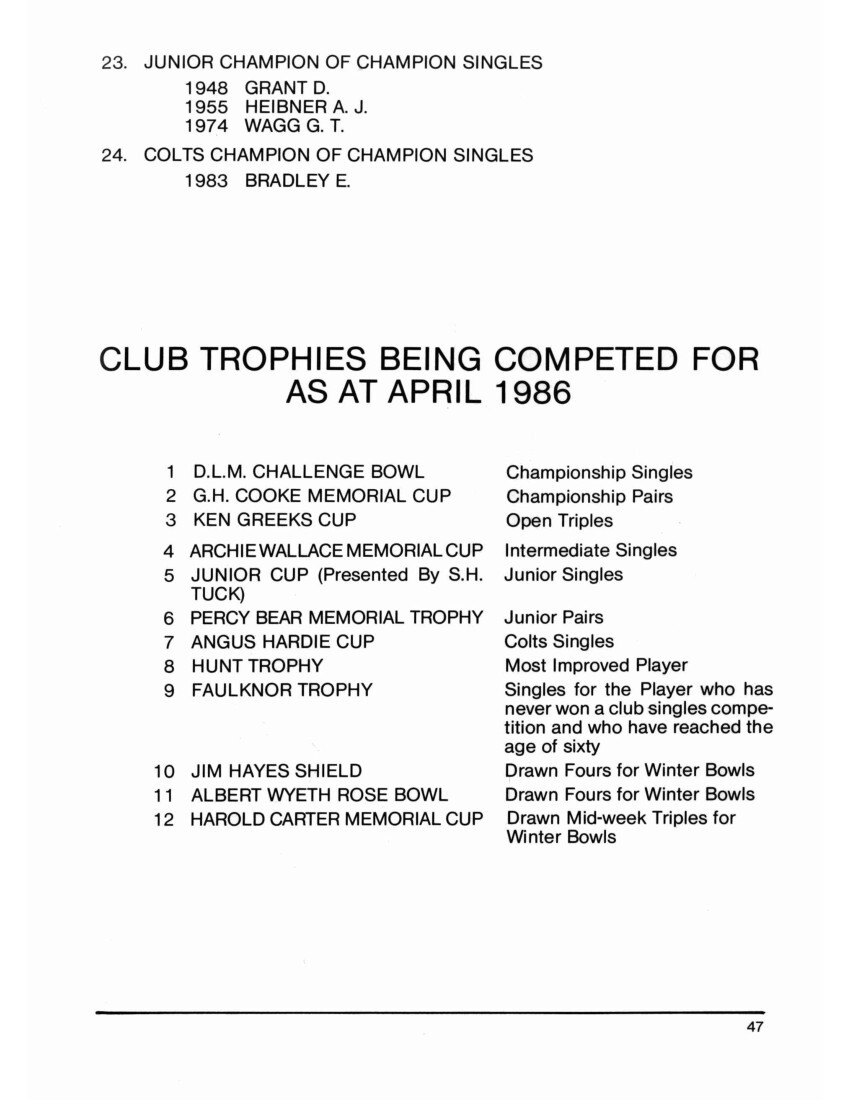
Page 48
INDEX
Alsop, A.S., 27, 30, 33.
Arbuckle, R., 25, 28, 30.
Asher, Rev. J.A., 10, 13.
Bailey, W., 16.
Balfour, T.W., 4, 6.
Bartle, N.J., 30, 33.
Bear, P.J., 13, 14, 17, 18, 19, 20, 21, 28.
Beattie, K., 34.
Beecham, K., 12.
Beer, S., 19.
Bendall, S., 19.
Benson, K., 12.
Bissell, J., 17, 18.
Boldt, E., 21.
Bradley, E., 34.
Brennan, P., 32, 34, 35.
Briasco, C., 16.
Bryan A., 21.
Bull, H., 10, 13, 14, 15, 16, 18, 28.
Burden, W.J., 13.
Burke, L.J., 26, 29.
Burton, E.W., 12.
Butler, E.N., 30.
Cameron, H., 23, 25.
Campbell, A.C., 17.
Carter, J., 16.
Chard, H., 34, 35.
Clay, Mrs. M., 28.
Cook, J.T.C., 3, 4.
Cooke, G.H., 20, 21.
Corne, J., 21, 22.
Corner, C., 23.
Cornford, H.C., 4.
Coyle, P., 34, 35.
Crawford, D.N., 30.
Cronin, A., 16.
Culliford, A., 25.
Culliford, Mrs. A., 24.
Cunningham, C., 16.
Daily, F., 16, 20.
Dinwiddie, J., 6.
Dinwiddie, P., 4.
Dunn, P.M., 27, 28.
Dunn, R.M., 30, 33.
Dyer, S.J. 12.
Eales, E., 14.
Esmes, H., 21.
Engebretsen, J.A., 18, 20, 21.
Evans, D.A., 16.
Faulknor, G.A., 2, 23, 25, 27, 28, 30, 31, 33.
Faulknor, T., 20.
Faulknor, T.F., 33.
Fielder, J.B., 8, 9, 14.
Findlay, C.S., 22, 34.
Fletcher, G.C., 11.
Flett, J., 2.
Fulford W., 25.
Gasson, J., 33.
Gilbert [Gilberd], J.G., 4.
Glasgow, Lord., 7.
Goodger, R.W., 21.
Grant, A.G., 23.
Greeks, K.C., 30, 33.
Griffen [Griffin], J., 12.
Guy, D., 4.
Haggerty, D., 23.
Hall, W.K., 27, 30, 33.
Hardie, H.A., 2, 22, 26, 28, 29, 31.
Harland, J.P., 22, 24, 26, 30.
Harper, H., 28.
Harper, W.S., 27.
Harris, S., 16.
Hayes, J., 32.
Hayward, Rev. R., 10.
Heibner, A.J., 25, 26.
Higgins, P.M., 31.
Hislop, W., 23.
Hitchings, Dr. T.H, 4, 7.
Hodgman, F., 29.
Hodgson, W., 11.
Holder, W.R., 17.
Hollay, A.E., 29.
Holt, J., 4.
Holt, R.,10, 11, 14.
Hunt, J.E., 34.
Johnson, C.F., 23.
Johnston, A.A., 34.
Lannie, L., 28, 33.
Lawrence, R., 25.
Letham, W., 13.
Lewis, R., 25.
Lopdell, C., 25, 26, 28.
Lowes, J., 25, 29.
Luke, Rev. C.L., 10.
Lusk, H.B., 16.
Luxford, S., 4.
Lyford [Lydford], W., 4.
McGill, R., 11.
McIntosh, S., 23, 24.
McLaren, R., 21.
McVay, J.C., 4.
McVicar, A., 16.
Mason, W.J., 31, 33.
Moore, Dr W.W., 12.
Morris, J.N., 30.
Morrison, T., 3.
Moult, W., 22.
Murphy, P.J., 26, 27.
Nicol, S., 22, 23.
Northcroft, E., 12.
Olney, W.D., 25.
Palmer, S., 4.
Pearse, S,G., 33, 34, 35.
Peed, S., 25.
Pirie, A.S., 21.
Pirie, A.W., 20, 21.
Pirie, F.K., (Jack), 19, 20, 21, 23.
Pirie, G., 21.
Pirie, S.F., 21.
Plested, C., 16.
Prian, G., 4.
Priest, S.G., 29
Quin, R., 12.
Reid, A., 28, 30.
Reid, R. 35.
Renouf, A., 17.
Revans, S., 4.
Ruscoe, G.M., 25, 28, 30.
Robinson. G.C., 33.
Schmoll, C., 16.
Scullin, B.J., 25.
Silk, B.G., 30, 32, 33.
Smart, P., 11.
Smith, J.P., 8, 10, 17.
Smith, R., 5.
Snaddon, A.C., 22, 23.
Spriggs, E.R., 20, 26.
Steele, G., 35.
Stone, W.J., 23.
Storkey, S.J., 16.
Stubbs, A., 4.
Sutherland, R., 23.
Swann, G.H., 4.
Sweetapple, 12.
Thomas, R., 21.
Thomson, A.L., 27, 28, 30.
Tiffen, H.S., 6.
Tovey, A.O., 14.
Treston, M., 11, 14.
Tutill, G., 9.
Vigor Brown, J. (MP), 13.
Wagg, G.T., 30, 31, 33.
Wallace, W., 34.
Ward, W., 9.
Wardell-Johnson, H., 17.
Williams, A.E., 13.
Williams, F.C., 12, 13, 16.
Williams, R., 4.
Williams, T.A., 22.
Williams, J.P., 10.
Woodcock, C., 16.
Woodhouse, A.J., 11.
Wrightson, A.E., 10, 12.
Wundrum, H.C.A., 5, 9.
Yates, W.C., 4, 12, 13.
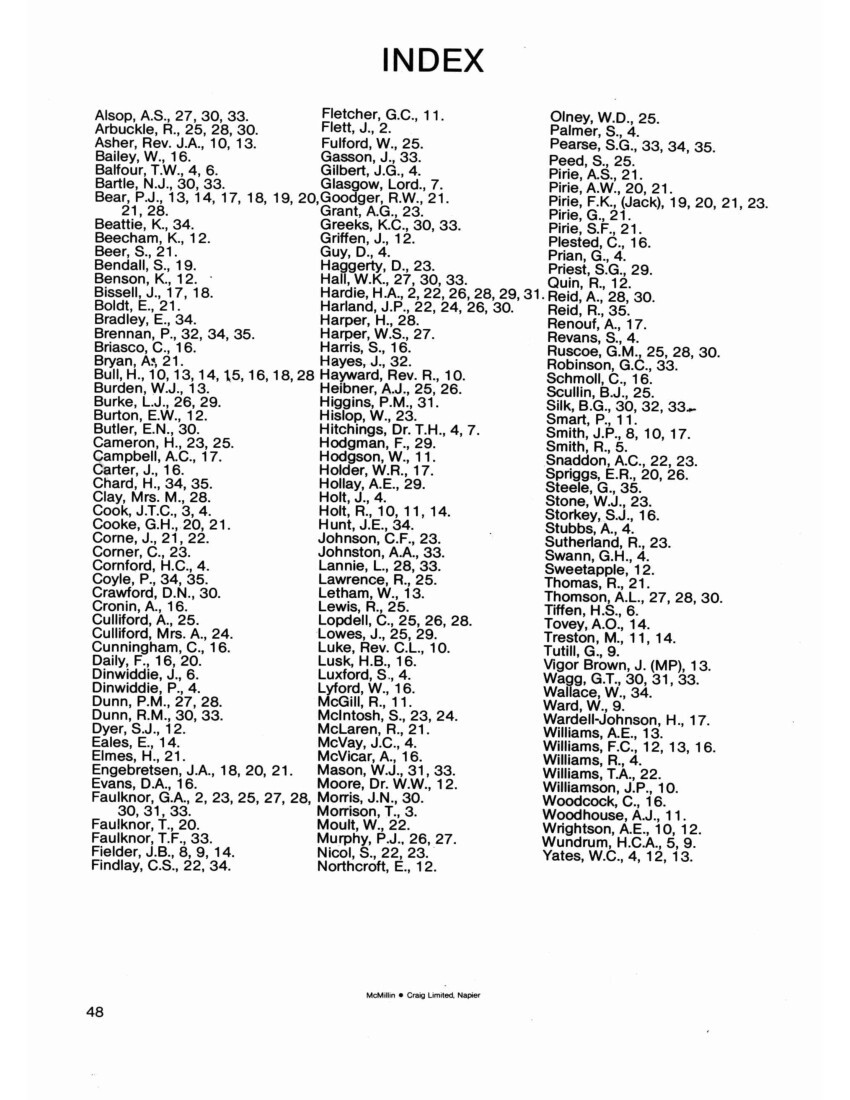
Non-commercial use

This work is licensed under a Attribution-NonCommercial 3.0 New Zealand (CC BY-NC 3.0 NZ).
Commercial Use
Please contact us for information about using this material commercially.Can you help?
The Hawke's Bay Knowledge Bank relies on donations to make this material available. Please consider making a donation towards preserving our local history.
Visit our donations page for more information.
Description
Surnames in this book –
Alsop, Anderson, Andrew, Arbuckle, Asher, Ashton, Atley, Badley, Bagley, Bailey, Balfour, Barry, Bartle, Beach, Bear, Beatson, Beattie, Beddows, Beecham, Beer, Bendall, Benson, Benson, Betchley, Bissell, Blakie, Boldt, Bradley, Bracken, Beach, Bick, Bradley, Brennan, Briasco, Broadhead, Brown, Bryan, Bull, Burden, Burgess, Burke, Burns, Burton, Butler, Cameron, Campbell, Carter, Cater, Chard, Chesney, Clay, Cook, Cooke, Corne, Corner, Cornford, Coyle, Crawford, Cronin, Culliford, Culliford, Cunningham, Daily, Davidson, Dean, Dick, Dinwiddie, Dinwiddie, Dunn, Dyer, Eales, Edwards, Elmes, Esmes, Engebretsen, Evans, Exeter, Faulknor, Fielder, Finch, Findlay, Fitzpatrick, Fletcher, Flett, Flynn, Franklin, Frude, Fulford, Gardner, Garnham, Gasson, Gebbie, Gilberd, Glasgow, Goodger, Grant, Greeks, Griffin, Guy, Haggerty, Hall, Hardie, Hannan, Harland, Harper, Harris, Hayes, Hayward, Hawke, Head, Heibner, Higgins, Hislop, Hitchings, Hodgman, Hodgson, Hodman, Holder, Hollay, Holt, Holt, Howell, Howes, Hunt, Hunter, Ivey, Jamieson, Johnson, Johnston, Lambert, Lampitt, Lannie, Lawrence, Lawrie, Letham, Lewis, Lezard, Lightbrand, Lopdell, Lowes, Luke, Lusk, Luxford, Lydford, Lyndon, Kilpatrick, Mason, Mayo, McGhee, McGill, McGlashan, McIntosh, McLaren, McNiven, McVay, McVicar, Mason, Miller, Moeller, Moore, Morris, Morrison, Moult, Murphy, Newton, Nicol, Nicholson, Northcroft, Nuttall, O’Brien, Olney, Osborne, O’Shaughnessy, Palmer, Peace, Pearse, Peed, Peel, Pirie, Plested, Poynter, Prian, Priest, Proffitt, Quin, Quirk, Rapsey, Reid, Reid, Renouf, Renton, Revans, Revell, Rigg, Robb, Robinson, Runciman, Ruscoe, Sage, Scholes, Schmoll, Scullin, Seaton, Shirley, Silk, Smart, Smith, Smith, Snaddon, Snow, South, Spriggs, Stedman, Steele, Stevens, Stone, Storkey, Stubbs, Sutherland, Swann, Sweetapple, Tattle, Terry, Thomas, Thomson, Thorp, Tiffen, Todd, Tovey, Treston, Truda, Tuck, Tutill, Wagg, Wallace, Ward, Wardell-Johnson, Watkins, Watts, Webley, West, Widerstrom, Wigg, Williams, Williamson, Willis, Wilkinson, Wilson, Woodcock, Woodhouse, Wrightson, Wundrum, Wyeth, Wylie, Yates, Zorn
Business / Organisation
Napier Bowling ClubFormat of the original
Book paperbackCreator / Author
- D G Revell

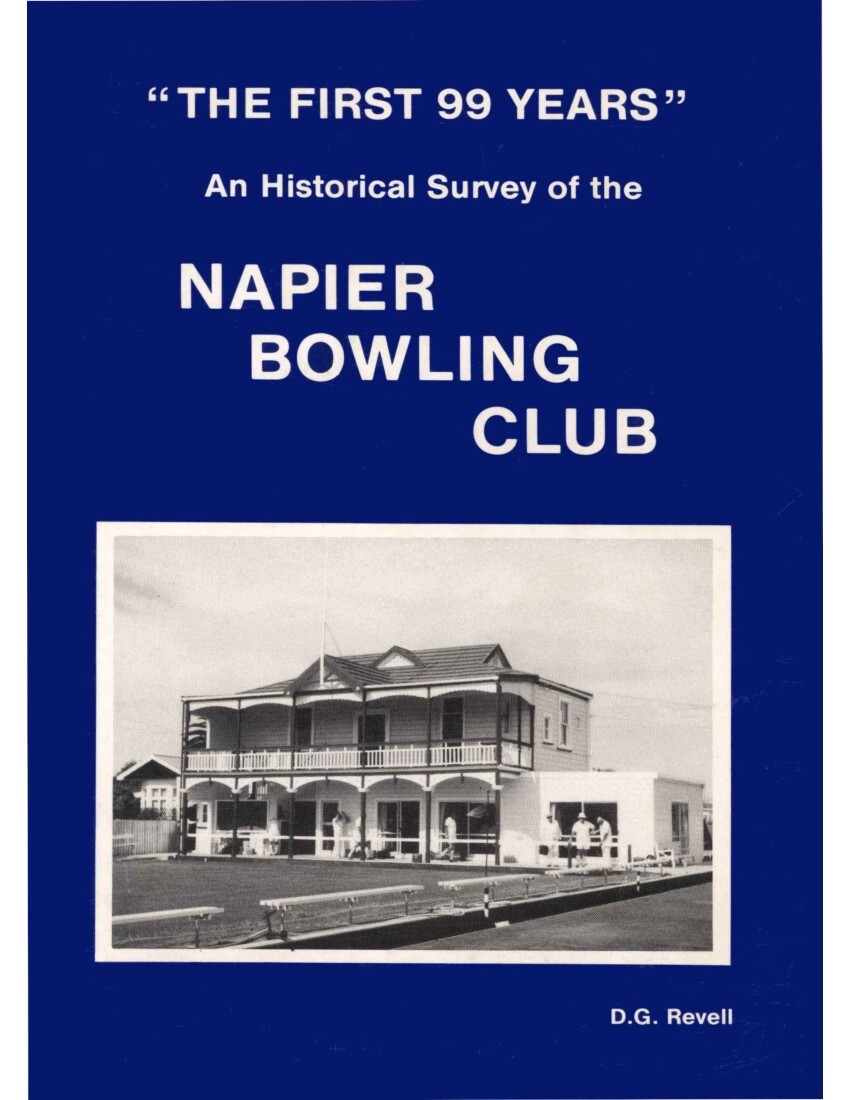









Do you know something about this record?
Please note we cannot verify the accuracy of any information posted by the community.